Five ‘A’s’ but 17 ‘F’s’ in Annual Packers Grades
GREEN BAY, Wis. – Five Green Bay Packers players, ranging from quarterback Aaron Rodgers to offensive lineman Yosh Nijman, were awarded “A” grades in Packer Central’s annual series of report cards.
Our grades are based on a player’s impact relative to the salary cap. That’s because the cap is such a big part of building a roster. Not only must a team’s high-priced players deliver but it must have some of its less-expensive players outperform their contracts.
Generally, the Packers got high marks from both groups in posting their third consecutive 13-win season. That wasn’t universal, though. Partially because of injuries sidelining several high-priced players for huge chunks of the season, we awarded “F” grades to 17 players.
The Packers have three marquee players scheduled to be unrestricted free agents: receiver Davante Adams, linebacker De’Vondre Campbell and cornerback Rasul Douglas. They were awarded “A-plus” grades.
In case you missed a group or two in our 11-story series, here are our annual grades all in one place.
All salary data is from OverTheCap.com. Analytical stats are from Pro Football Focus, Sports Info Solutions and the NFL.
Grading the Quarterbacks
Aaron Rodgers ($27.53 million cap charge; ranking No. 3 among quarterbacks)
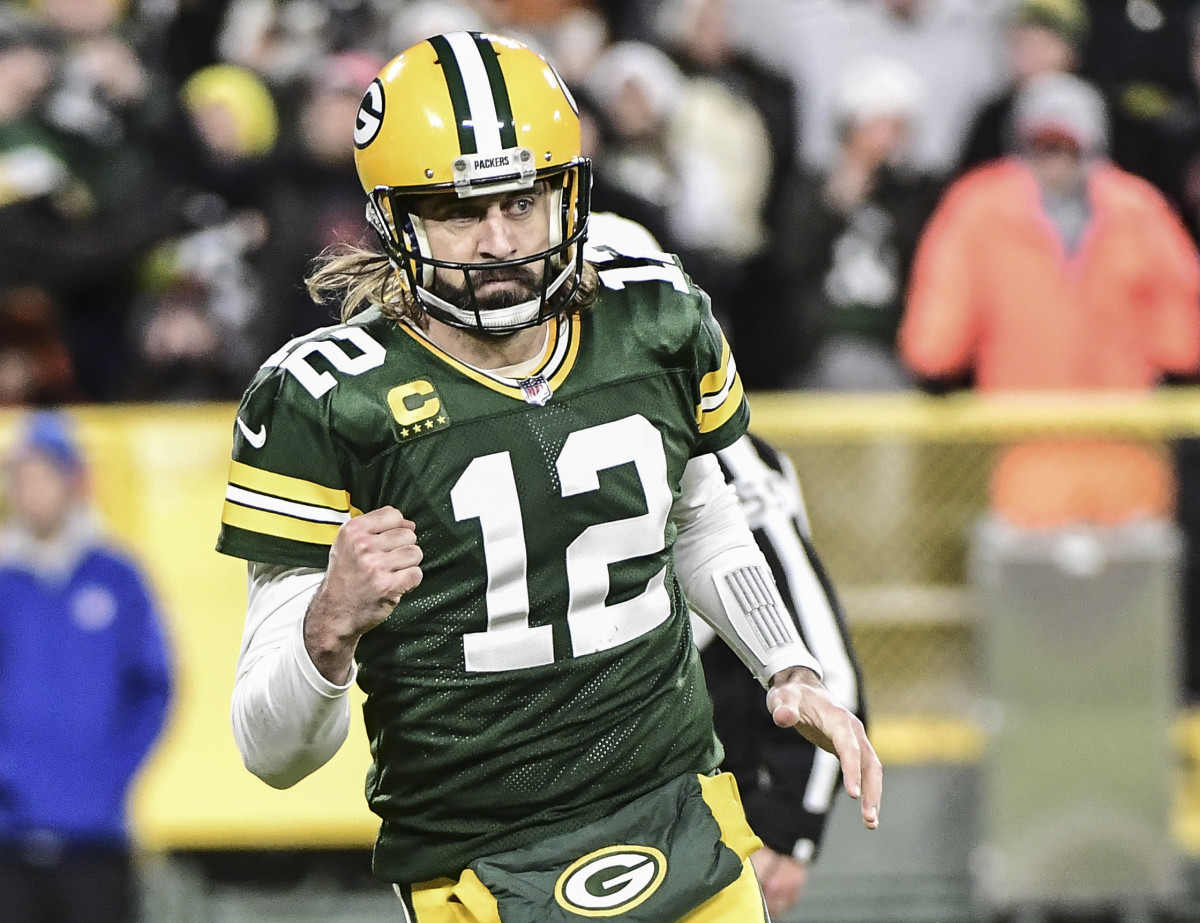
The restructured contract that was part of Rodgers’ return to the team made him a huge bargain. The two quarterbacks with a higher cap charge, Seattle’s Russell Wilson and Minnesota’s Kirk Cousins, and the quarterback right below him, Atlanta’s Matt Ryan, failed to even post a winning record.
Rodgers is likely to win his fourth MVP, an unlikely accomplishment in light of how he infuriated so many media members with his stance on COVID. In the Super Bowl era, there have been only five seasons in which a quarterback ranked No. 1 in passer rating, touchdown percentage and interception percentage. Rodgers did it 2020 and again in 2021.
On the same page as coach Matt LaFleur and sharing the same brain as Davante Adams, Green Bay’s passing game was superb during the second half of the season. He finished the season with 37 touchdowns vs. four interceptions – including 37 touchdowns vs. two picks after Week 1. He finished fourth in YAC per completion, a byproduct of his accuracy putting his receivers in position to turn something into something more.
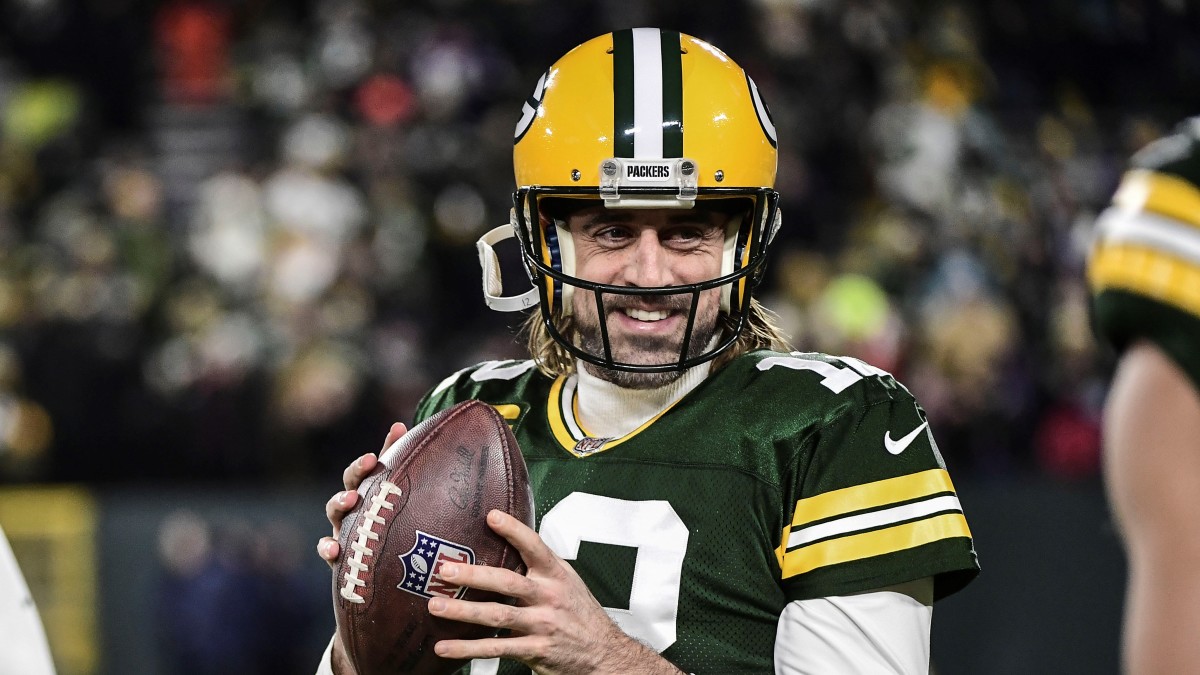
However, what happened in the playoffs can't be ignored. Since winning the Super Bowl in 2010, Rodgers is 7-9 in playoff games. He has lost four NFC Championship Games. Three times, he lost in overtime. Five times, he lost on the final play of the game. Six times, the defense allowed more than 30 points.
While the special teams stunk, the divisional-round loss to San Francisco falls on his shoulders for wasting a superb performance by the defense. Nonetheless, the Packers want him back for the long haul. Green Bay’s status as a championship contender in 2022 will depend on it.
“I think the older you get, the smarter you have to get in a number of different areas,” Rodgers said late in the season when asked to compare a potential 2021 MVP with his first MVP season of 2011. “Obviously, the experience gives you a lot of banked memories you can draw from, but physically, just from a physical standpoint, I probably weighed between 225 and 230 the majority of the season in 2011, and I’ve been between 215 and 220 in the majority of this season, so that 10 pounds has made a big difference for me. It’s allowed me to still move in the pocket, to still keep legs.”
Grade: A-minus.
Jordan Love ($2.81 million cap charge; ranking No. 40 among quarterbacks)
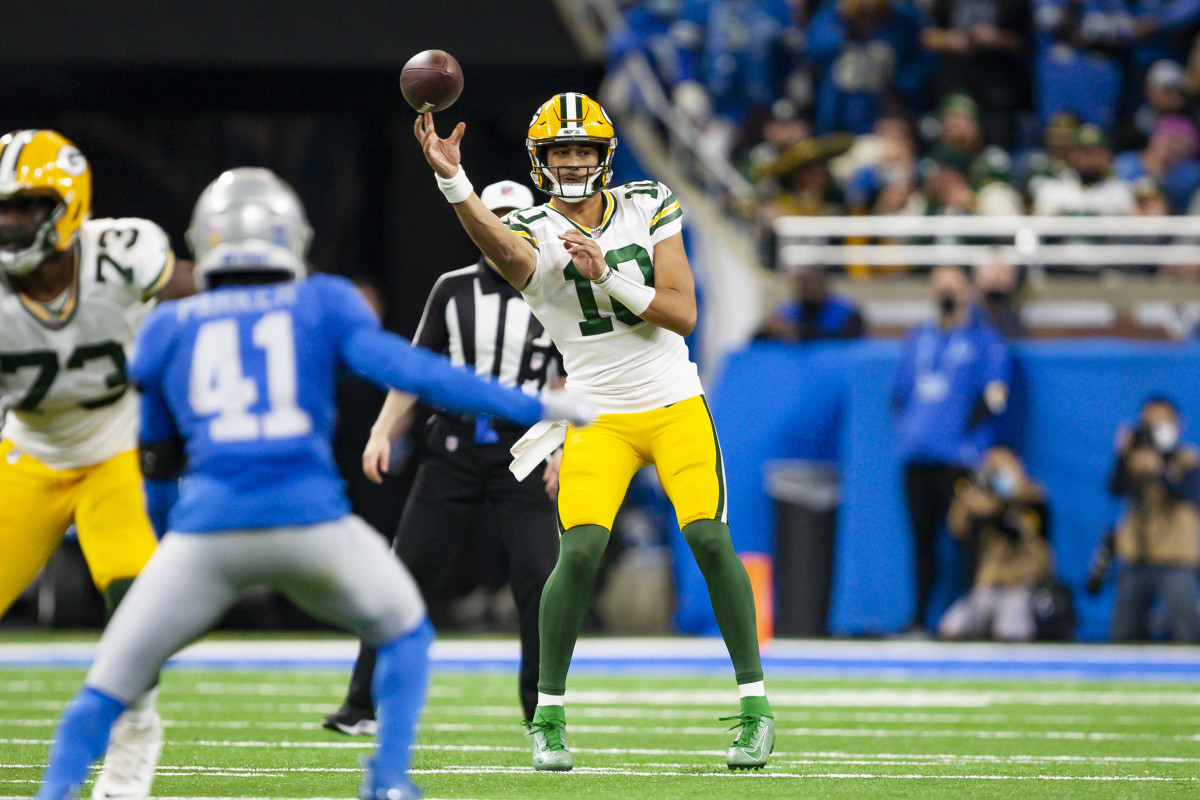
Getting his first real playing time, Love did nothing to provide confidence that he could possibly be the winning successor to Rodgers. The Packers lost four games during the regular season; Love had a hand in two.
Starting against Kansas City and playing the second half against Detroit, Love completed 58.1 percent of his passes with two touchdowns, three interceptions and a 68.7 passer rating. Of the 50 quarterbacks with at least Love’s 62 attempts, he ranked 46th in passer rating, 44th in completion percentage and 47th in interception percentage. He threw only one fewer interception than Rodgers despite throwing 469 fewer passes. That will never be winning football.
“The same it is for every other guy. You’ve got to come back to be the best version of yourself,” LaFleur said of his offseason message for Love. “I think Jordan’s come a long way. I still think, with any young player that hasn’t gotten maybe the experience up to this point, there’s still a lot of room for growth. It’s going to be an important offseason. When he does come back, it’s making sure that his footwork is sharp, that he’s on the details of what we’re trying to accomplish on each and every play and all the concepts, really a mastery of the offense, and just the command that he has. I know he takes that to heart and he takes it very personally and he’ll do whatever he can to be his best.”
Grade: F.
Kurt Benkert ($193,067 cap charge; ranking No. 93 among quarterbacks)
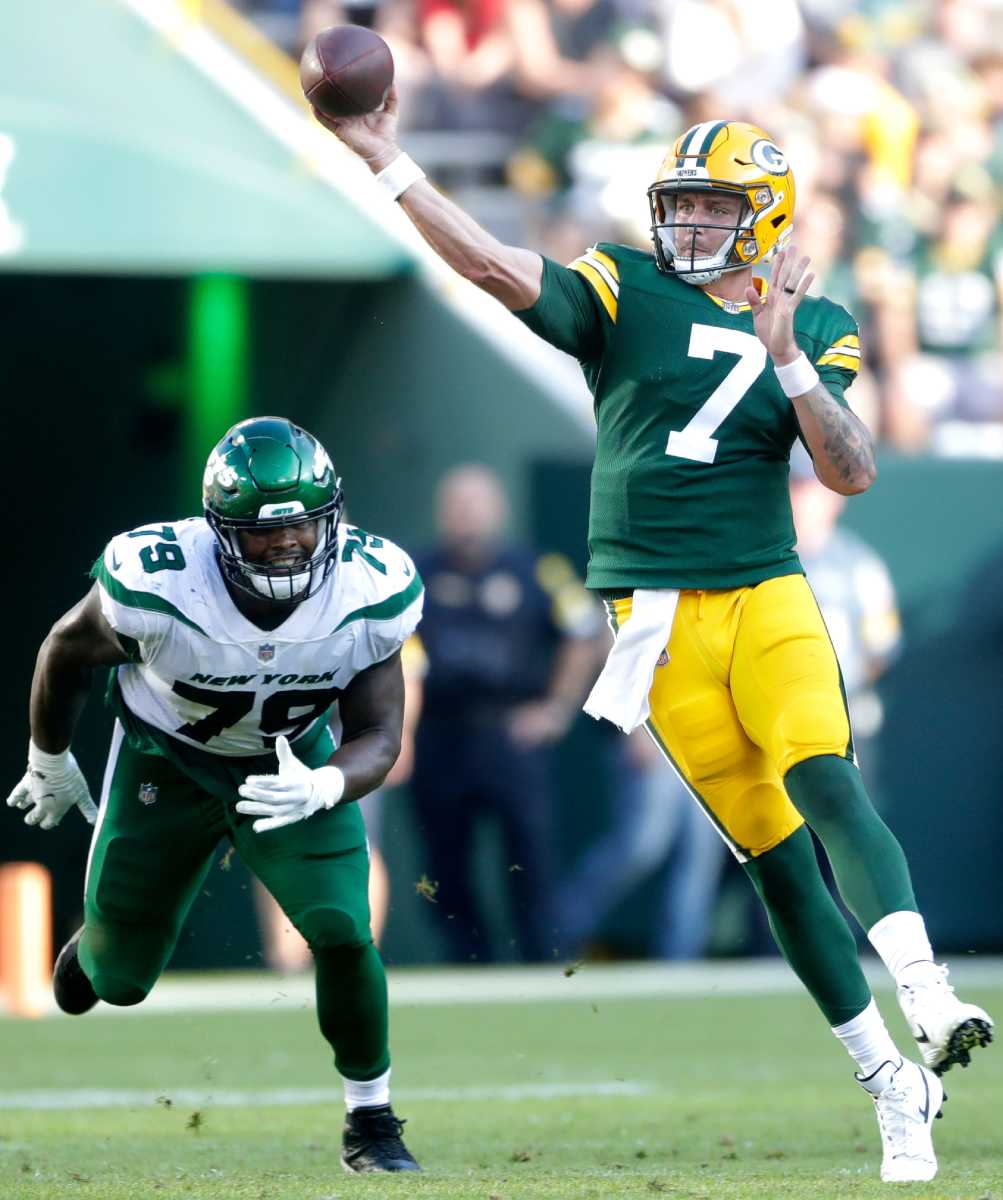
Benkert spent most of the season on the practice squad but took a knee for two snaps at the end of the Dec. 12 rout of the Chicago Bears. Obviously, with Rodgers and Love, Benkert wasn’t going to play. Nonetheless, he was a nice story this year. When Benkert ran out of the tunnel for that game, it marked his first real game in 1,445 days dating to the Military Bowl that capped Virginia’s 2017 season. He originally signed in May and outlasted veteran Blake Bortles. This summer, he’ll have to beat out Danny Etling to stay on the roster.
“There’s so many little things in your game that you can improve on,” Benkert said before the Chicago game. “Even a guy like Aaron, he’s been in the league for 17 years, he still corrects himself on things and goes out with a purpose and has a few things he wants to work on. For me, I got a long ways to go. Behind the scenes, that’s my only job really is the little things. I try to just knock a little bit out a time and that kind of keeps me going.”
Grade: Incomplete.
Grading the Receivers
Davante Adams ($16.78 million cap charge; ranking No. 3 among WRs)
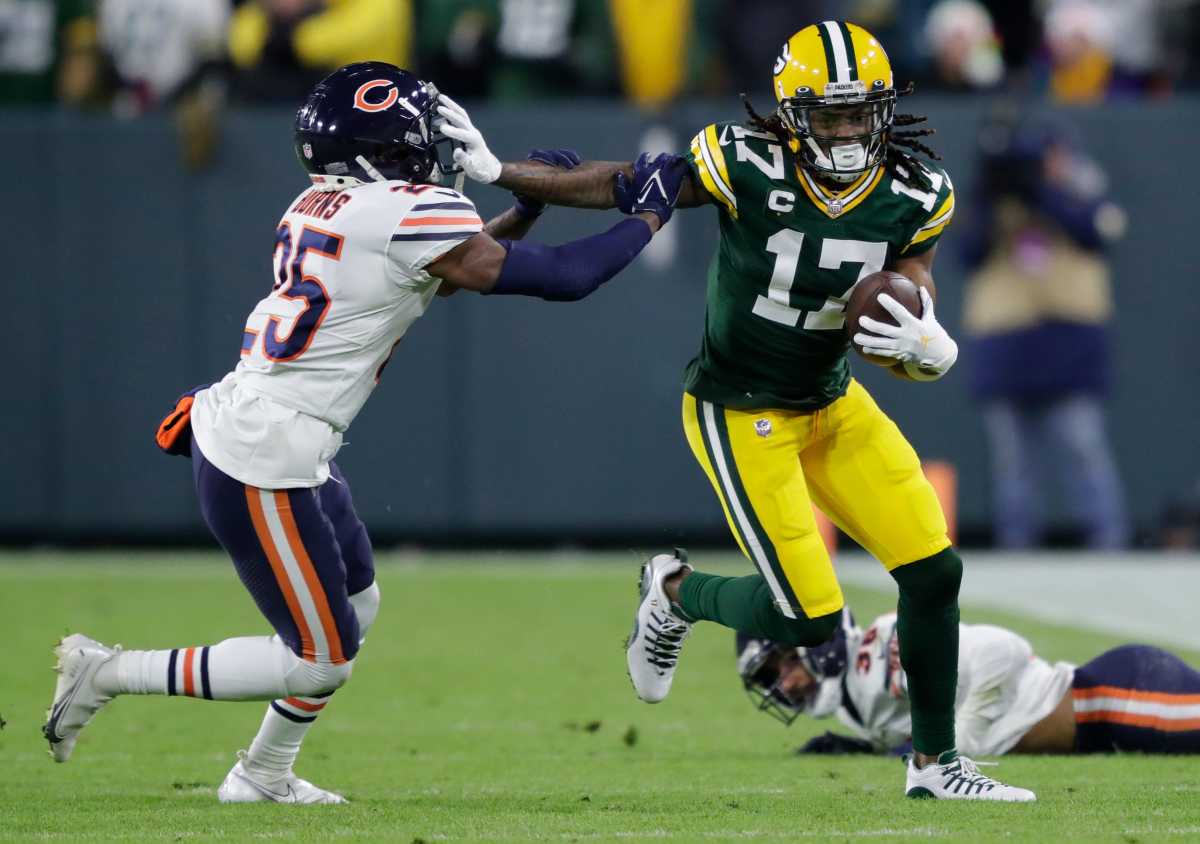
Adams is a face-of-the-franchise type of player. In a perfect world, you want your absolute best players to dominate with production, lead with presence and generally do everything on and off the field the right way. That’s Adams.
Adams set franchise records with 123 receptions for 1,553 yards (12.6 average). Eight of his 11 touchdowns came during the final seven games, when the offense really took off. Everyone in the stadium knew where Aaron Rodgers wanted to fire the football and it usually didn’t matter. Rodgers can make any receiver look good, it’s true, but Adams can make any quarterback look good. When you combine a great quarterback and a great receiver with great chemistry, you get what you saw week after week after week.
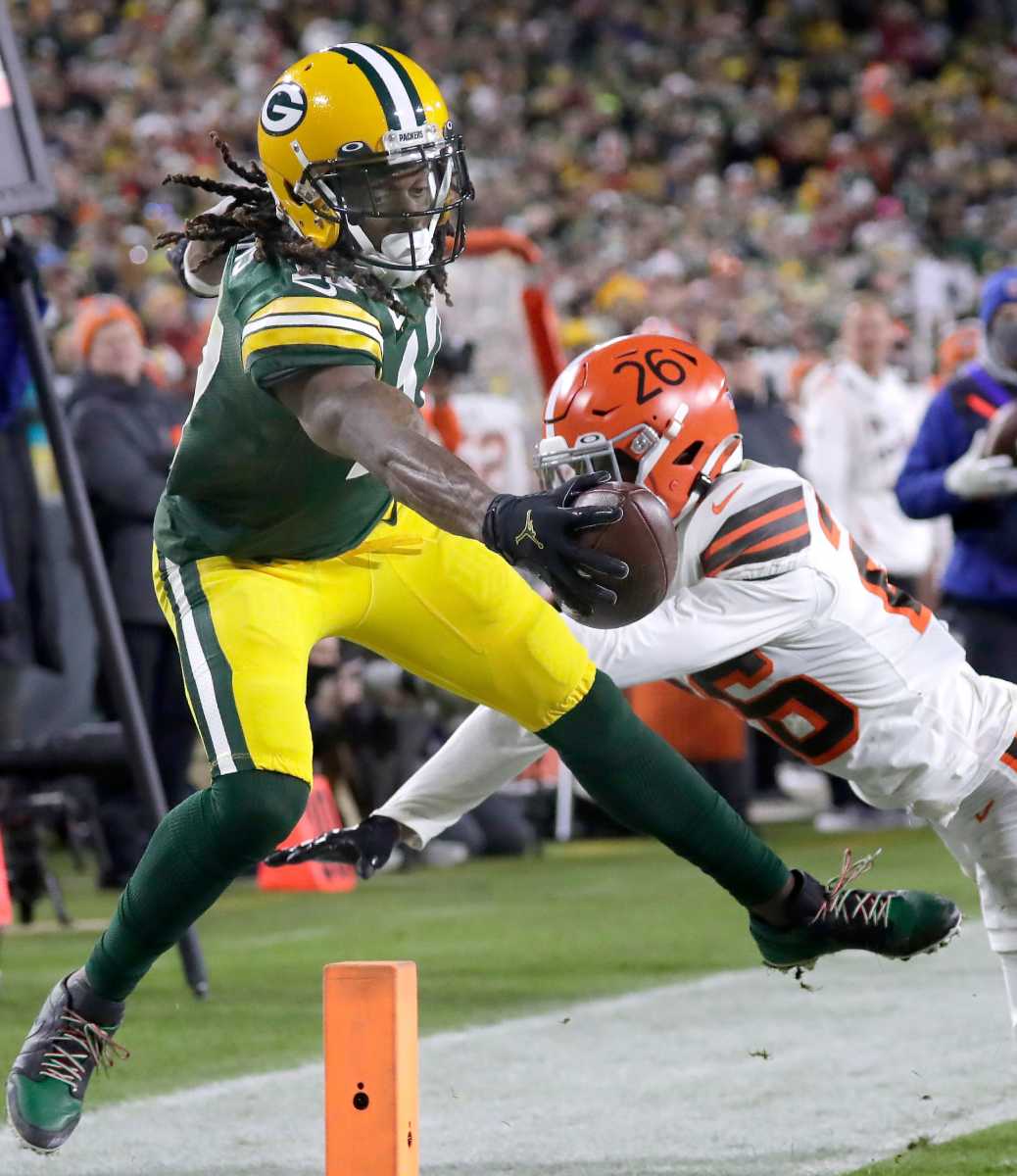
According to Pro Football Focus, 91 receivers were targeted at least 49 times. Adams ranked 13th in catch rate, third in yards per route (2.92), 18th in drop rate (four drops; 3.1 percent) and 15th in passer rating (114.5). Adams wanted to be more of a force after the catch, so he forced 13 missed tackles compared to only four in 2020 and 15 the previous three seasons combined. He also tied for fifth with 12 receptions on passes thrown 20-plus yards downfield.
Adams is scheduled to be a free agent. If he hits the market, he’ll be the No. 1 available player. Arizona’s De’Andre Hopkins is the highest paid receiver with an average salary of $27.25 million. It’s an outlier contract. Tennessee’s Julio Jones is a distant second with a $22 million average, and only Hopkins, Jones, the Chargers’ Keenan Allen and Dallas’ Amari Cooper average $20 million per season. Moreover, Adams will turn 30 on Christmas Eve. Still, it is the priceless connection between Rodgers and the indomitable Adams that makes the offense go.
Grade: A-plus.
Randall Cobb ($2.69 million cap charge; ranking No. 57 among WRs)
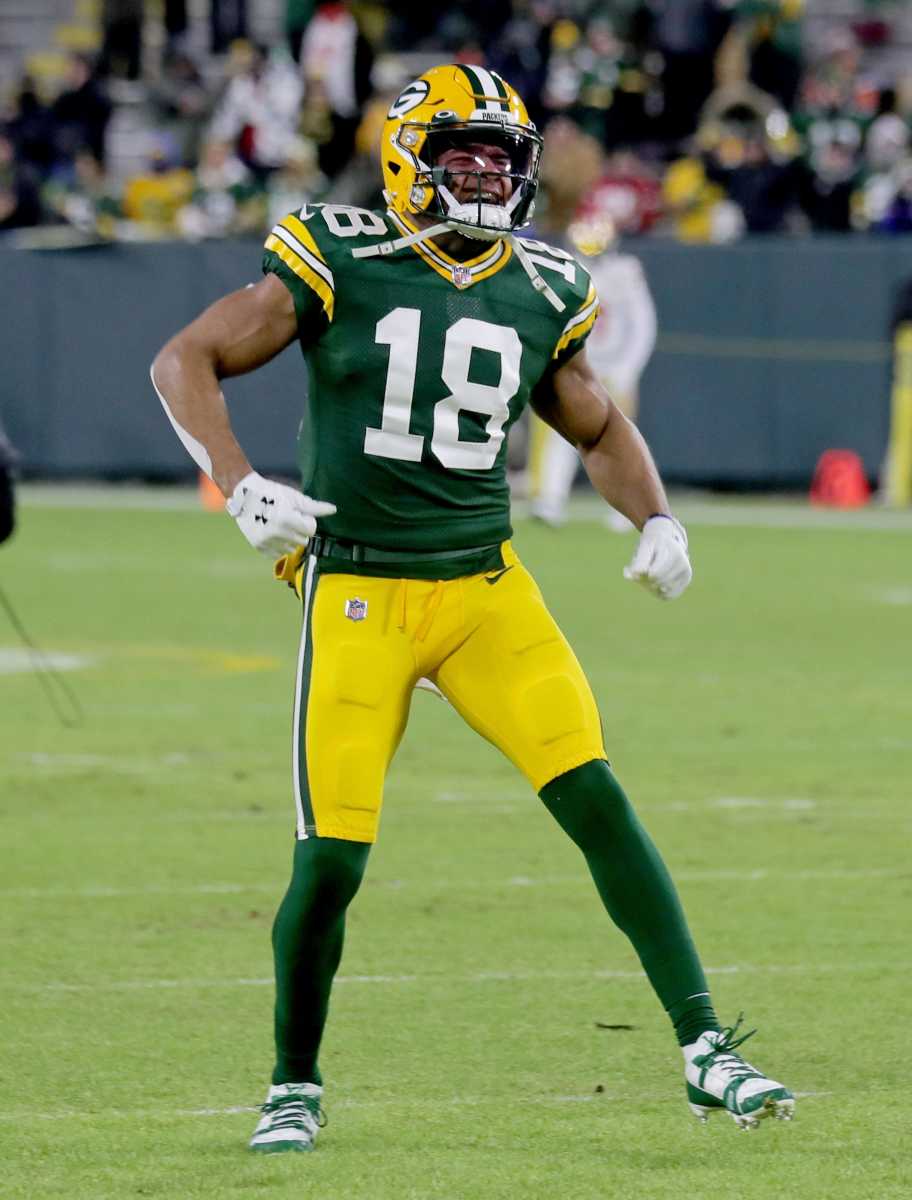
Cobb was brought back at the urging of Aaron Rodgers. He caught 28-of-39 targets (71.8 percent) for 375 yards (13.4 average) and five touchdowns.
In the grand scheme of things, he wasn’t worth the money – and certainly won’t be worth the money next year, when his cap number soars to $9.5 million. But he did deliver when needed and showed he can still play. He had two-touchdown games against Pittsburgh and Arizona, and he was a huge part of the offense in a key win over the Rams before suffering a core-muscle injury that sidelined him for the final six games. He was as fired up as anyone at Lambeau Field when he returned for the playoff game, then inexplicably wasn’t targeted by Rodgers until the final minutes.
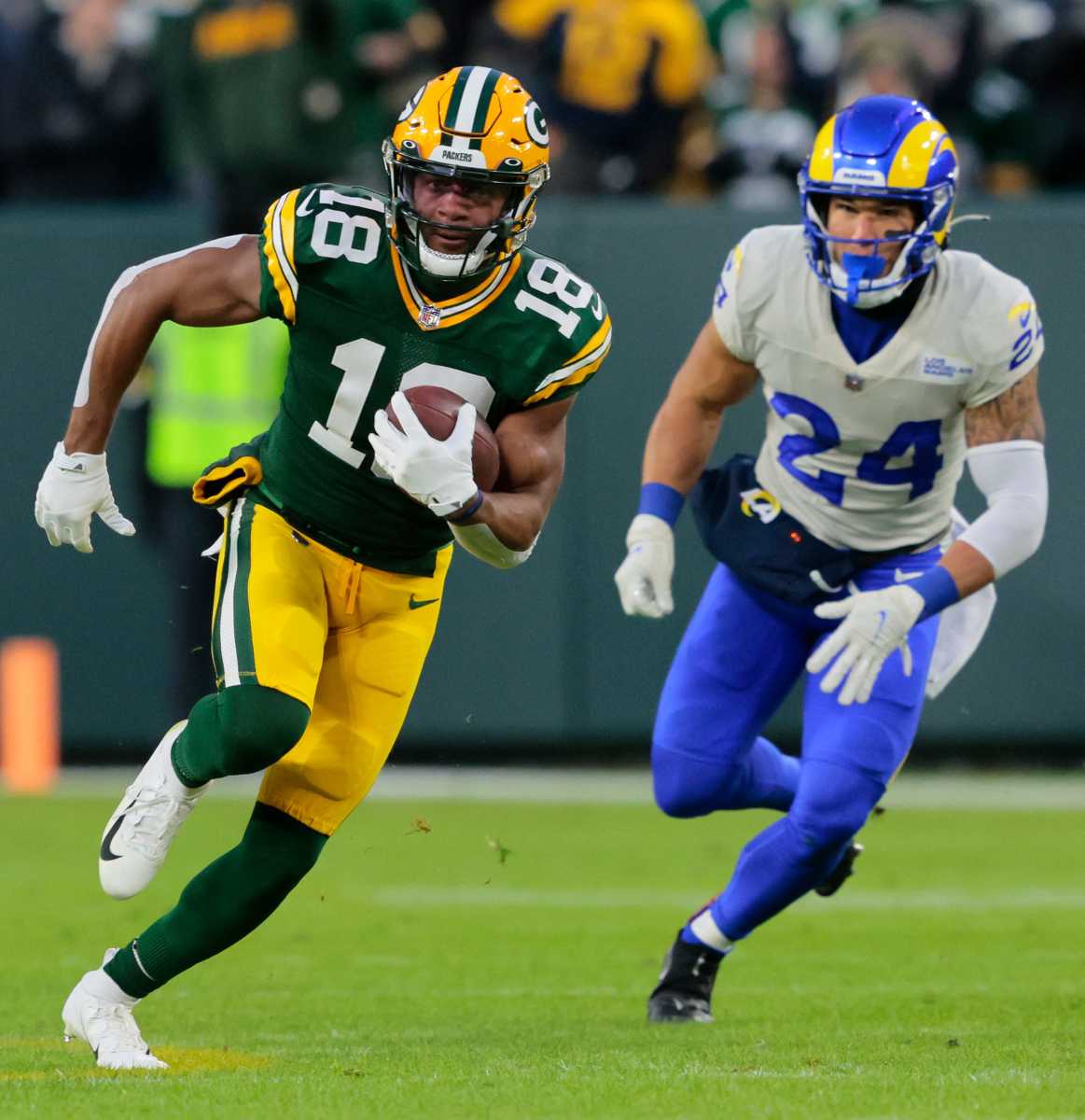
Cobb had zero drops, trailed only Adams in yards per pass route (1.49) and had the best passer rating when targeted (144.2). He’ll turn 32 during training camp. The Packers can save almost $6.75 million by moving on and giving Amari Rodgers a shot in the slot.
Grade: C.
Marquez Valdes-Scantling ($2.24 million cap charge; ranking No. 66 among WRs)
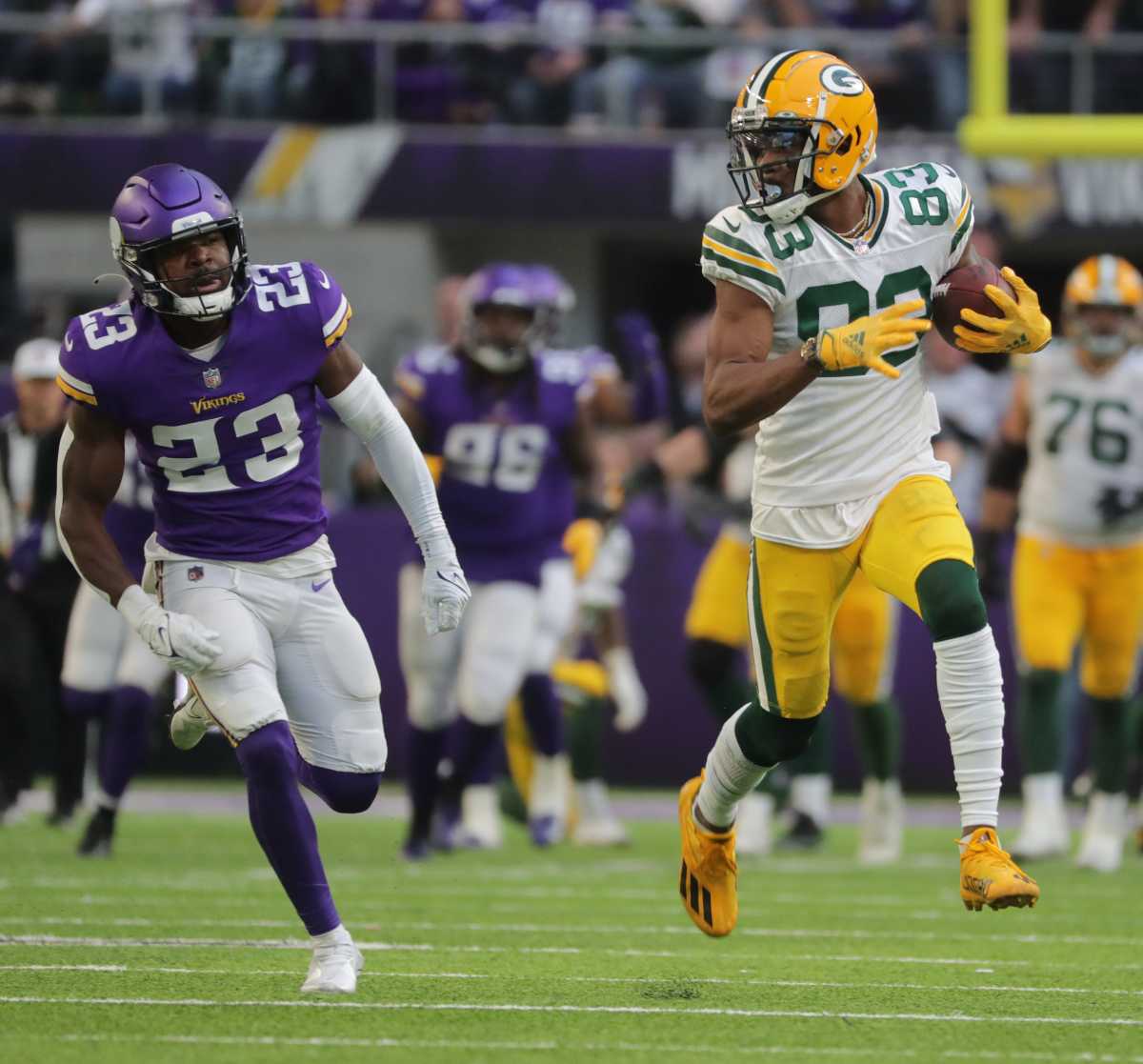
As a fifth-round pick in 2018 who hit certain playing-time requirements, Valdes-Scantling got a nice bump in salary (to $2.183 million) as part of the NFL’s proven-performance escalator. After leading the NFL with a 20.9-yard average in 2020 and a big-time training camp this summer, expectations were high entering the season. Limited to 11 games (seven starts) by injuries, he caught 26-of-55 passes (47.3 percent) for 430 yards (16.5 average) and three touchdowns. According to PFF, he had zero drops but also didn’t break any tackles.
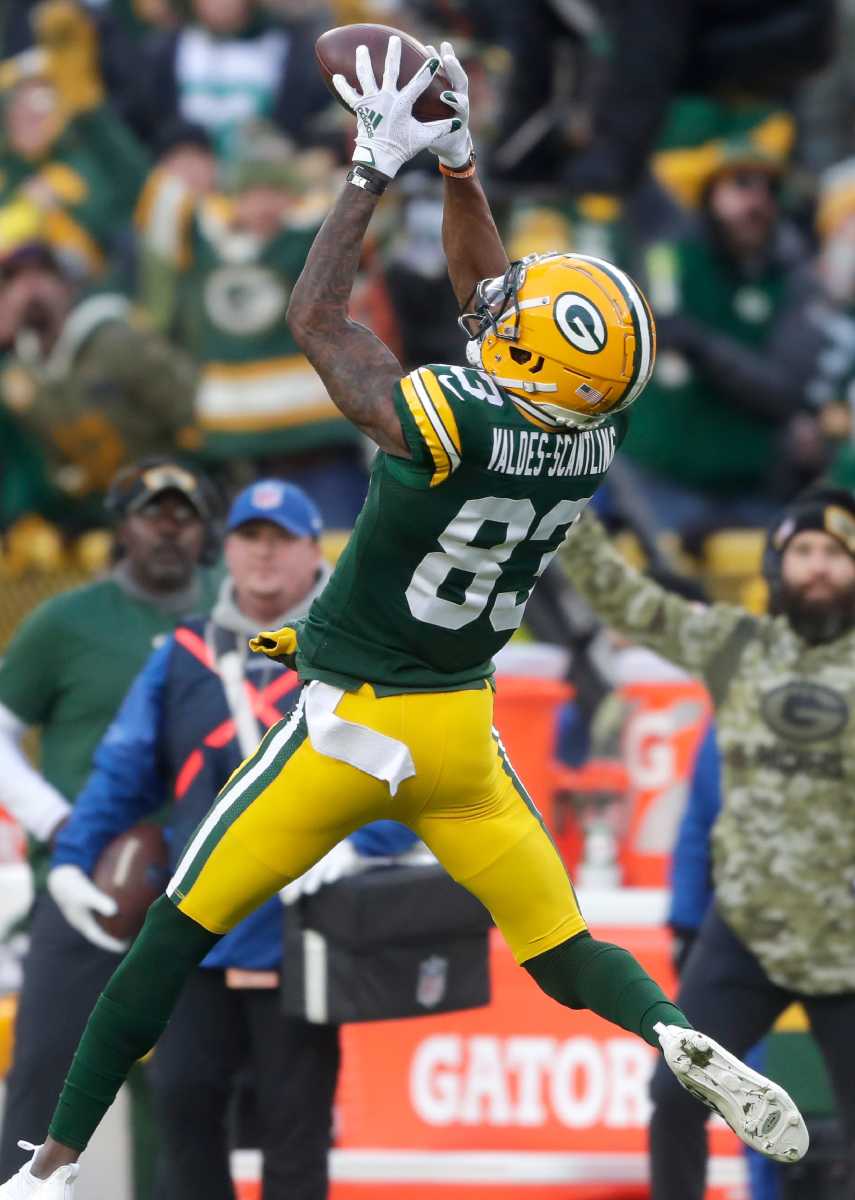
With elite size and speed, Valdes-Scantling’s niche is as a deep threat. On passes thrown 20-plus yards downfield, he caught only 6-of-22 (27.3 percent) with one touchdown this season compared to 9-of-30 (30.0 percent) and five touchdowns last season, according to PFF. Aaron Rodgers never quite got dialed in to MVS’s game-breaking speed.
Valdes-Scantling faces an interesting free agency. He is a proven deep threat. He cut his drops from seven to zero. And, until missing six games this season (plus the playoff game), he had never missed a game in his career. But it’s a what-have-you-done-for-me-lately league. Finishing 83rd among receivers in yards isn't the ideal way in which to hit the open market.
Grade: C-minus.
Amari Rodgers ($890,891 cap charge; ranking No. 127 among WRs)
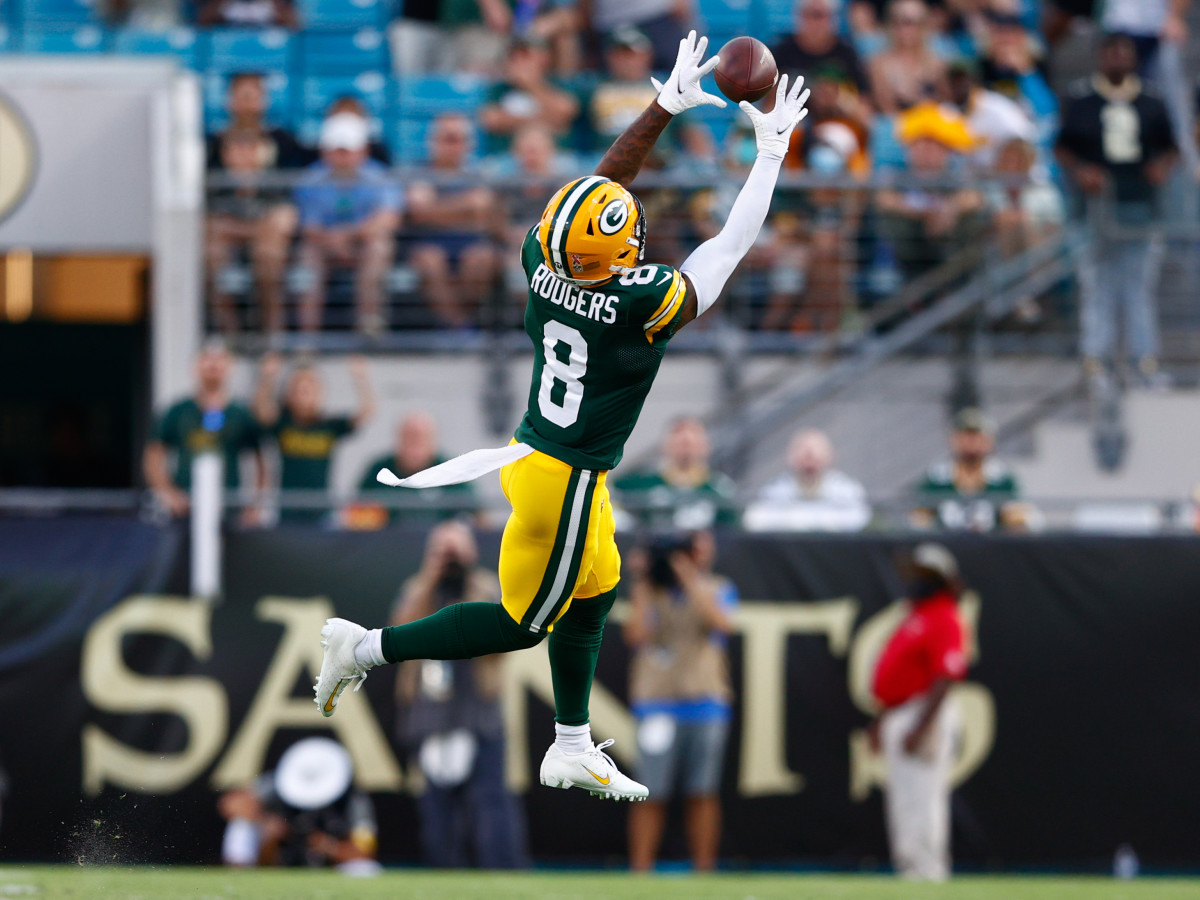
A third-round pick out of Clemson, Rodgers came with some impressive credentials. He was ultra-productive at a national powerhouse, Clemson. His father is Tee Martin, the Tennessee football legend and Ravens receivers coach. He was mentored as a kid by Cobb. His rookie season, though, was not very good.
On offense, he was shoved to the back burner because of the return of Cobb. He caught 4-of-8 passes for 45 yards (11.3 average) with zero touchdowns and one drop. On special teams, he averaged 8.3 yards per punt return and 18.1 yards per kickoff return. On punt returns, simply catching the ball was an adventure at times, though he got better in that phase at the end of the season and wound up with seven returns of 15-plus yards. A make-or-break offseason could await.
Grade: D-minus.
Allen Lazard ($850,000 cap charge; ranking No. 138 among WRs)
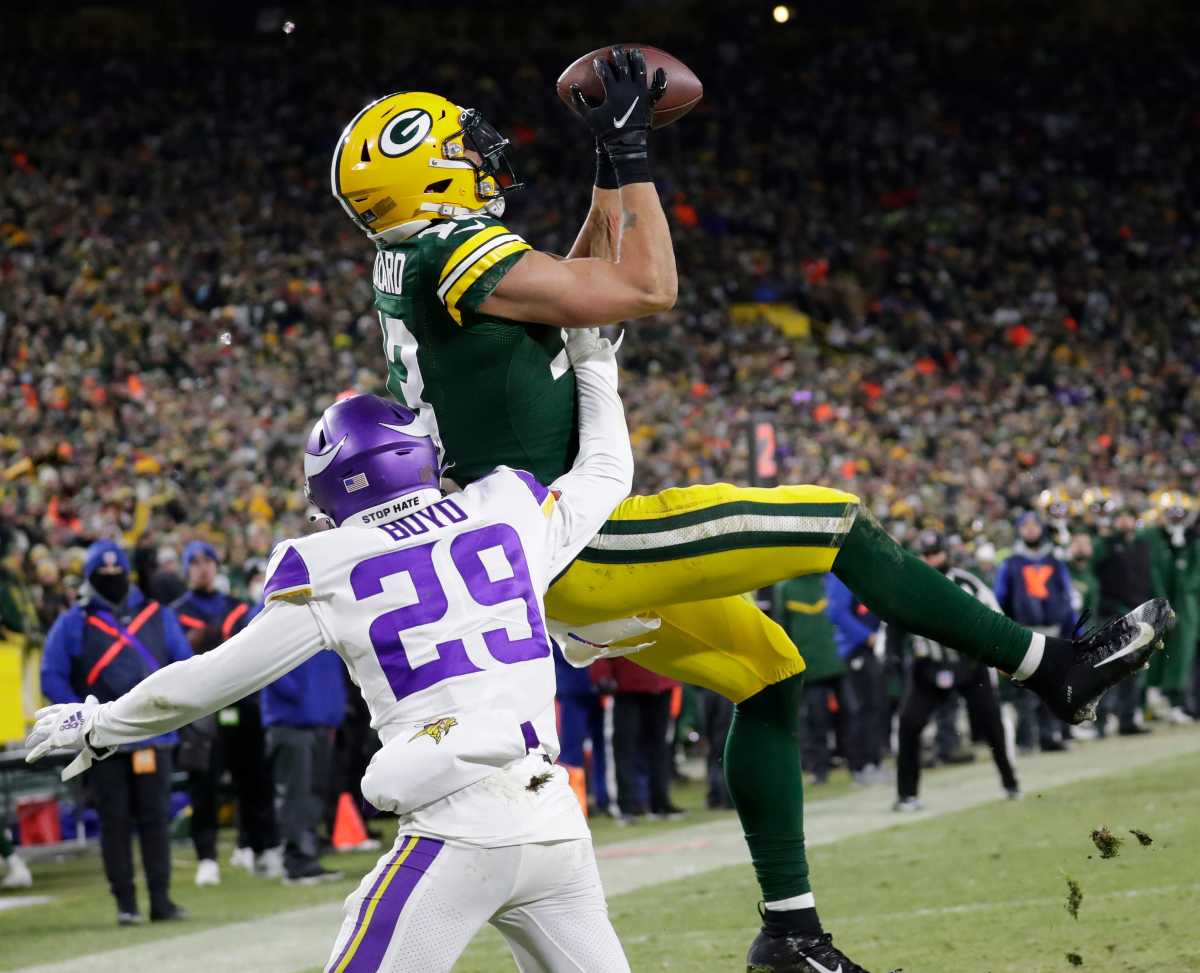
Lazard is coming off the best season of his career. He caught 40-of-60 passes (66.7 percent) for 513 yards (12.8 average) and eight touchdowns. The catches, yards and touchdowns all set career highs. He finished the season with a flourish. In the first 11 games, he had only one game of more than three catches. In the final six games, he had five-plus receptions for 70-plus yards three times. His five touchdown catches over the final five games were surpassed league-wide only by Adams.
Lazard is renowned for doing the dirty work. Defenders are so wary of his blocking that they can get blown by in the deep game. He caught 5-of-10 passes thrown 20-plus yards downfield, according to PFF. That was only one less reception than Valdes-Scantling while getting a dozen fewer deep targets. He did have three drops, giving him a drop rate of 7.0 percent that was the worst among the Big 4 receivers but not all that far off the league median of 5.4 percent.
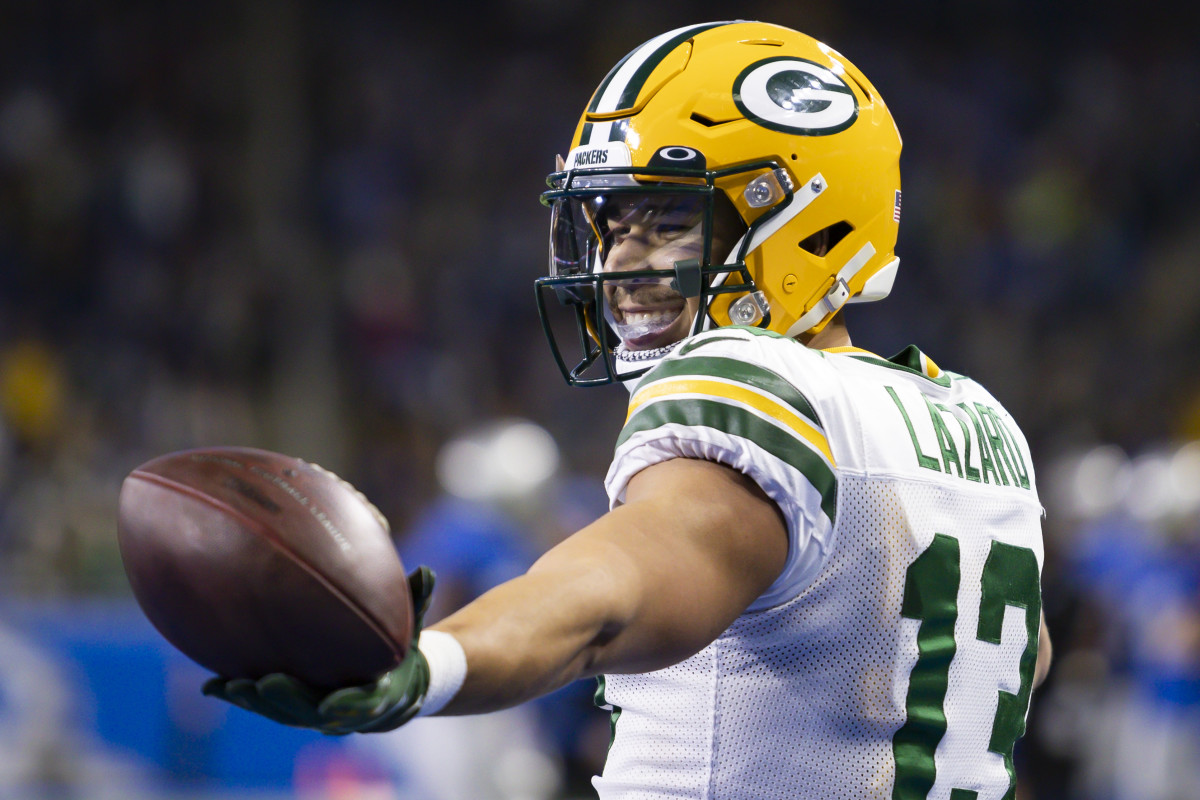
Lazard will be a restricted free agent. He’s been good enough that he could attract interest from other teams. To limit that interest, the Packers could give him the second-round tender, which will be worth almost $4 million. That’s a big chunk of change given the team’s cap problems. The team could do what it did with tight end Robert Tonyan last year, when it gave him that second-round tender, then restructured it with void years to provide cap relief.
Grade: B-plus.
Malik Taylor ($780,000 cap charge; ranking No. 164 among WRs)
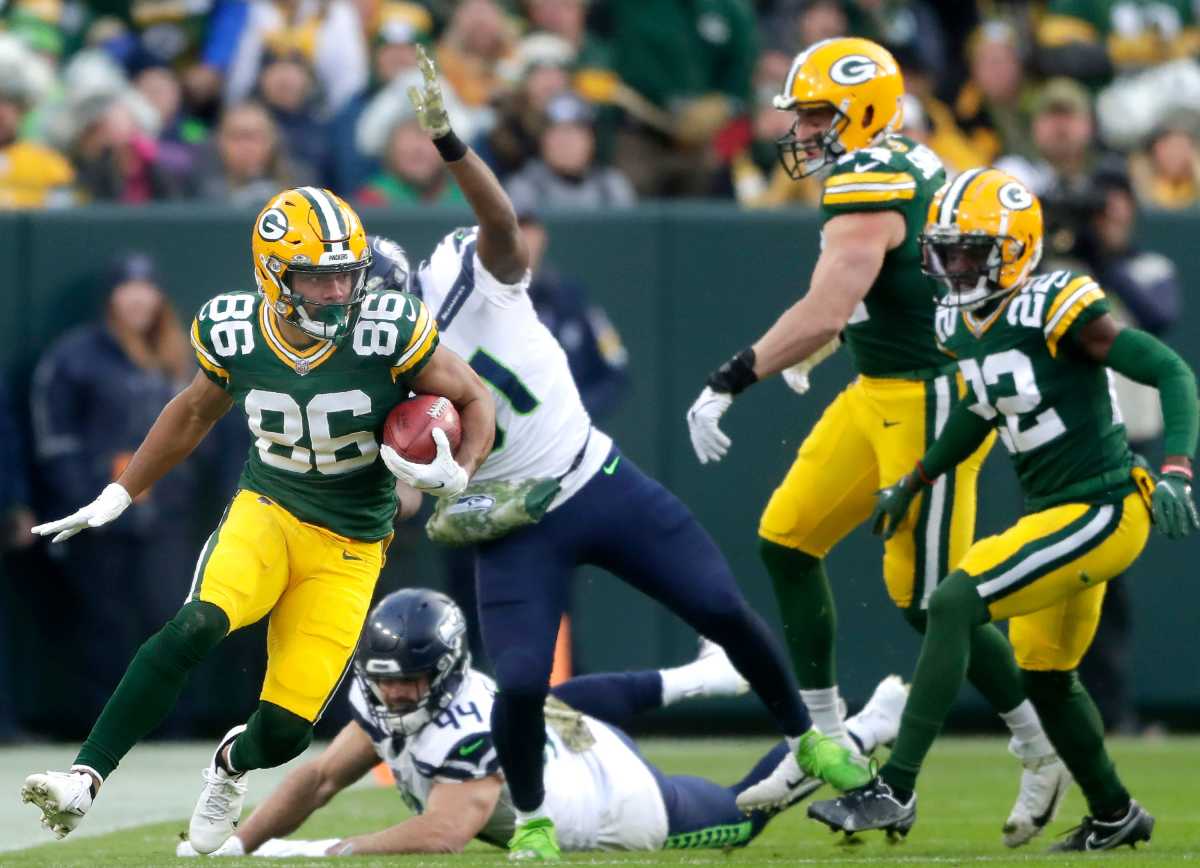
Taylor caught two passes for 14 yards at the end of the 38-3 loss to New Orleans in Week 1. He never saw the ball the rest of the season on offense. Heck, he barely saw the field the rest of the season. In 10 games, he played 32 snaps on offense – 15 in Week 1 and never more than five thereafter. About his only noteworthy play was fumbling a kickoff out of bounds at the 5 in Week 14 against Chicago.
Grade: F.
Equanimeous St. Brown ($613,889 cap charge; ranking No. 191 among WRs)
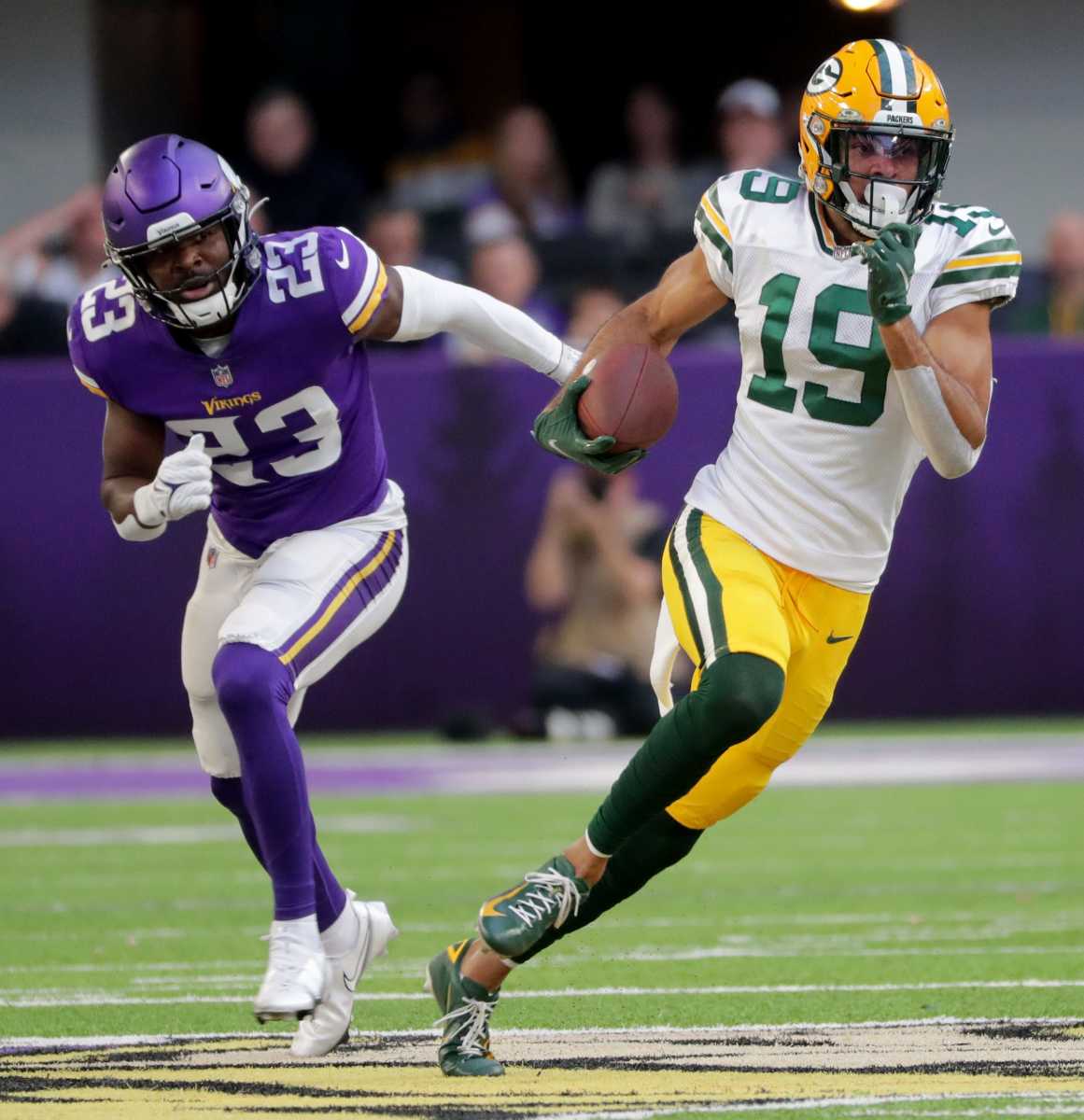
A sixth-round pick in 2018, St. Brown failed to make the roster but wound up playing in 13 games. He caught 9-of-17 passes (52.9 percent) for 98 yards and finished third on the team with seven tackles on special teams. Aaron Rodgers praised St. Brown for his attitude and performance throughout the season but it wasn’t enough to get the ball thrown his direction. He finished last on the team with 0.66 yards per pass route, according to PFF. With that, St. Brown will join a few of his teammates in free agency. On one hand, the Packers might want him back for some stability. On the other hand, he might want a fresh start after not getting many chances following a rookie season of 21 receptions.
Grade: C-minus.
Juwann Winfree ($173,333 cap charge; ranking No. 252 among WRs)
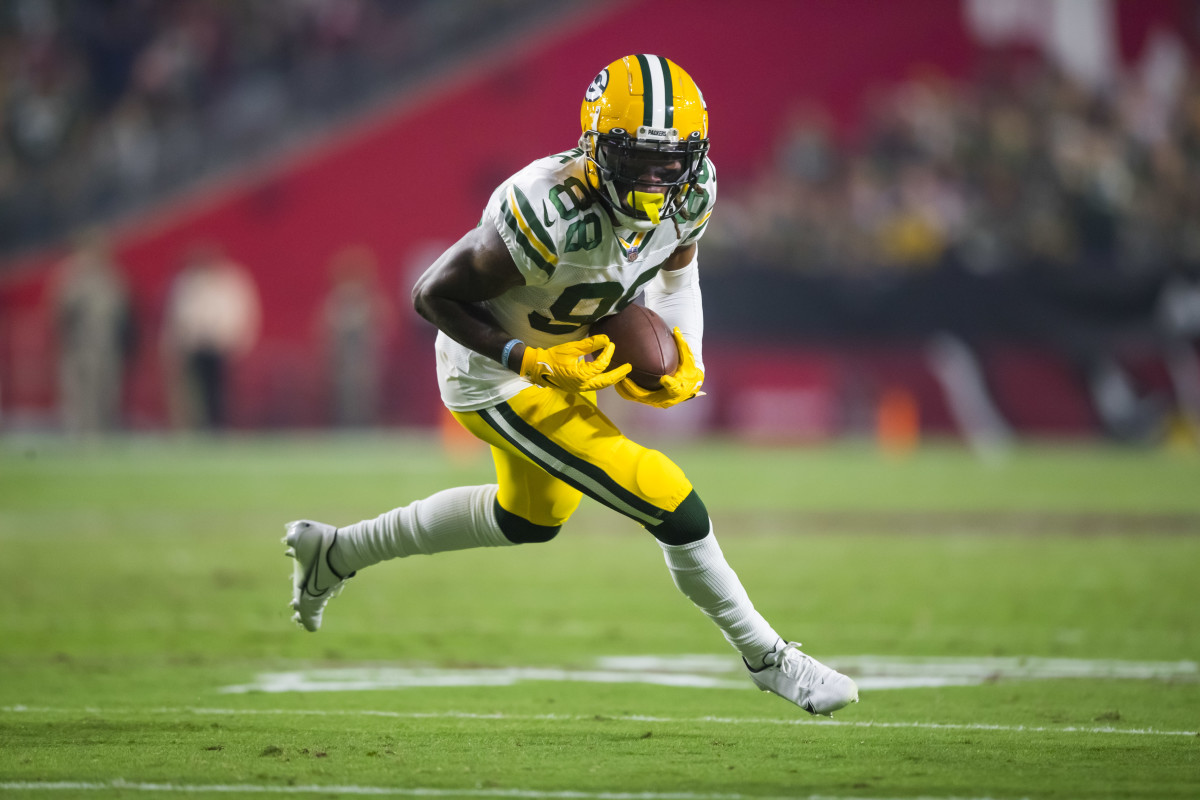
A sixth-round pick by Denver in 2019, Winfree turned heads with a string of excellent practices while the veterans stayed away from the offseason workouts. He caught the first eight passes of his career, which he turned into 58 yards, but fumbled twice. Those were the only fumbles by a Packers receiver on offense the entire season. He also had one of the nine drops charged to Green Bay’s receivers.
Grade: F.
Grading the Running Backs
Aaron Jones ($4.46 million cap charge; ranking No. 13 among RBs)
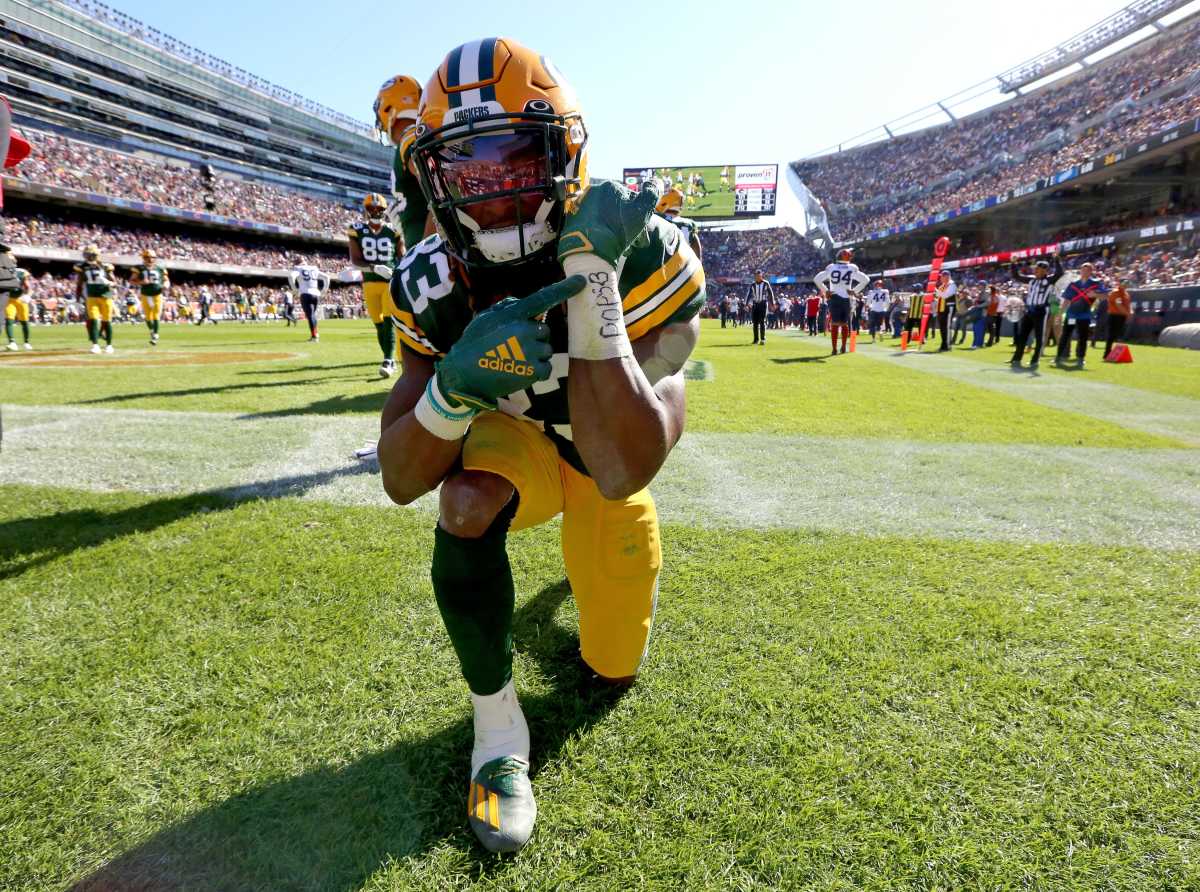
In a big surprise just before the start of free agency, the Packers re-signed Jones with a four-year deal worth $48 million.
With talent and production, leadership and charisma, it was easy to see why.
At the time his re-signed, his career average of 5.17 yards per carry ranked sixth all-time. Two of the players ahead of him, Cleveland’s Marion Motley and Jim Brown, are in the Pro Football Hall of Fame. Jones and Brown were the only players in NFL history to rush for 3,000-plus yards, 35-plus touchdowns and average 5-plus yards per carry in their first four seasons in the league.
Jones was good in 2021 but nowhere near that good. In 15 games, he rushed for 799 yards (4.7 average) and four touchdowns. A tremendous receiving threat, he added 52 receptions for 391 yards (7.5 average) and six touchdowns. That gave him 1,190 yards and 10 touchdowns from scrimmage. However, he went from 5.5 yards per rush and 5.9 yards per touch in 2020 to 4.7 yards per rush and 5.3 yards per touch in 2021. His 10-yard run rate went from 12.7 percent in 2020 to 9.3 percent in 2021.
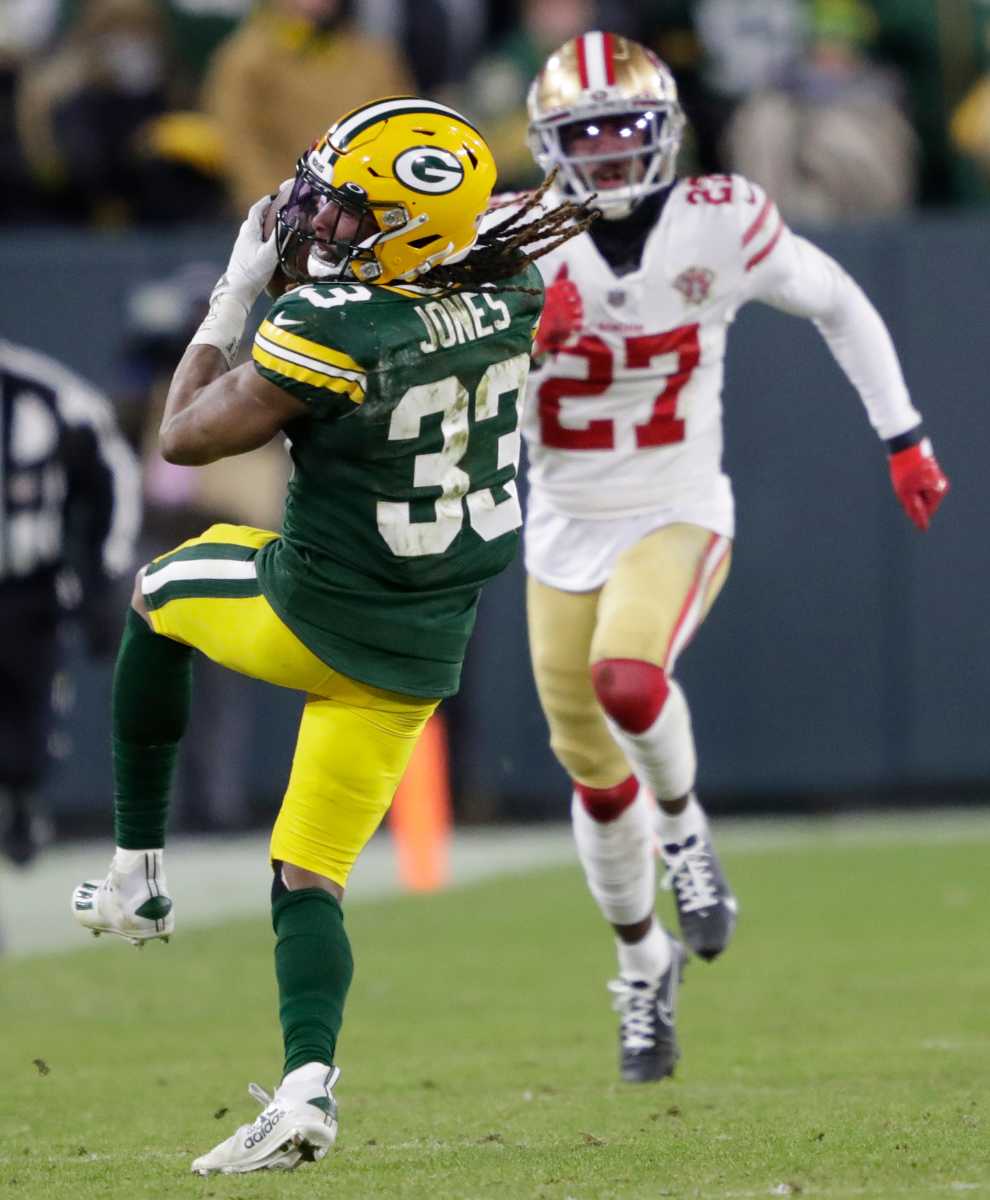
To be sure, the revolving door on the offensive line impacted his numbers. In 2020, he ran behind All-Pros David Bakhtiari and Corey Linsley and Pro Bowler Elgton Jenkins. In 2021, Jenkins played in eight games, Bakhtiari in one and Linsley was with the Chargers. Of 50 backs with at least 100 rushes, Jones tied for 13th with 3.18 yards per rush after contact, according to Pro Football Focus. He’s never shied away from contact. However, he ranked just 32nd in Success Rate, according to Football Outsiders. (More on that stat in a moment.)
The problem with paying running backs is, at some point, the accumulation of hits is just too much. Jones isn’t to that point but he might be best as 1B to AJ Dillon’s 1A.
Grade: C-plus.
AJ Dillon ($1.20 million cap charge; ranking No. 51 among RBs)
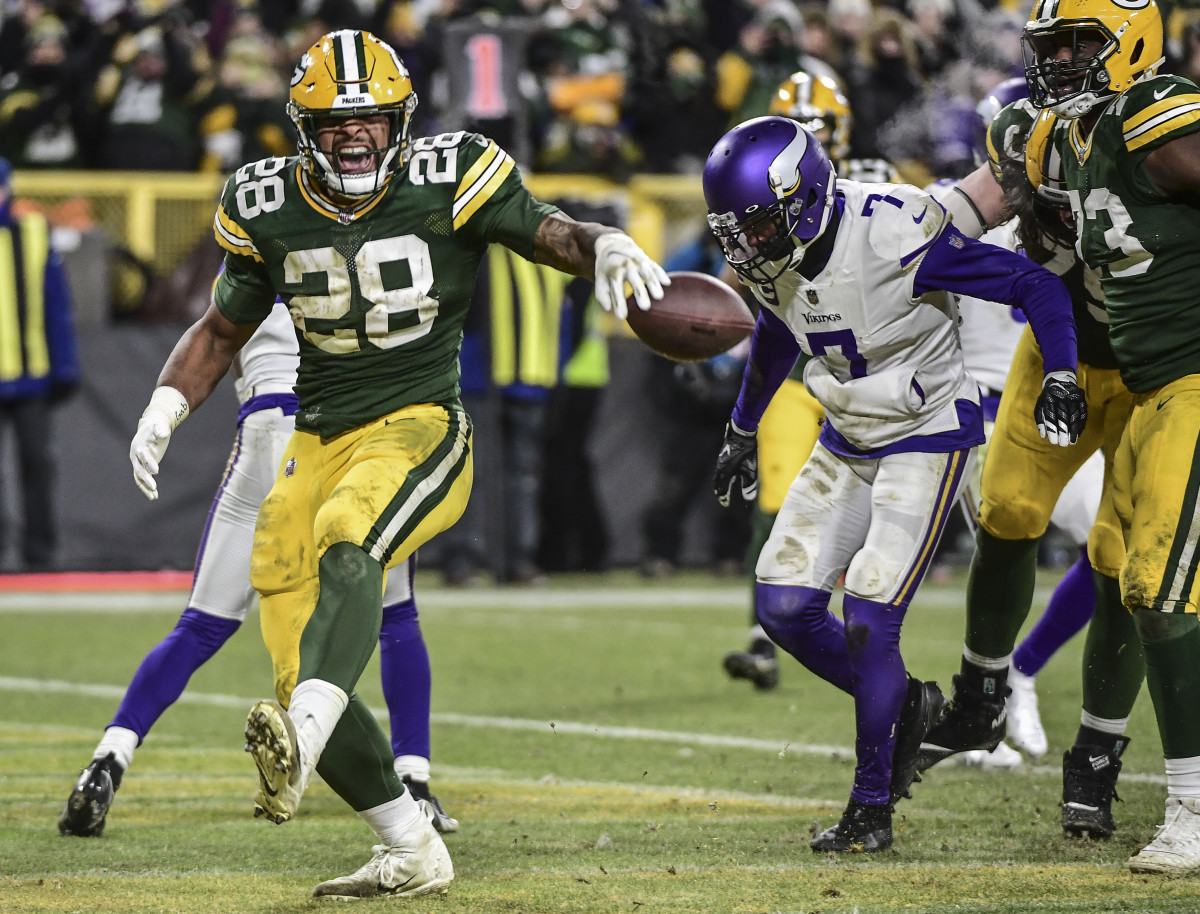
On the surface, there was nothing particularly great about Dillon’s second season. He led the team with 803 rushing yards but averaged a modest 4.3 yards per carry. However, Football Outsiders has a stat called Success Rate. It mirrors the Packers’ win/loss system. A first-and-10 run that gains 4 yards is a win; anything less is a loss. A second-down run that gains at least half the required distance is a win. A third-down run that moves the chains is a win.
According to Football Outsiders, Dillon ranked No. 1 with a 63 percent success rate.
Dillon got what was blocked and typically used his muscular legs to get significantly more. He ranked 20th in the NFL in rushing but 16th in rushing yards after contact. He tied Jones for 13th in the league with 3.18 yards after contact per carry. A total nonfactor in the passing game at Boston College, Dillon has backed up the scouts’ beliefs. According to PFF, 44 backs were targeted at least 35 times. Dillon ranked third in catch rate (91.9 percent) and eighth in YAC per catch (9.2) while catching 34 balls for 313 yards and two scores.
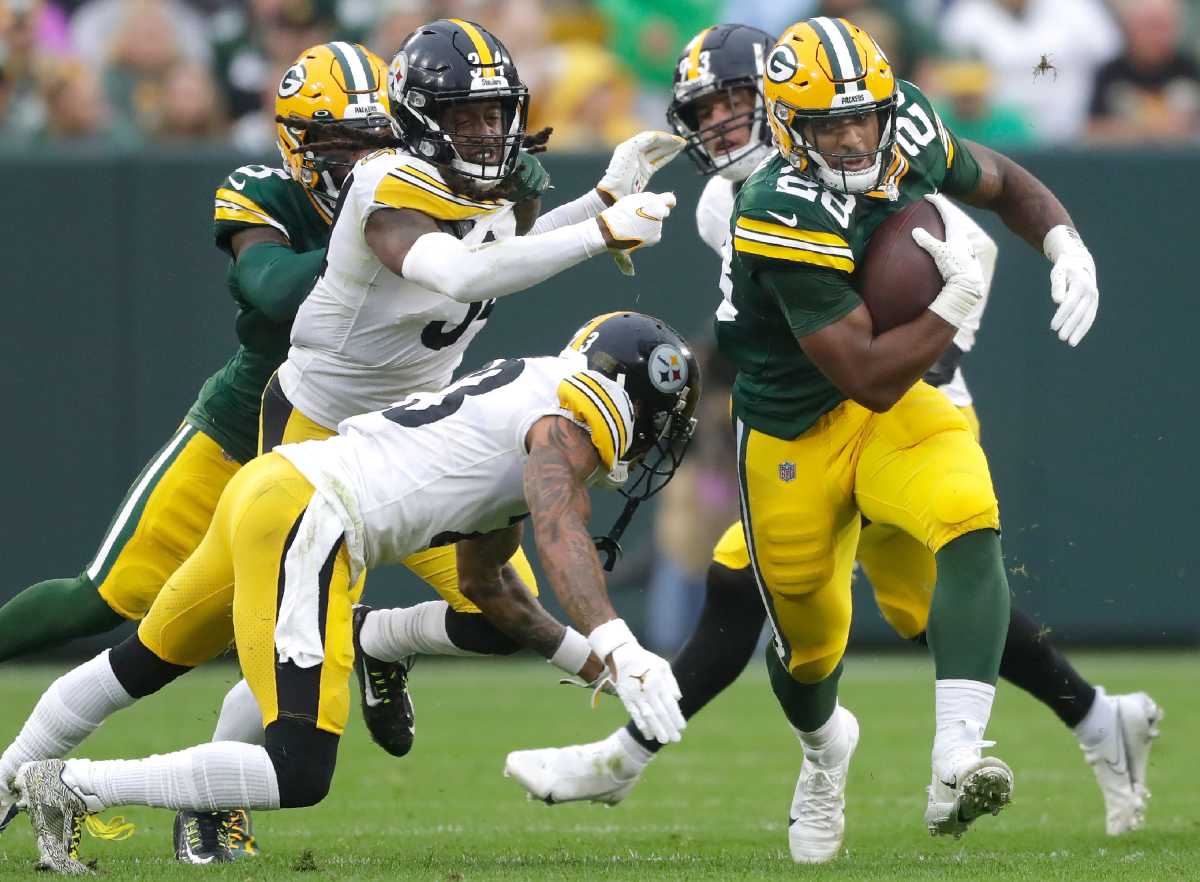
Where Dillon needs to take a big step is in explosive runs. He had nine runs of 10-plus yards, a 10-yard run rate of 4.8 percent that ranked last out of the 50 backs with 100-plus attempts. He wasn’t given a path into the open field very often. When he did, he never got close to getting past that last line of defense.
Grade: B.
Kylin Hill ($543,655 cap charge; ranking No. 121 among RBs)
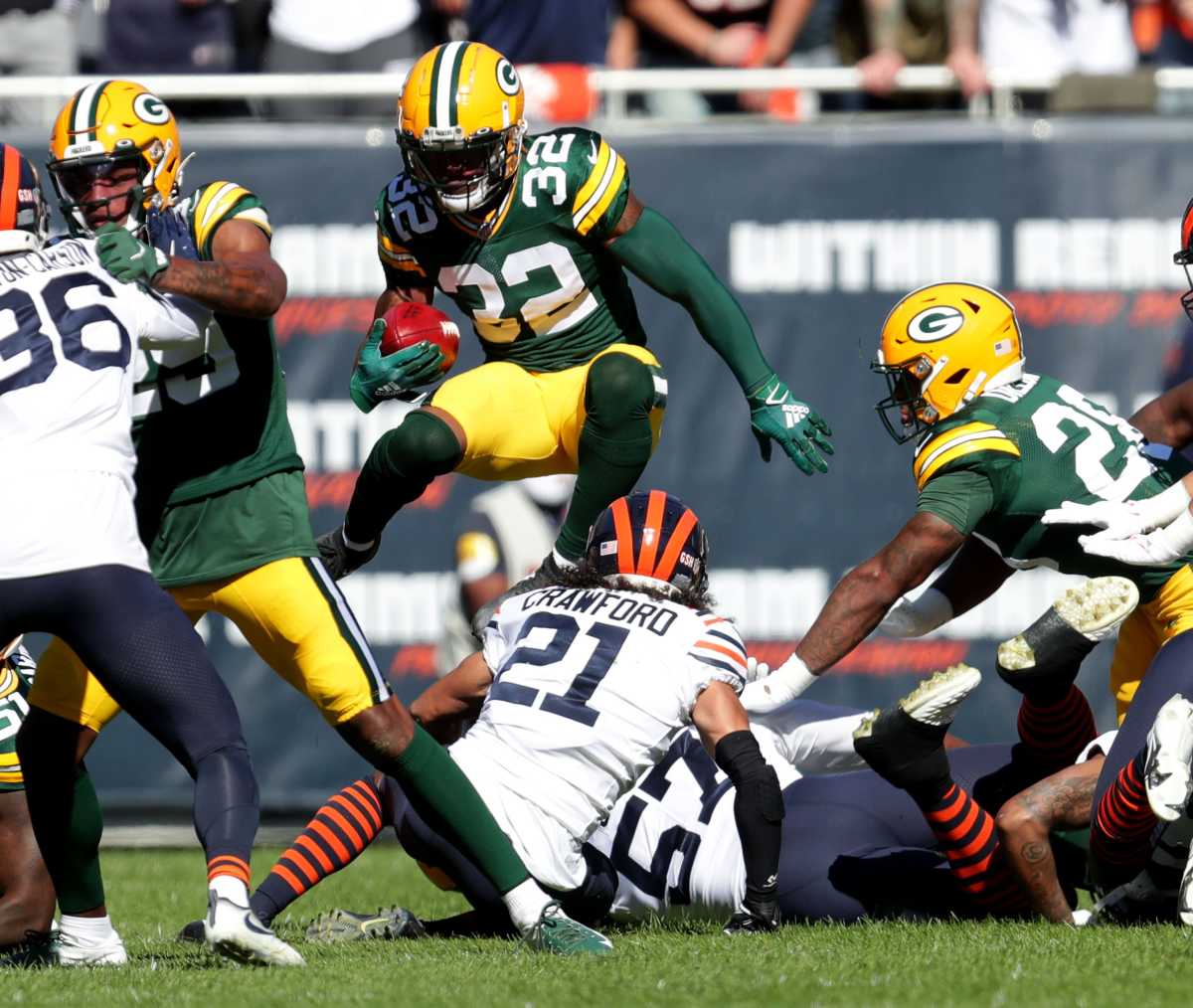
A potential-packed seventh-round pick, Hill never had a prayer of earning a major role alongside Jones and Dillon. He carried 10 times for 24 yards (2.4 average; long of 8) and caught one pass for 5 yards. He didn’t break any tackles and averaged 1.9 yards after contact. Given a shot on kickoff returns, he averaged only 19.9 yards per return but had the team’s longest of the season (41 yards). He suffered a torn ACL returning a kickoff in Week 8 at Arizona.
Grade: D.
Patrick Taylor ($366,667 cap charge; ranking No. 133 among RBs)
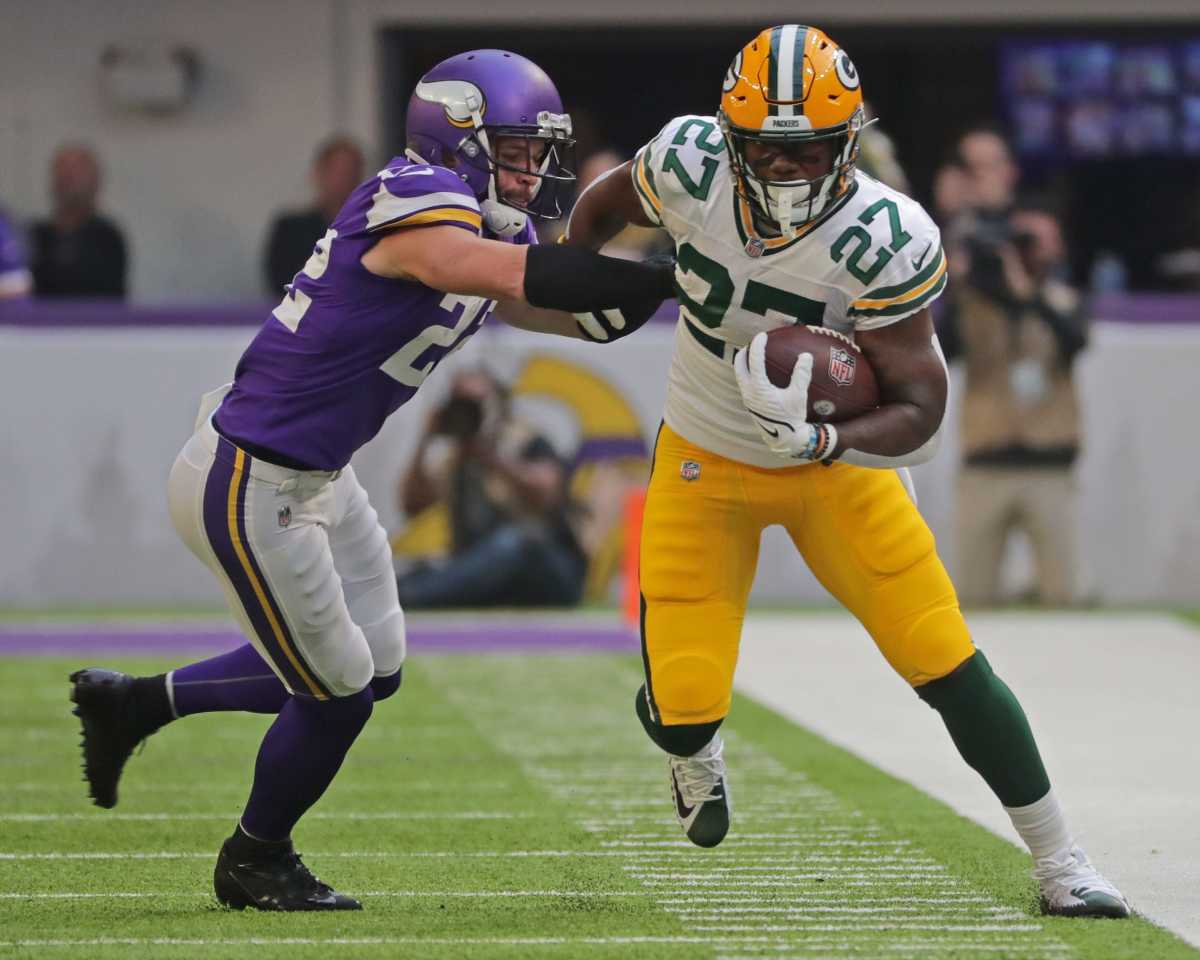
Beaten out by Hill for the No. 3 job during training camp, Taylor got his chance when Hill went down at midseason. He was much better on Sundays than on the practice field. He carried 23 times for 89 yards (3.9 average) and one touchdown and caught two passes for 3 yards. In those limited snaps, he forced six missed tackles, averaged 3.04 yards after contact and had two carries of 10-plus yards.
With Jones inactive and Dillon getting limited reps in the finale at Detroit, Taylor really flashed. He carried 11 times for 53 yards and one touchdown, with 40 of those yards coming after contact. That game has him positioned for a roster spot next summer.
Grade: C.
Grading the Tight Ends
Marcedes Lewis ($2.425 million cap charge; ranking No. 34 among TEs)
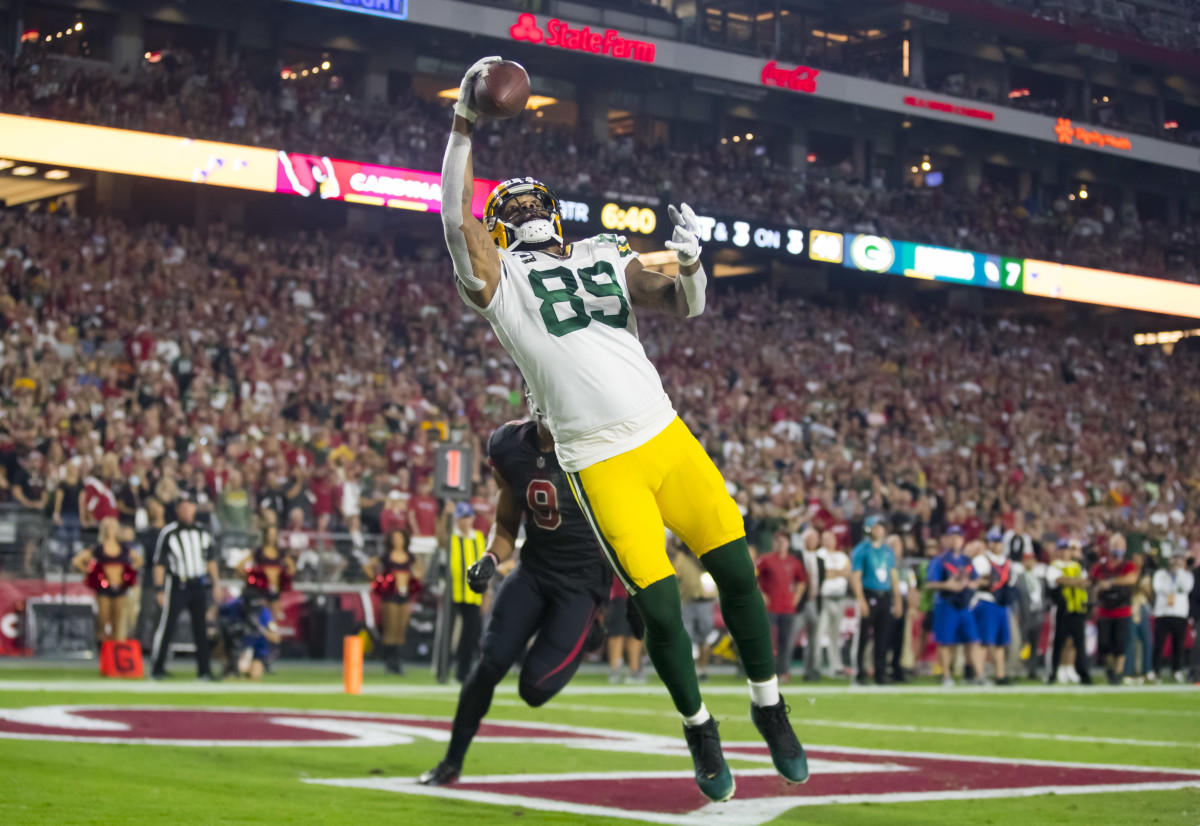
“Big Dog” was forced to be the top dog at the position. Lewis caught 23-of-28 passes (82.1 percent) for 214 yards (9.3 average). He did not get in the end zone, but his catch percentage was the highest of his career and his catch count was his second-highest since 2013.
Of the 53 tight ends who were targeted at least 25 times, Lewis ranked third in catch percentage and eighth in yards after the catch per catch (6.5), according to Pro Football Focus. Get this: Lewis forced nine missed tackles. That was as many as Baltimore’s Mark Andrews, who caught 107 passes, and more than Arizona’s Zach Ertz (74 catches), Miami’s Mike Gesicki (73) and six others who caught 60-plus passes.
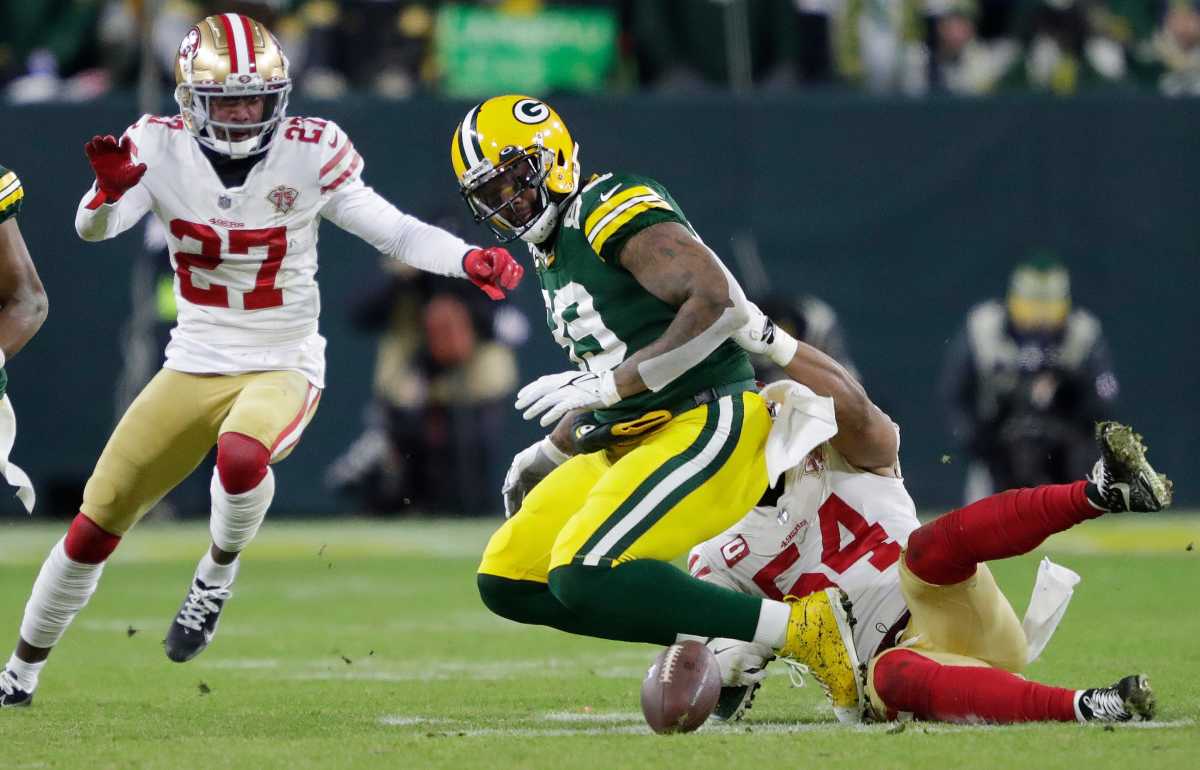
Of course, Lewis wasn’t paid to catch passes or run over defenders. He was paid to block, lead and inspire. He did all those things, too. Lewis is under contract for next season, though the team can move on and save almost $2.5 million. It would be a shame if his last noteworthy play was the fumble that turned the NFC Championship Game.
Grade: B-plus.
Robert Tonyan ($1.50 million cap charge; ranking No. 51 among TEs)
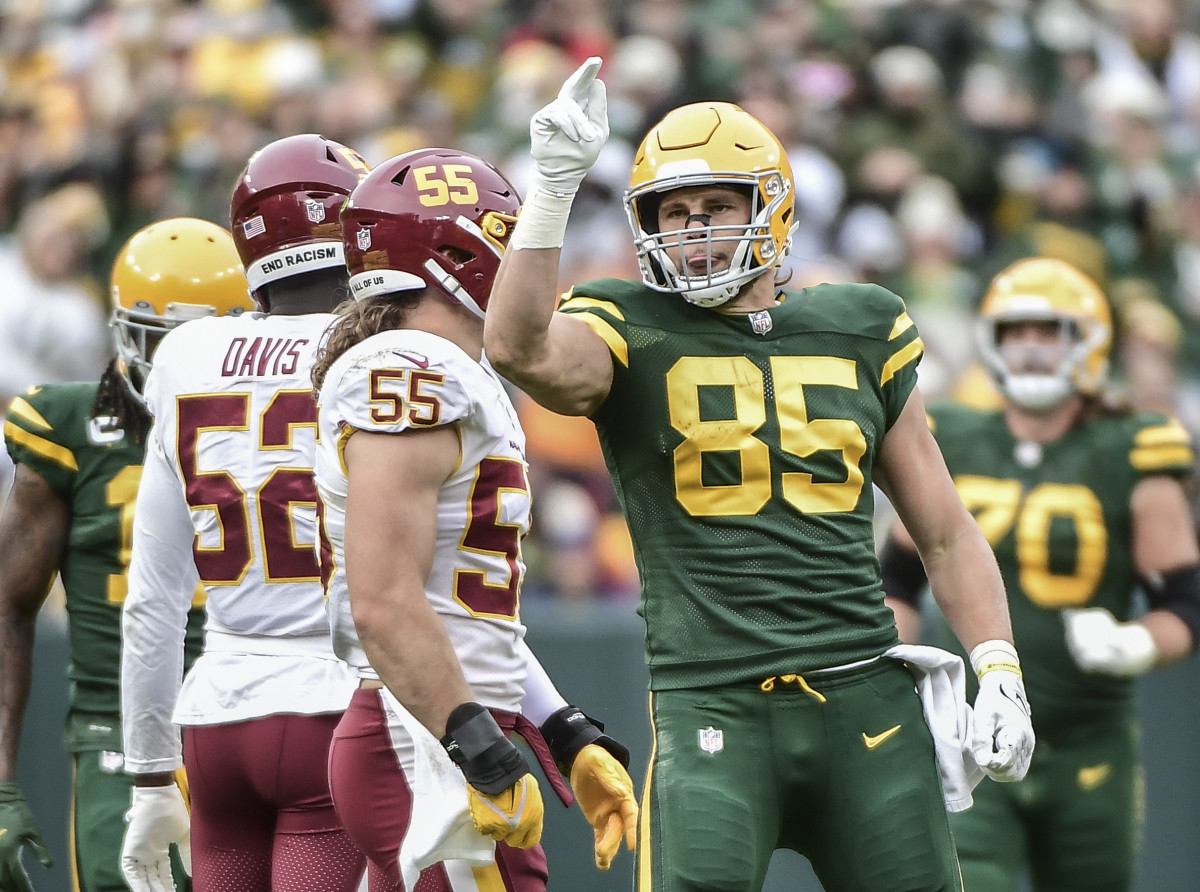
The Packers used third-round draft picks on Richard Rodgers, Jace Sternberger and Josiah Deguara. They signed Martellus Bennett, Jared Cook and Jimmy Graham in free agency. It turns out the difference-making tight end they had been seeking for years was a college quarterback-turned-receiver who joined the practice squad late in the 2017 season.
Tonyan had a breakout 2020 season in which he caught 52 passes for 586 yards and 11 touchdowns. Of the 34 tight ends who were targeted at least 40 times in the passing game, Tonyan was No. 1 in catch percentage (89.7), drop percentage (0.0) and passer rating (148.3), according to PFF, and tied for No. 1 in touchdowns. To keep suitors at bay, the Packers gave him a second-round tender in restricted free agency, which was worth $3.38 million, then restructured it by adding four void years to deal with the cap hit.
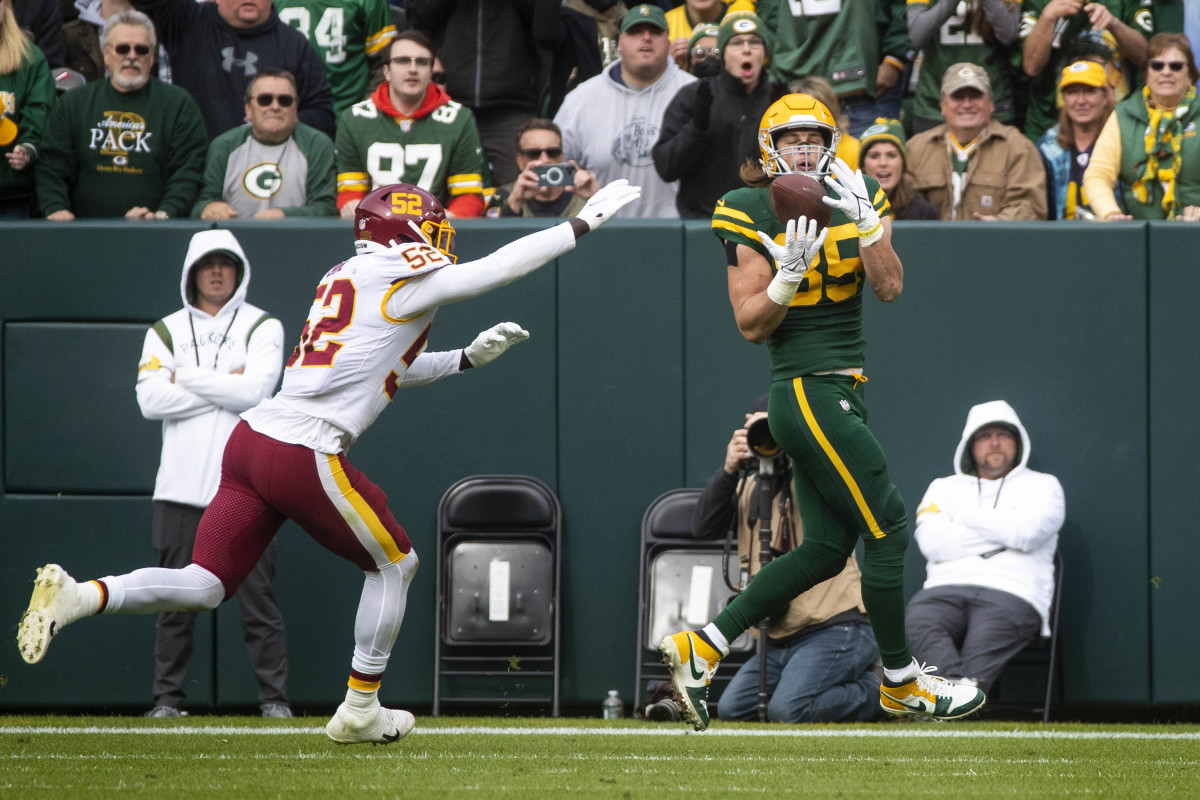
With a strong 2020 and dominant training camp, Tonyan had positioned himself to get a big contract as an unrestricted free agent this offseason. Instead, he suffered a torn ACL in Week 8 at Arizona. He caught 18-of-29 passes – those 11 incompletions more than all of 2020 – for 204 yards and two touchdowns. He even dropped a pass, which was worthy of a breaking-news bulletin on CNN. After a four-game stretch in which he caught just 6-of-13 for 32 yards, Tonyan caught 4-of-5 for 63 yards vs. Washington and 3-of-4 for 49 yards with a season-long gain of 33 vs. Arizona before the injury.
The grade is harsh – it’s not his fault he was injured, after all.
Grade: D.
Josiah Deguara ($1.03 million cap charge; ranking No. 60 among TEs)
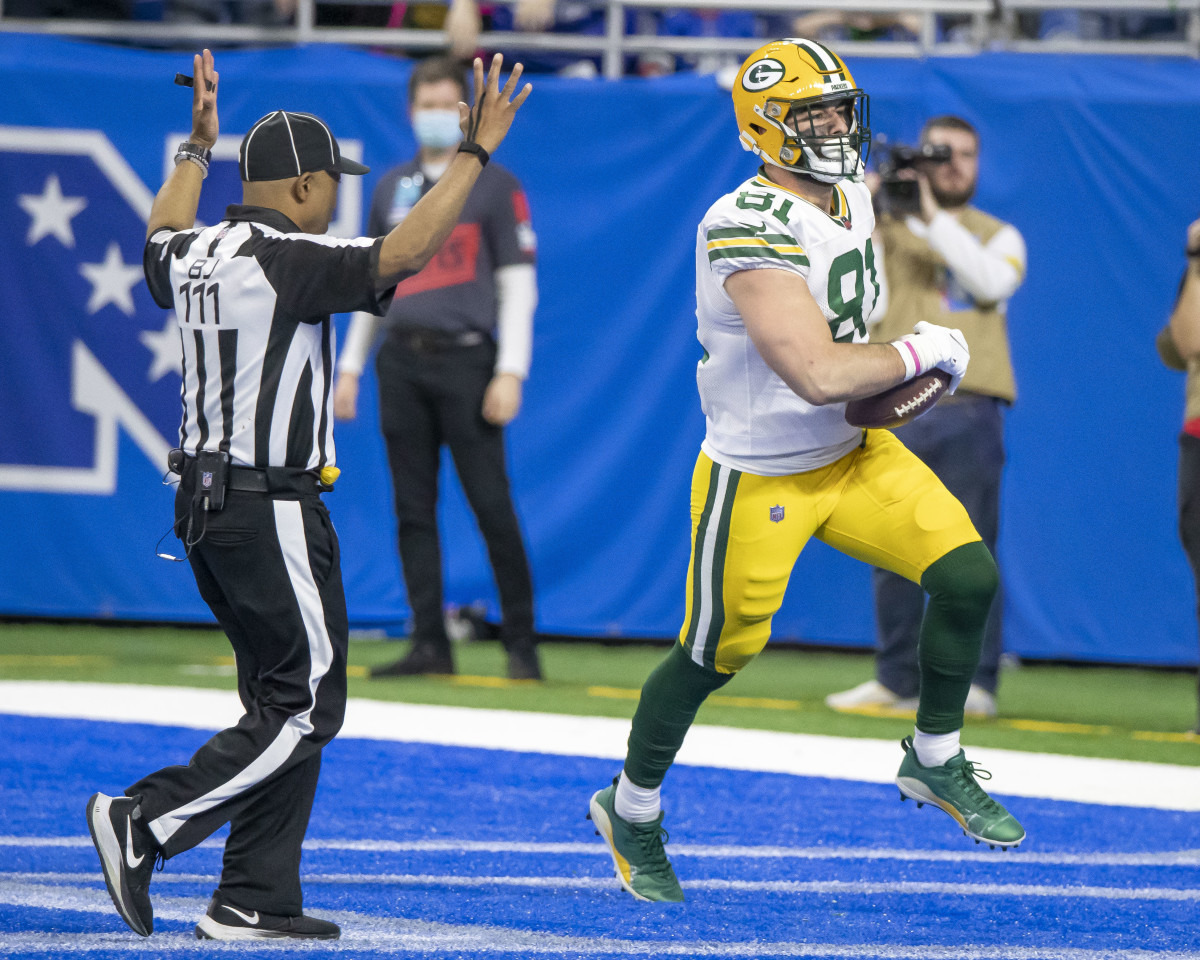
After missing most of his rookie season with a torn ACL and because of Tonyan’s torn ACL this year, Deguara’s snap count went from 31 to 367. He caught 25-of-33 passes (75.8 percent) for 245 yards (9.8 average) and two touchdowns. Thanks in large part to his 62-yard touchdown at Detroit, he finished second among tight ends with 8.3 yards after the catch per catch. He dropped only one pass during the regular season but had a big drop on a slightly off-target ball during the third quarter against the 49ers.
When the Packers drafted him, they envisioned him playing a role similar to that of 49ers fullback Kyle Juszczyk with an ability to play here, there and everywhere. This year, according to PFF, he played 162 snaps as a traditional tight end, 108 as a slot receiver, 53 as a wide receiver and 44 at fullback. That’s probably too many snaps as a traditional tight end – at 6-foot-2, he’s not cut out for that role – but he did what he could to handle some of Tonyan’s role. As a fullback, especially, he really showed his ability to block.
Grade: C.
Dominique Dafney ($685,556 cap charge; ranking No. 103 among TEs)
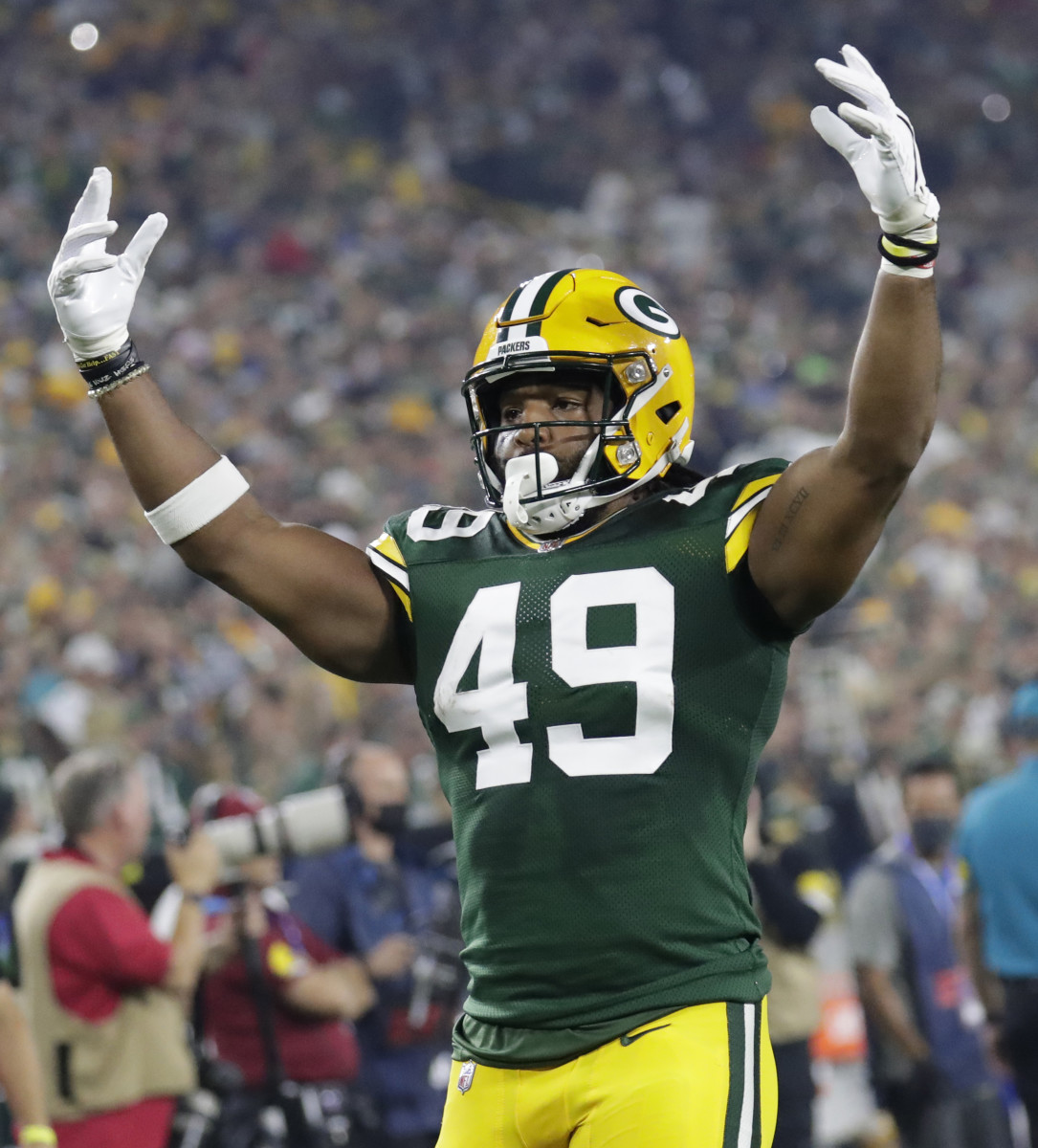
Playing 167 snaps as injuries limited him to 10 games, the former nightclub bouncer caught 2-of-4 passes for 34 yards. His big play of the year was a 26-yarder at Detroit. With a size and skill-set similar to that of Deguara, he played 119 snaps as a traditional tight end, 22 at fullback, 21 at slot receiver and five as a wide receiver. Generally speaking, he blocked well and couldn’t have been more of an afterthought in the passing game. With Deguara probably entrenched in the “universal” role, as position coach Justin Outten called it, Dafney will have to stick around because of his play on special teams.
Grade: D.
Tyler Davis ($650,000 cap charge; ranking No. 109 among TEs)
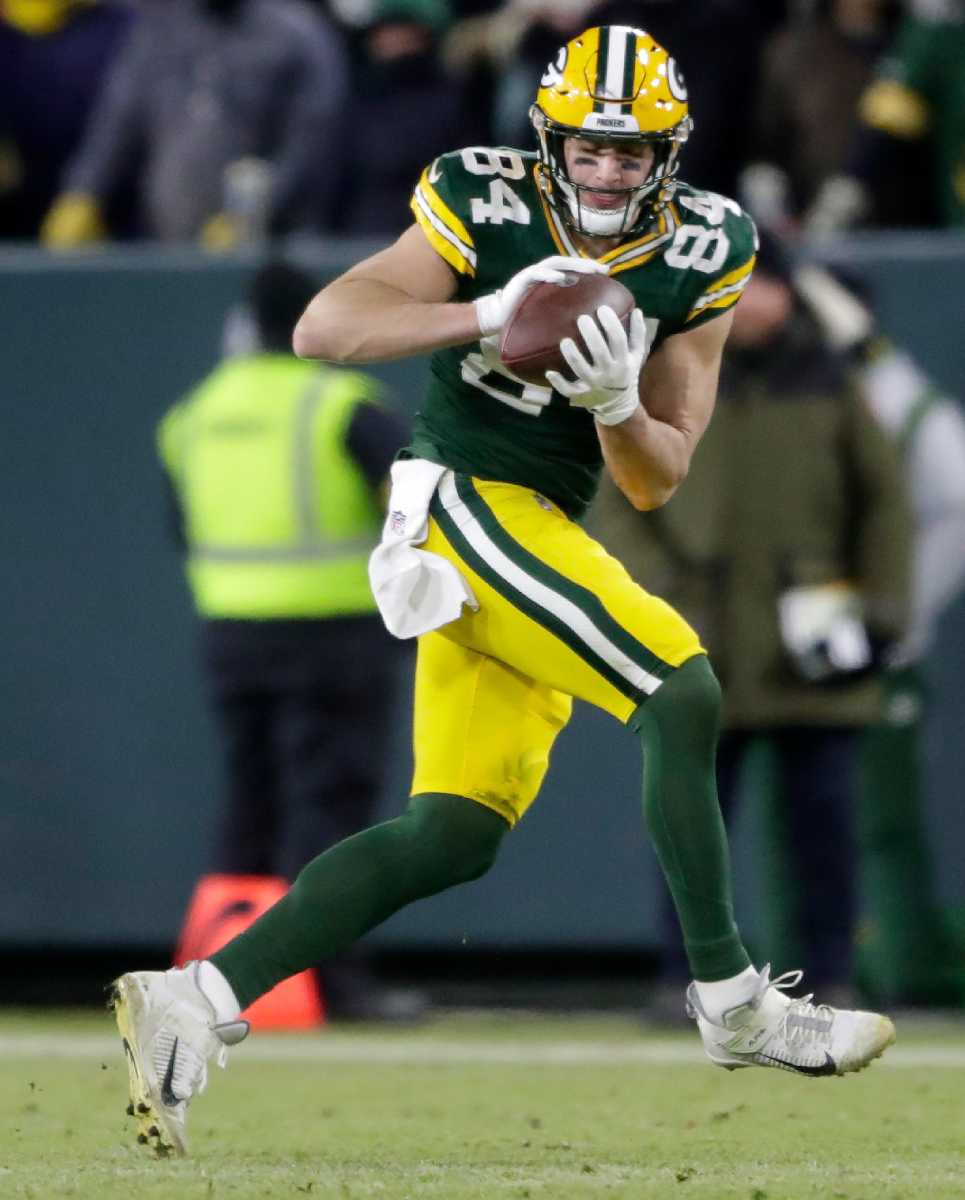
Plucked off Indianapolis’ practice squad in late September, the 2020 sixth-round pick played in 14 games and caught 4-of-5 passes for 35 yards. The only tight end on the roster with something approximating Tonyan’s physical skill-set in terms of size and athleticism, he logged 88 of his 121 snaps during the final four regular-season games and 11 more in the playoffs. If he can block as well as he did in limited duty, he’s got a chance to stick around for 2022.
Grade: D-plus.
Grading the Offensive Line
LT David Bakhtiari ($10.97 million cap charge; ranking No. 10 among OTs)
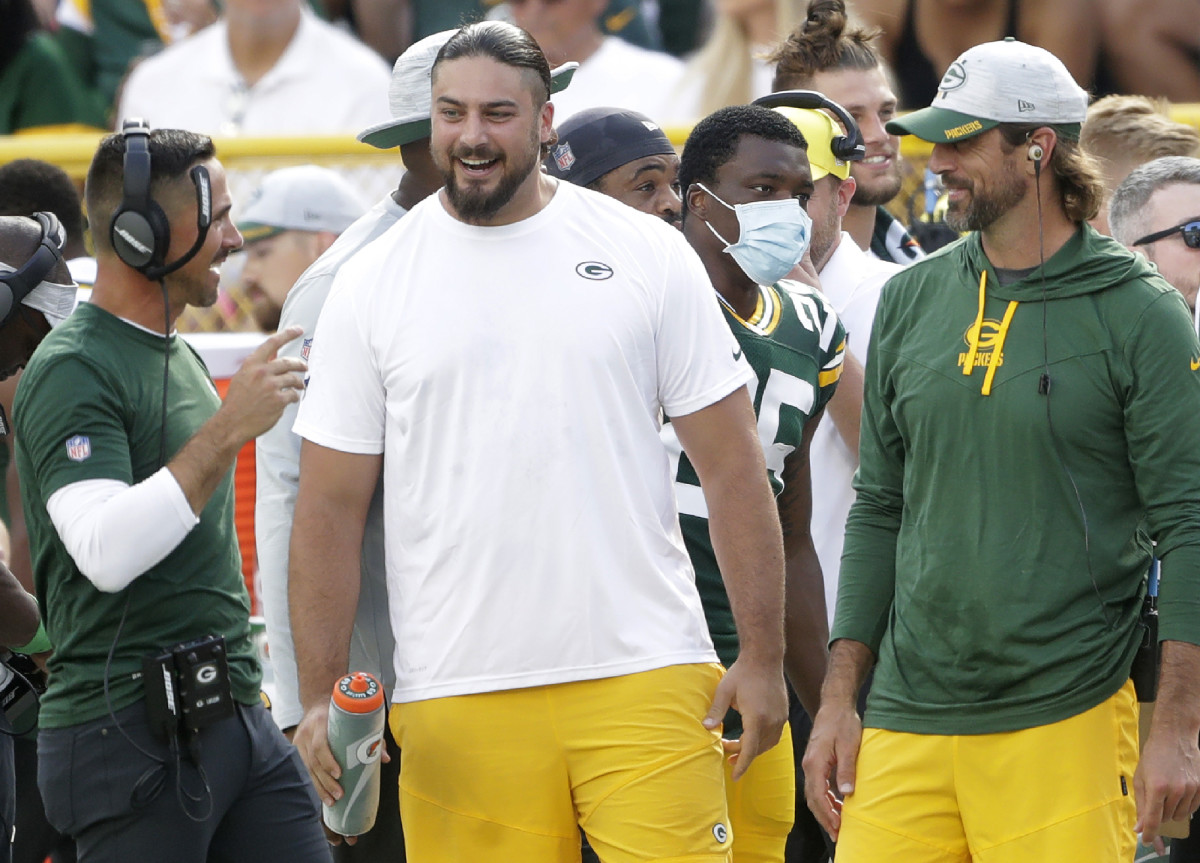
The five-time All-Pro had a year he’d love to forget. The ACL tear he sustained late in the 2020 season perhaps prevented the Packers from beating the Buccaneers and getting to the Super Bowl. Bakhtiari targeted a midseason return but it just didn’t happen. The knee never felt right and there was a disconcerting fluid buildup. So, he had a follow-up procedure done. When he returned for the finale at Detroit – and somehow played as if he were in midseason form – it meant he’d be back for the playoffs and a potential Super Bowl run.
Actually, it’s not what it meant. Bakhtiari was inactive for the loss against San Francisco. That meant he was paid $118,518.52 for each of his 27 snaps. Now, the hope is Bakhtiari will be able to return to form for the final three years of his contract.
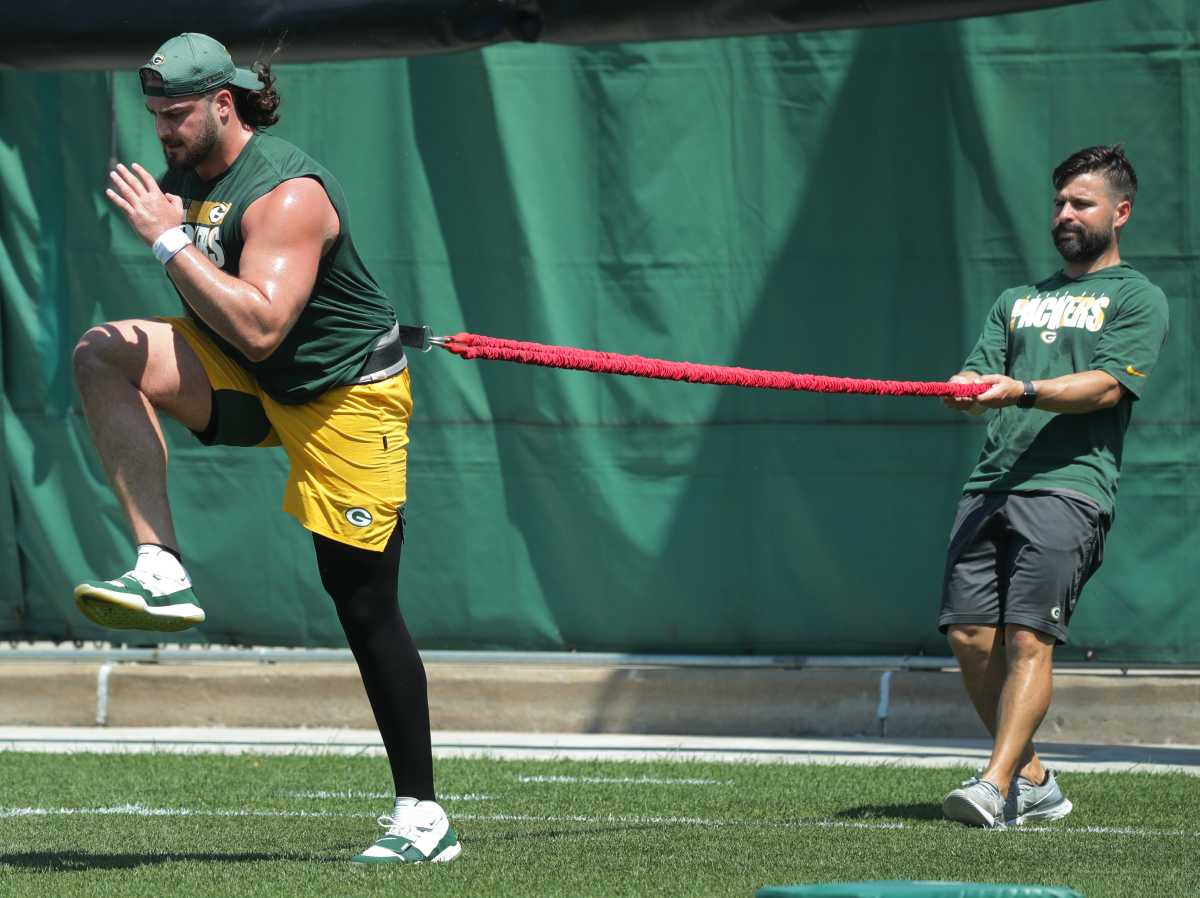
Speaking of his contract, a restructure created $8.3 million of cap space for 2021. His new cap number for 2022 will be $22.2 million, fourth-highest among tackles. Presumably, the Packers will turn his $9.5 million roster bonus into signing bonus and add some void years to his contract to lesson the blow. That sounds great but it makes the long-term health of his knee a bigger priority.
The grade isn’t a knock on Bakhtiari, his comeback or his mind-set. It’s not his fault that he didn’t recover as well as anyone had hoped. It’s not as if he was slamming cans of beer and eating platters of poutine rather than rehabbing. It’s just the reality.
Grade: F.
LG Elgton Jenkins ($1,849,805 cap charge; ranking No. 44 among OGs)
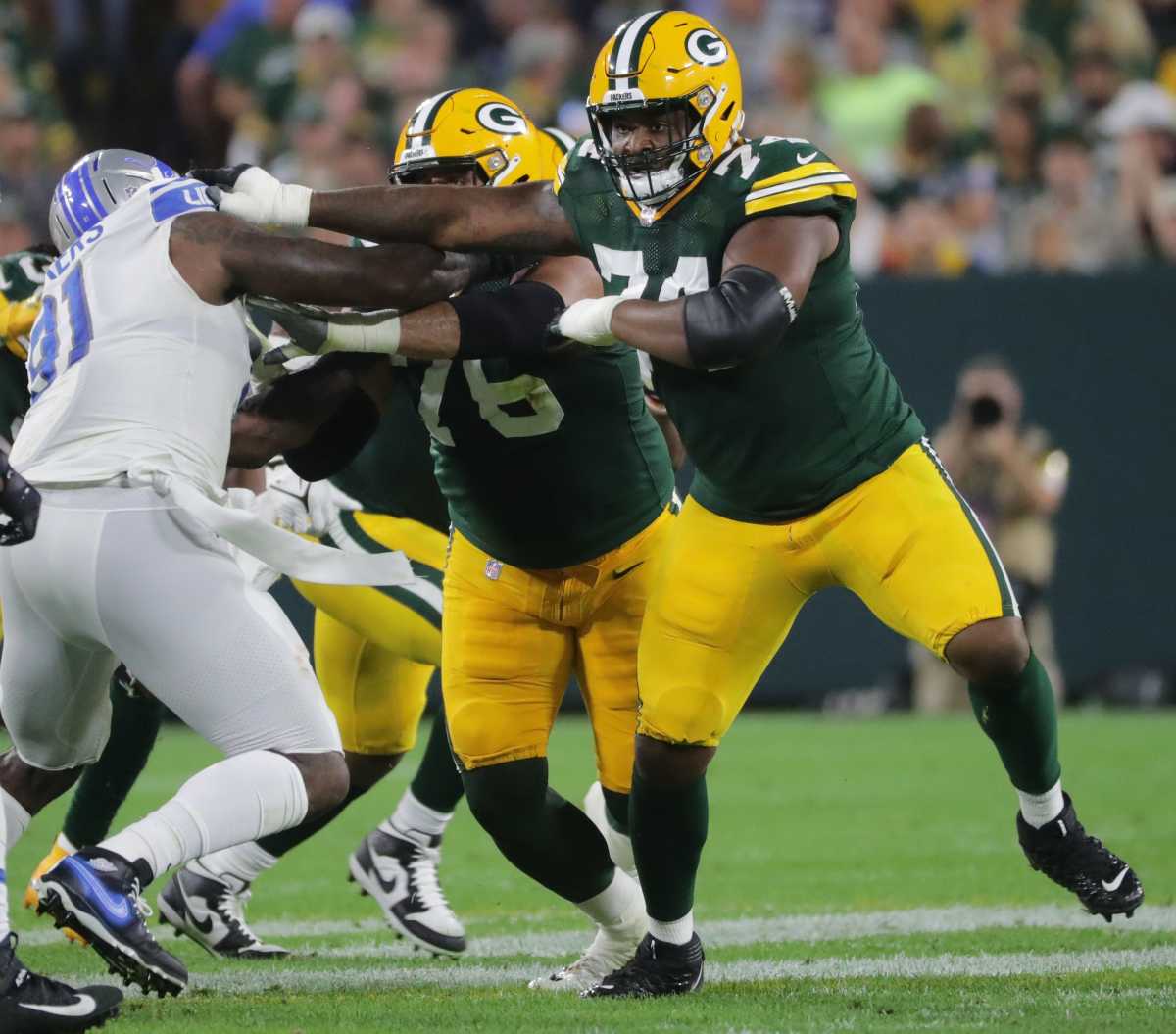
Jenkins went from being hailed as one of the top guards in the NFL as a Pro Bowler in 2020 to one of the best offensive linemen, period, in 2021, when he capably replaced Bakhtiari at left tackle. Before he suffered a torn ACL at Minnesota in Week 11, he was absolutely tremendous.
Of 67 offensive tackles with at least his 496 snaps, he ranked 16th in PFF’s pass-blocking efficiency, which measures sacks, hits and hurries per pass-protecting snap. SIS charged him with zero blown blocks in the run game. (A blown block is defined as any time a blocker does not successfully block the defender he attempted to engage with and gave the defender an opportunity to negatively affect the play). Of every lineman in the NFL who played at least Jenkins’ 176 snaps as a run blocker, he was the only one with a blown-block rate of 0.0 percent.
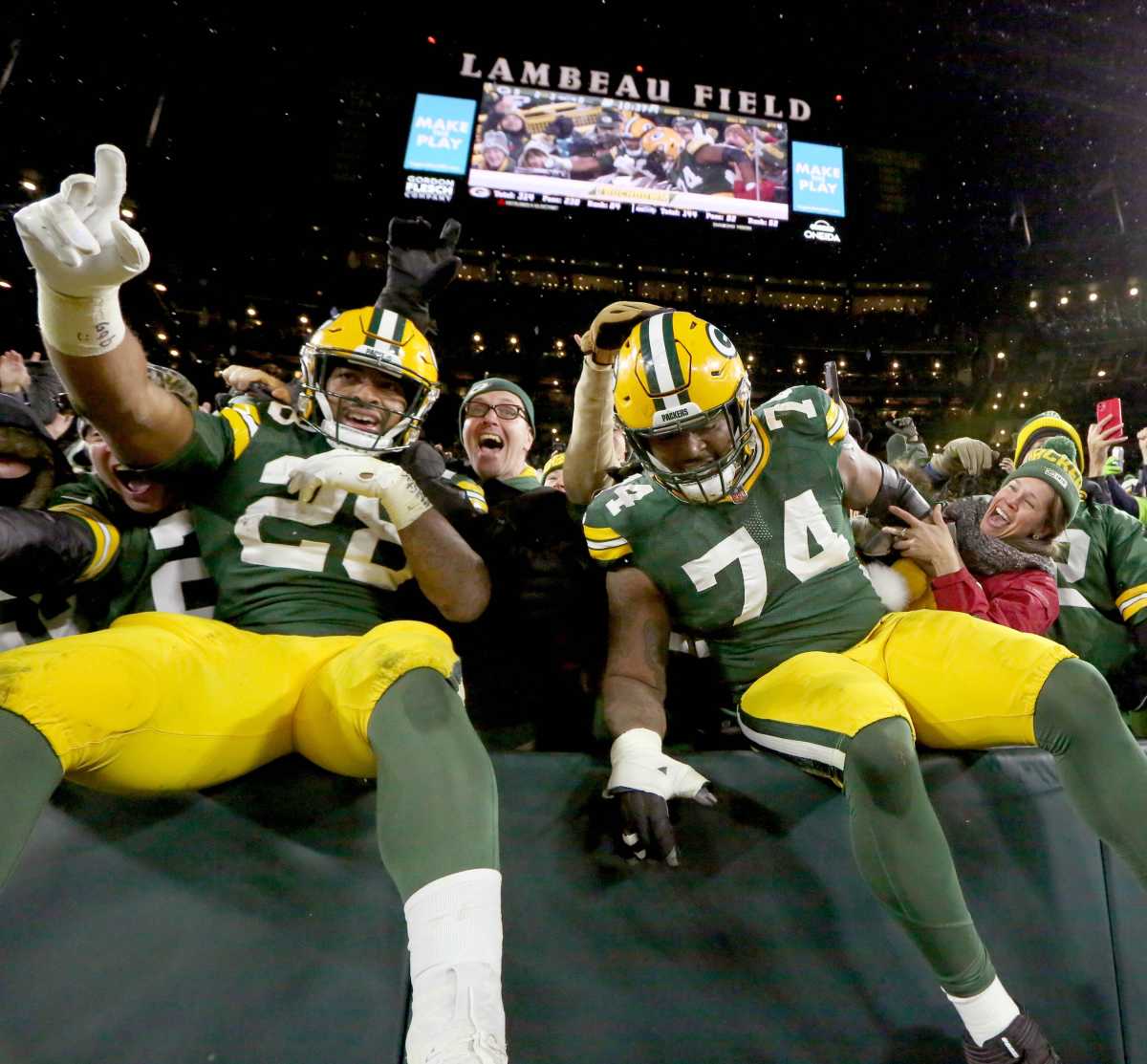
Bakhtiari’s injury shows nothing is guaranteed in coming back from a torn ACL. Nonetheless, a 10-month recovery would get Jenkins on the field by late September. When he does come back, where will he line up? Will he back at left guard? Or how about right tackle if the Packers don’t bring back Billy Turner? That question not only will be important for the Packers but for Jenkins, who will be entering his final season under contract knowing that tackles get paid more than guards.
The grade doesn’t measure Jenkins’ performance – that’s an easy “A” for his eight games – but is a reflection of missing so much time.
Grade: C.
C Josh Myers ($1.01 million cap charge; ranking No. 35 among OCs)
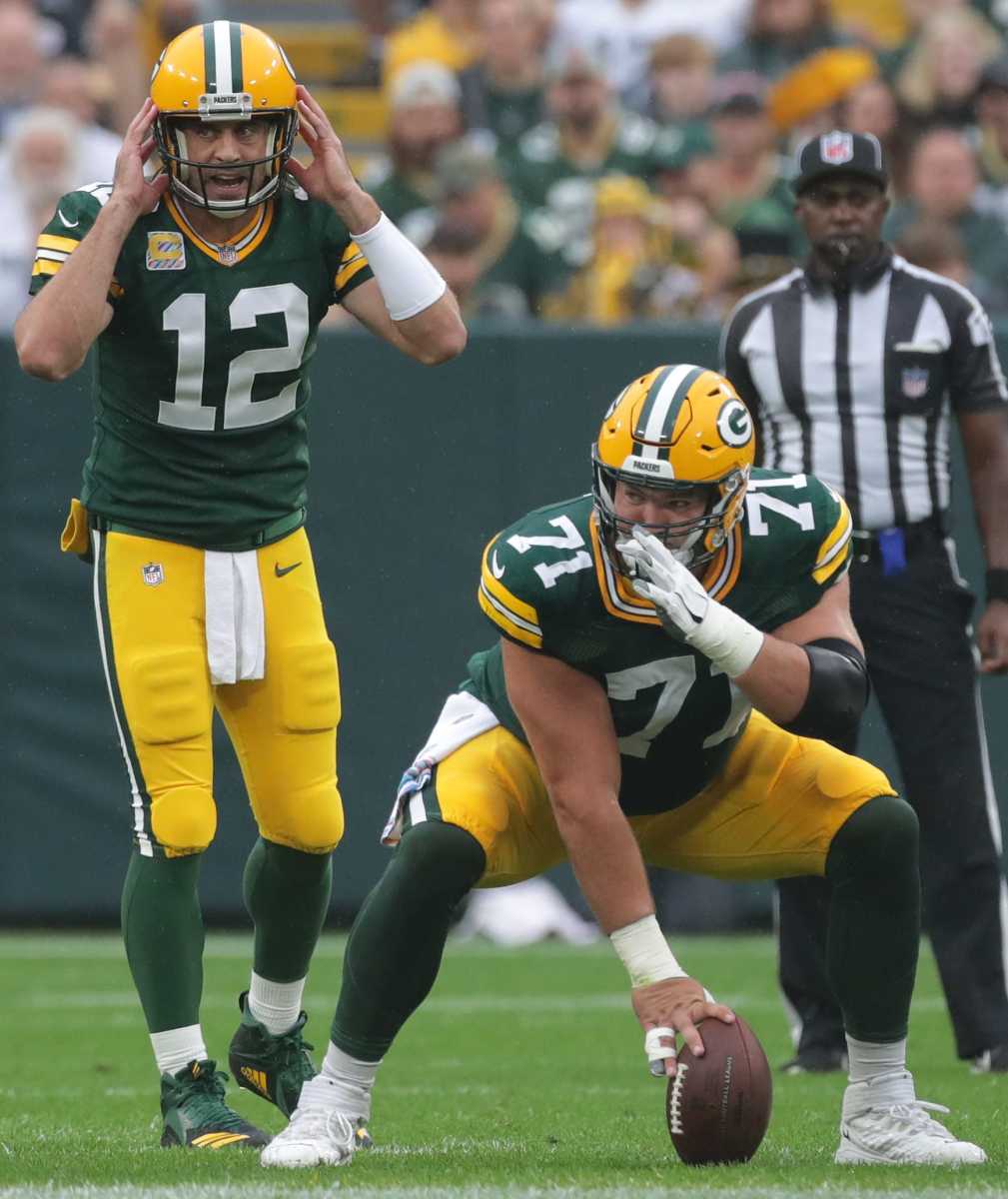
A second-round pick this year, Myers was handed the starting job at center. It was a challenging season, starting with a broken finger that sidelined him for the Week 5 game at Cincinnati when it became infected. He returned for Week 6 at Chicago but suffered a torn MCL on his fourth snap. That injury kept him out for almost three months before returned for the finale at Detroit.
Officially, Myers started six games. In reality, he played in about 4 1/2, which is reflected in the grade. Of the 39 centers who played at least Myers’ 293 snaps, he ranked 29th in PFF’s pass-blocking efficiency with zero sacks and eight total pressures. In the run game, he had one blown block for a blown-block rate of 0.9 percent. He was not penalized.
It’s too early to say which team won the NFL Draft, but the Packers selected Myers at No. 62 overall and the Chiefs selected center Creed Humphrey at No. 63. Generally considered the best center in the draft, Humphrey was first-team all-rookie after allowing one sack and 10 total pressures and a blown-block rate of 0.8 percent while starting all 17 games.
Grade: D-plus.
RG Royce Newman ($784,836 cap charge; ranking No. 100 among OGs)
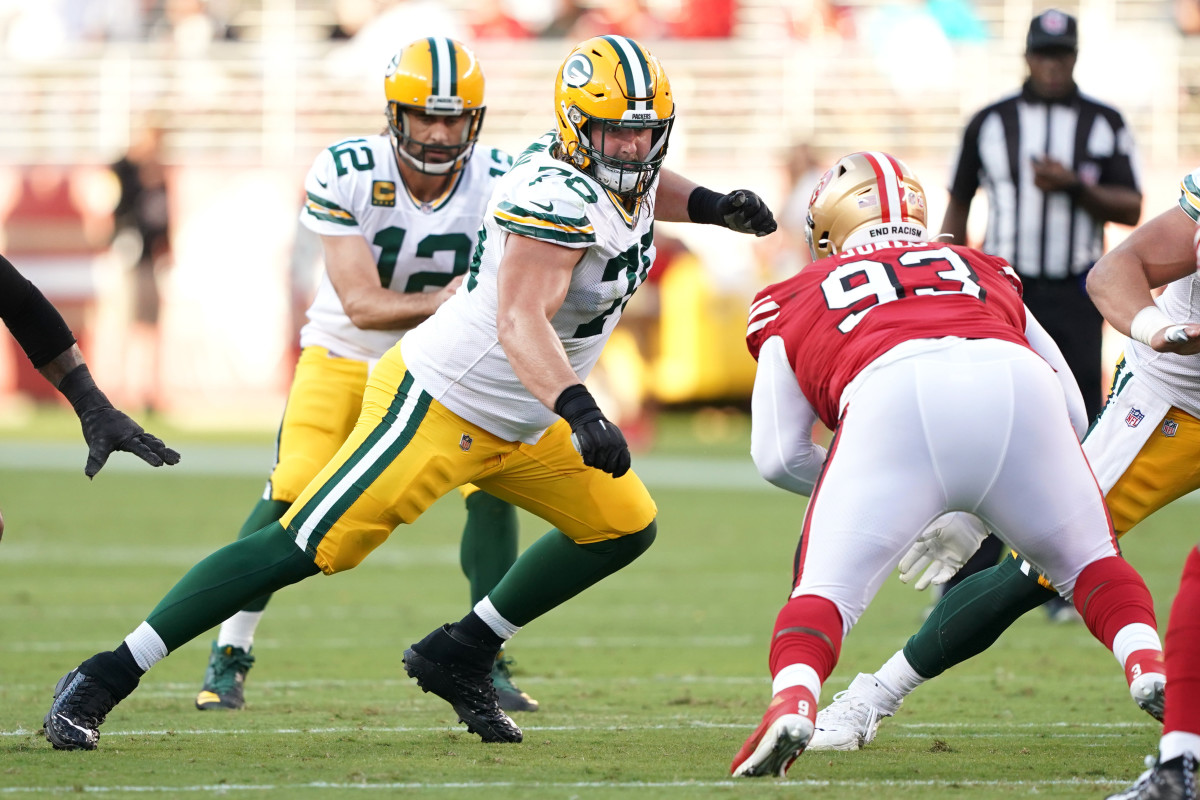
Newman was a surprise fourth-round pick after starting at guard and tackle at Ole Miss. A scout at the time noted Newman’s position flexibility but said he wasn’t good at any of those positions. With a late push, he earned a spot in the starting lineup coming out of training camp. He started the first 16 games, enduring some obvious rookie struggles before settling in and playing much better from a fundamentals and awareness perspective down the stretch.
According to PFF, 63 guards played at least half the offensive snaps. Newman finished 39th in its pass-blocking efficiency with six sacks and 32 total pressures. However, he allowed only one sack during the final eight games. SIS charged him with nine blown blocks in the run game (2.3 percent). He was penalized five times (three holding).
With the return of Myers, veteran Lucas Patrick slid over to right guard and Newman was benched for the finale and the playoff game. Still, with all that experience (an offense-high 1,084 snaps), a strong second season should be the expectation.
Grade: C-plus.
RT Billy Turner ($4.85 million cap charge; ranking No. 43 among OTs)
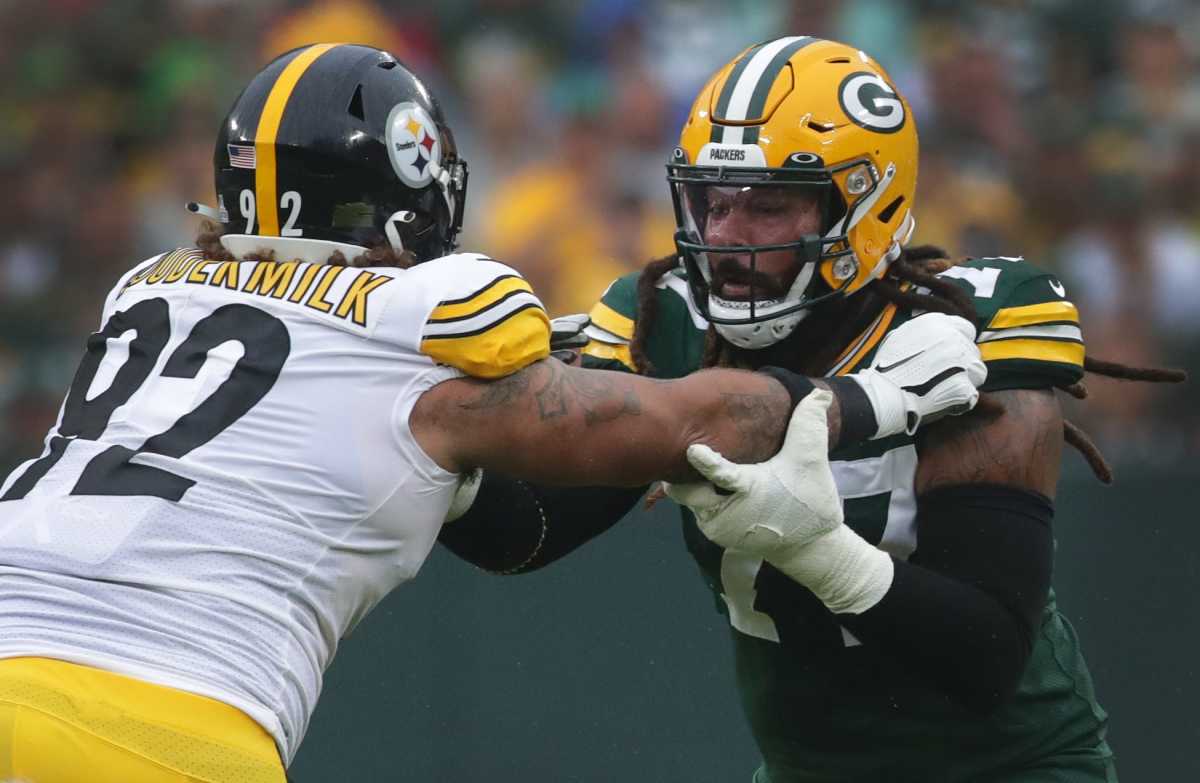
Turner started the first 13 games before joining Bakhtiari, Jenkins and Myers on the sideline with knee injuries. Quarterback Aaron Rodgers hyped him as a Pro Bowl-caliber right tackle. That might have been a bit of hyperbole but Turner was having perhaps his best season before the injury.
According to PFF, 58 offensive tackles played at least 590 snaps. Turner ranked 40th in its pass-blocking efficiency with three sacks and 32 total pressures. SIS only charged Turner with one sack – a far cry from 12 as the right guard in 2019 and five as the right tackle in 2020. In the run game, he was charged with seven blown blocks (2.4 percent). He was penalized three times (two holding).
Turner returned for the playoff game against San Francisco and got the call at left tackle. It was a surprising decision by coach Matt LaFleur, considering Turner’s layoff and how well Yosh Nijman played there earlier in the season. Turner wasn’t the problem against the 49ers, though. With a cap charge of $9.17 million for 2022, the Packers could move on and save about $3.36 million.
Grade: B-minus.
OT Yosh Nijman ($850,000 cap charge; ranking No. 111 among OTs)
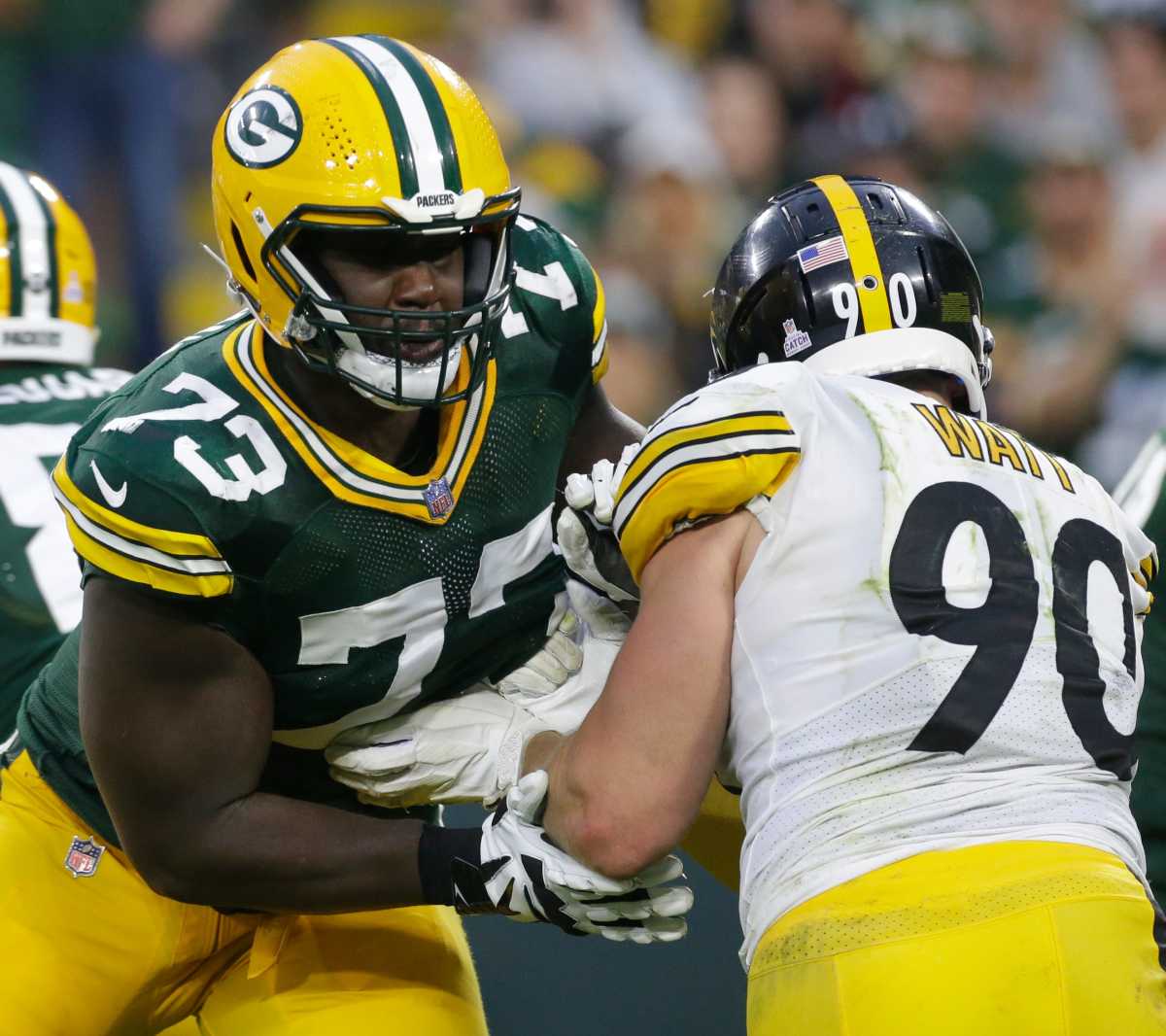
Nijman was one of the great stories of the season. An undrafted free agent in 2019, he hadn’t played a single meaningful snap from scrimmage before offensive line coach Adam Stenavich picked him to replace Elgton Jenkins at left tackle for the Week 3 game against Nick Bosa and the 49ers. No challenge, right? Nijman held his own in that game and really became an asset.
He wound up starting eight games. Of the 58 offensive tackles to play at least Nijman’s 590 snaps, he finished 31st in PFF’s pass blocking efficiency with three sacks and 20 total pressures. Remember, he was playing left tackle, which meant games against premier pass rushers such as Bosa, Cincinnati’s Trey Hendrickson (first in pressures from the defense’s right side), Cleveland’s Myles Garrett (second) and Chicago’s Robert Quinn (fourth). SIS charged him with seven blown blocks in the run game (3.2 percent) but he generally was an asset in that part of the game. He was guilty of two penalties (zero holding).
After such a promising season, will the Packers give him the job at right tackle for next season? Or will his lot in life be the swing tackle?
Grade: B-plus.
OT Dennis Kelly ($1.33 million cap charge; ranking No. 83 among OTs)
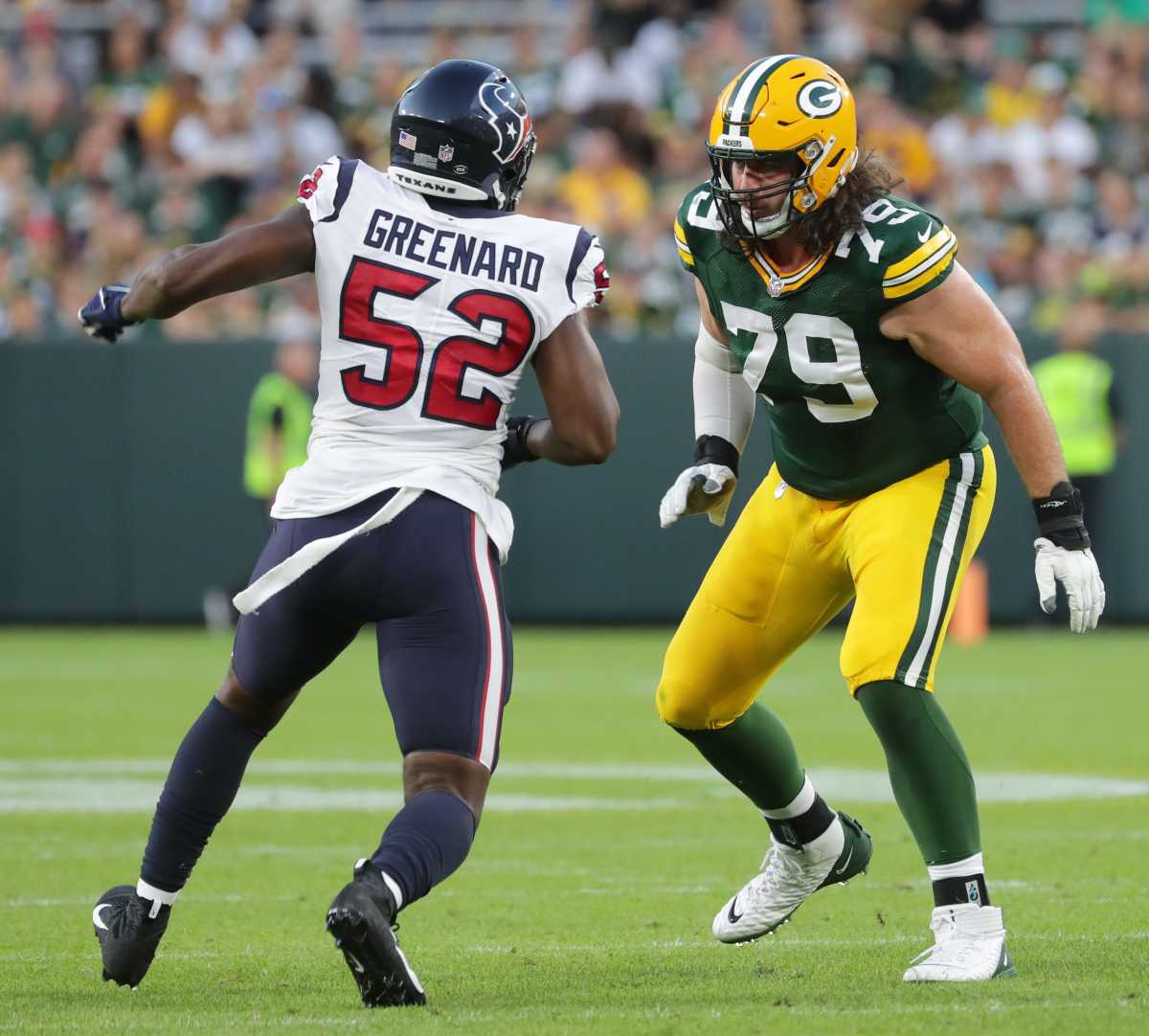
First-round draft picks and big moves in free agency get the headlines, but it’s the understated moves that make a quality general manager. That includes general manager Brian Gutekunst’s addition of defensive stars De’Vondre Campbell and Rasul Douglas but also Kelly, who was signed at the start of training camp. Kelly, who turned 32 last month, was a 16-game starter last season for Tennessee who was signed to provide key depth with Bakhtiari out of action.
For Green Bay, he played a total of 21 snaps – all on special teams – through Week 13. Then, Turner went down and the glass was broken on the fire extinguisher that was Kelly. In about 4 1/2 games, he was excellent. He allowed one sack and four total pressures and proved to be an excellent run blocker. The playoff game didn’t go nearly as well, though. Charged with blocking Bosa, PFF charged him with one sack – a drive-killer late in the first half – and five pressures. Kelly will be a free agent; the Packers could do a lot worse than bringing him back.
Grade: C.
G/C Lucas Patrick ($2.09 million cap charge; ranking No. 40 among OGs or No. 24 among OCs)
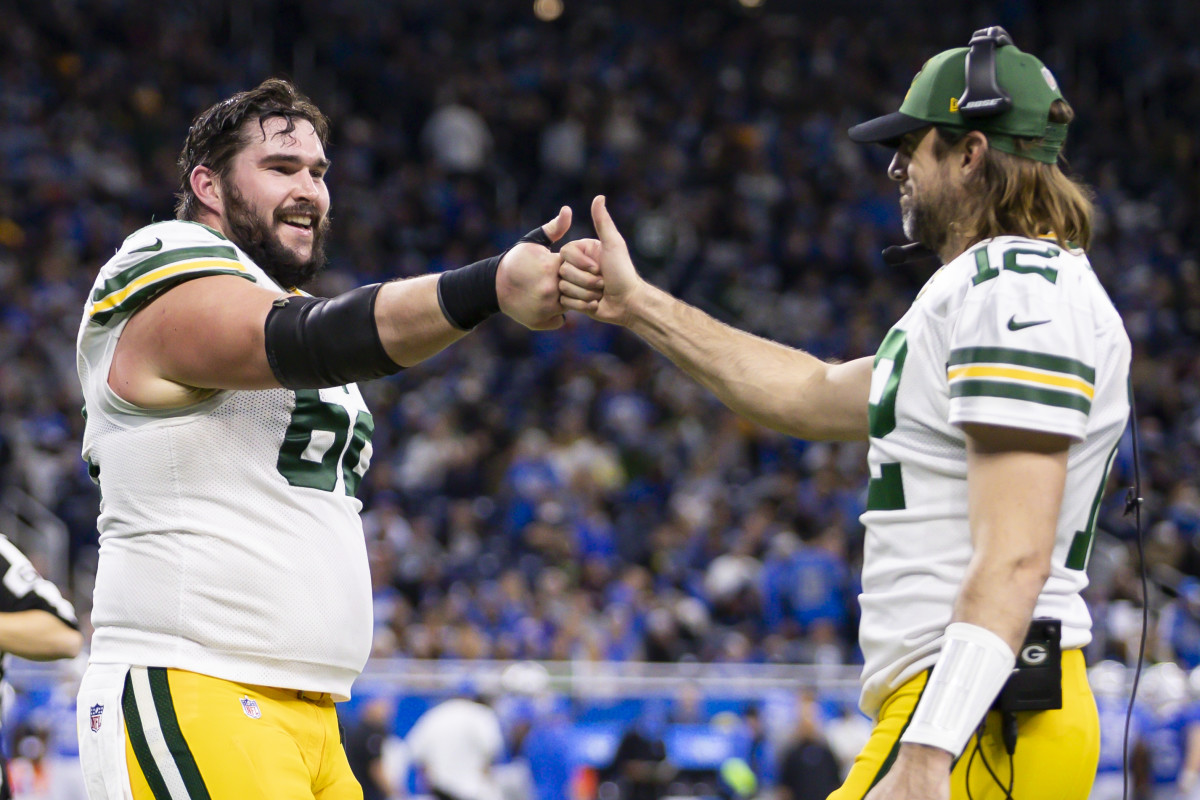
The Packers try to get rid of Patrick every season, it seems. And every year, he grabs a more and more important role. Deemed a potential cap casualty, Patrick instead beat out Jon Runyan for the starting job at left guard. When he suffered a concussion at the end of the Week 1 game against Jacksonville, the door was open for Runyan to move into the starting lineup. Patrick returned to action, though, for an injured Myers and played practically every snap at center the next 12 games. When Bakhtiari and Myers were back for the finale, Patrick moved to right guard.
All told, Patrick started 13 games at those three positions. PFF charged him with one sack and 18 total pressures. Of the 39 centers who played Myers’ total of 293 snaps, Patrick ranked 14th in PFF’s pass-blocking efficiency with one sack and 18 total pressures. SIS charged him with six blown blocks (1.8 percent). He was guilty of four penalties (three holding). For a 28-year-old, his game was too up and down, and he really struggled vs. San Francisco. Free agency awaits.
Grade: C-plus.
G Jon Runyan ($823,670 cap charge; ranking No. 96 among OGs)
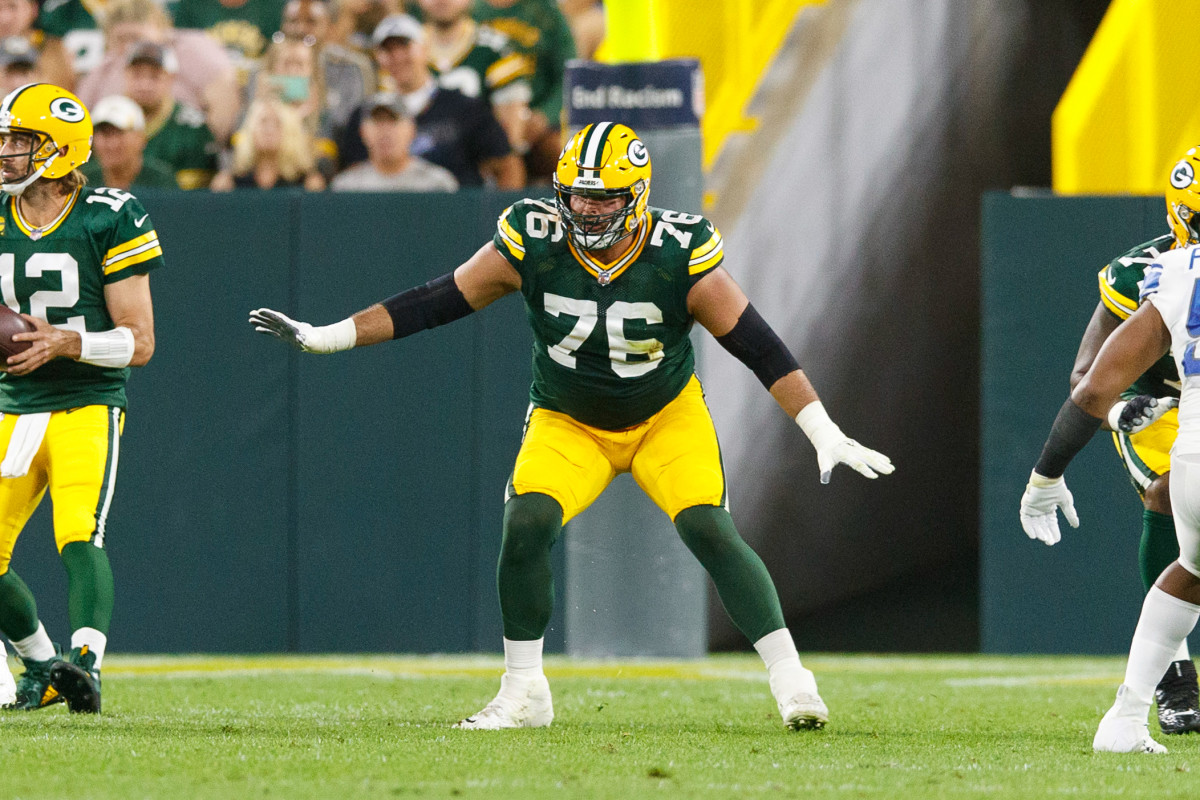
The Packers selected three offensive linemen in the sixth round of 2020. When you do such volume picking, the hope is to hit on one. The Packers probably missed on the second of those picks (center Jake Hanson), definitely missed on the third of those picks (guard Simon Stepaniak) but hit on the first of those selections (Runyan).
With Bakhtiari out and Jenkins sliding to left tackle, Runyan started the final 16 games. Of 63 guards with 50 percent playing time, he finished eighth in PFF’s pass-blocking efficiency with two sacks (both against Washington in Week 7) and 20 total pressures. According to SIS, he had six blown blocks in the run game (1.5 percent). He was guilty of one penalty (zero holding). For the price in terms of dollars and draft capital, Runyan was a big-time bargain.
If everyone is healthy for training camp, it will be interesting to see how Runyan fits in the puzzle.
Grade: B.
C Jake Hanson ($660,000 cap charge; ranking No. 56 among OCs)
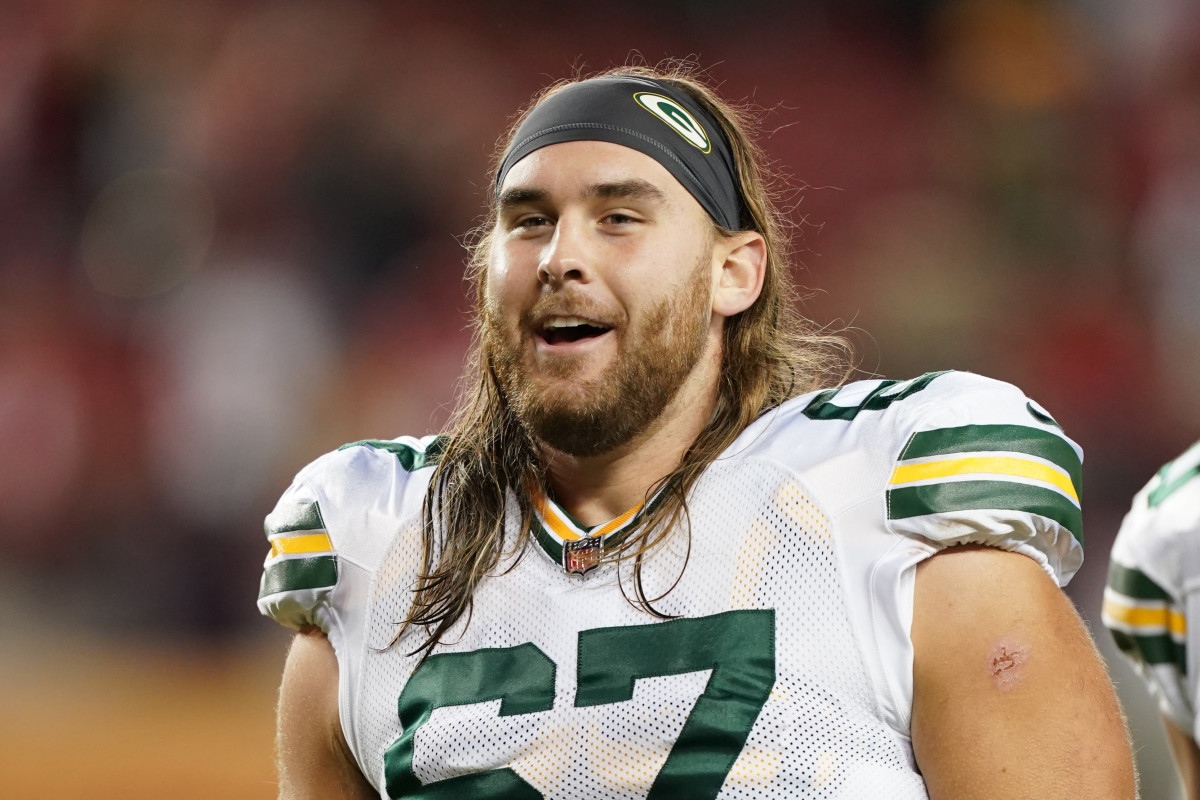
A sixth-round pick in 2020, Hanson surprisingly beat out Ben Braden for the final roster spot on the offensive line. That shows how highly the Packers value the center position. Hanson logged six snaps on offense (five vs. Kansas City) and 13 on special teams (nine vs. Cincinnati). With Patrick headed to free agency, the door potentially is open for Hanson to be the backup at the position. As quarterback Aaron Rodgers has said for the years, being the No. 2 center means a guaranteed roster spot.
Grade: F.
T/G Cole Van Lanen ($248,001 cap charge; ranking No. 140 among OGs)
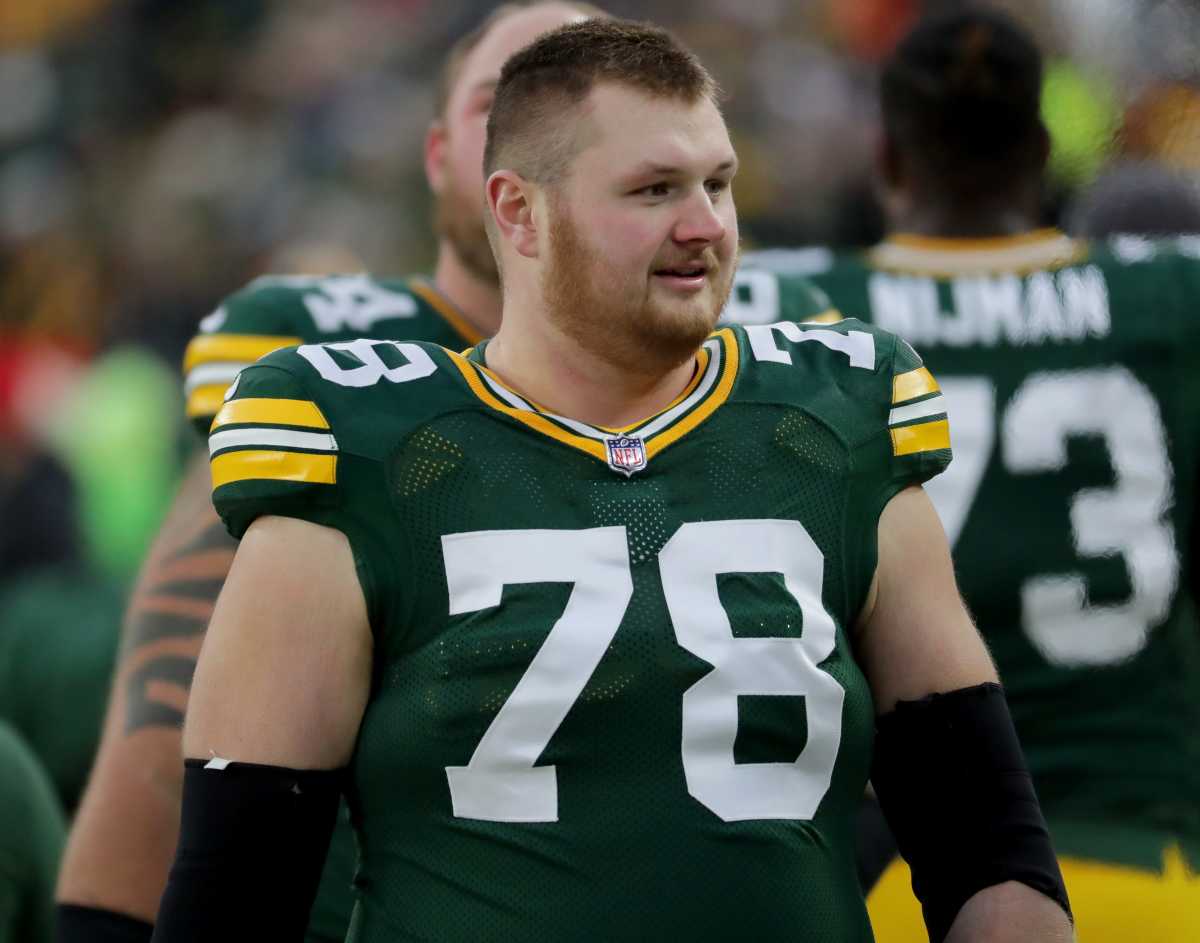
A sixth-round pick out of Wisconsin via nearby Bay Port High School, Van Lanen played one snap on offense (a kneeldown to end the Minnesota game) and zero on special teams. A left tackle for the Badgers, he spent the season at guard and right tackle. Now that the team has a feel for what he can do, it will be interesting to see if he can push for a key backup position during training camp. He must get stronger. The grade isn’t a knock on his potential.
Grade: F.
Grading the Defensive Line
Kenny Clark ($6.98 million cap charge; ranking No. 21 among interior defensive linemen)
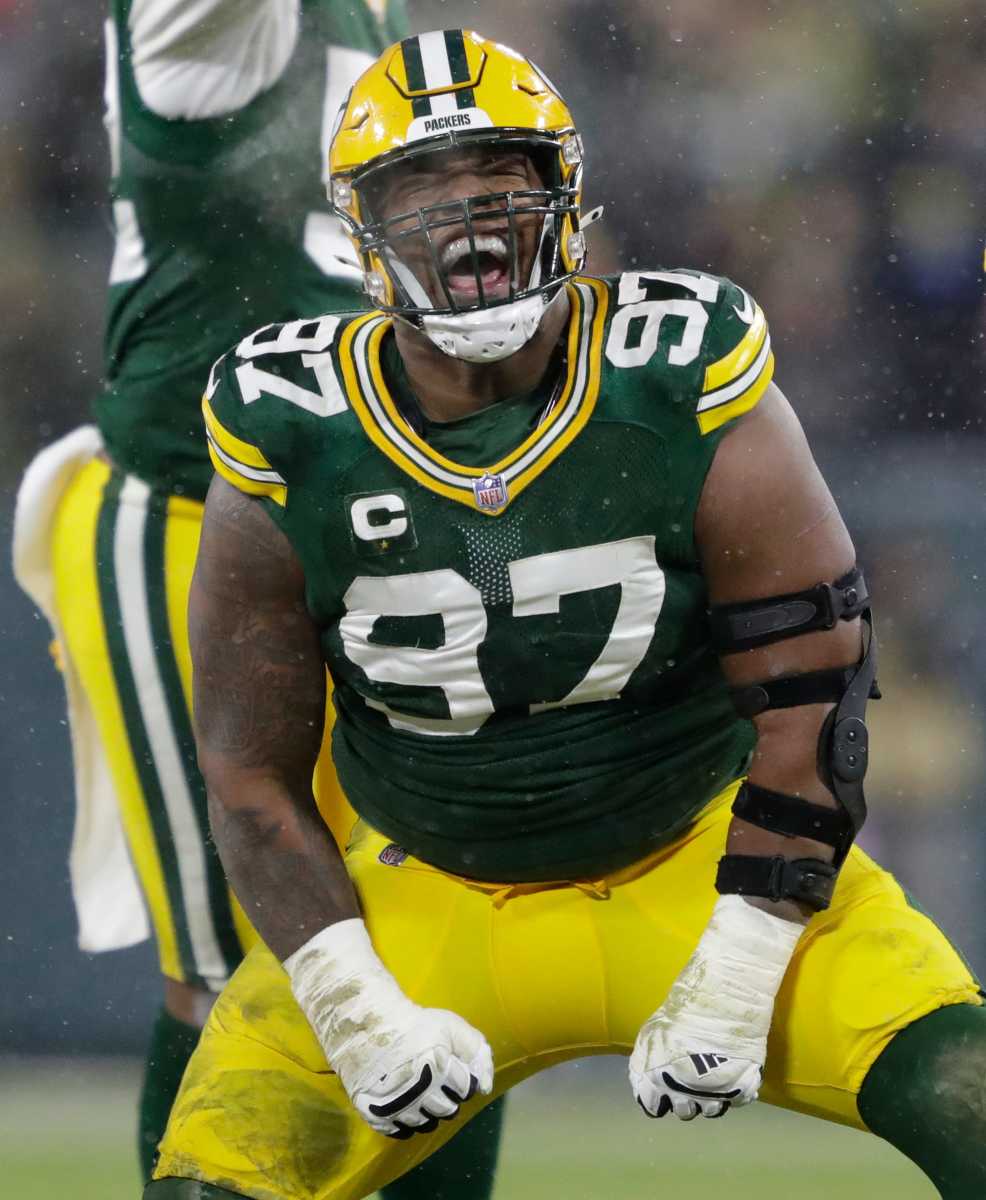
Just like he did in 2019, Clark earned Pro Bowl honors by rushing the passer and commanding double teams. Clark recorded 48 tackles, four sacks, six tackles for losses and 13 quarterback hits. That’s better than his 42 tackles, two sacks, three tackles for losses and six quarterback hits in 2020 but not as good as his 62 tackles, six sacks, nine tackles for losses and seven quarterback hits in 2021.
As a pass rusher, he was really good. While the sack total was nothing to write home about, he finished fourth interior defensive linemen with a career-high 67 pressures, according to PFF. In its pass-rushing productivity, he ranked eighth out of 127 interior defenders with at least 136 rushes (TJ Slaton’s number).
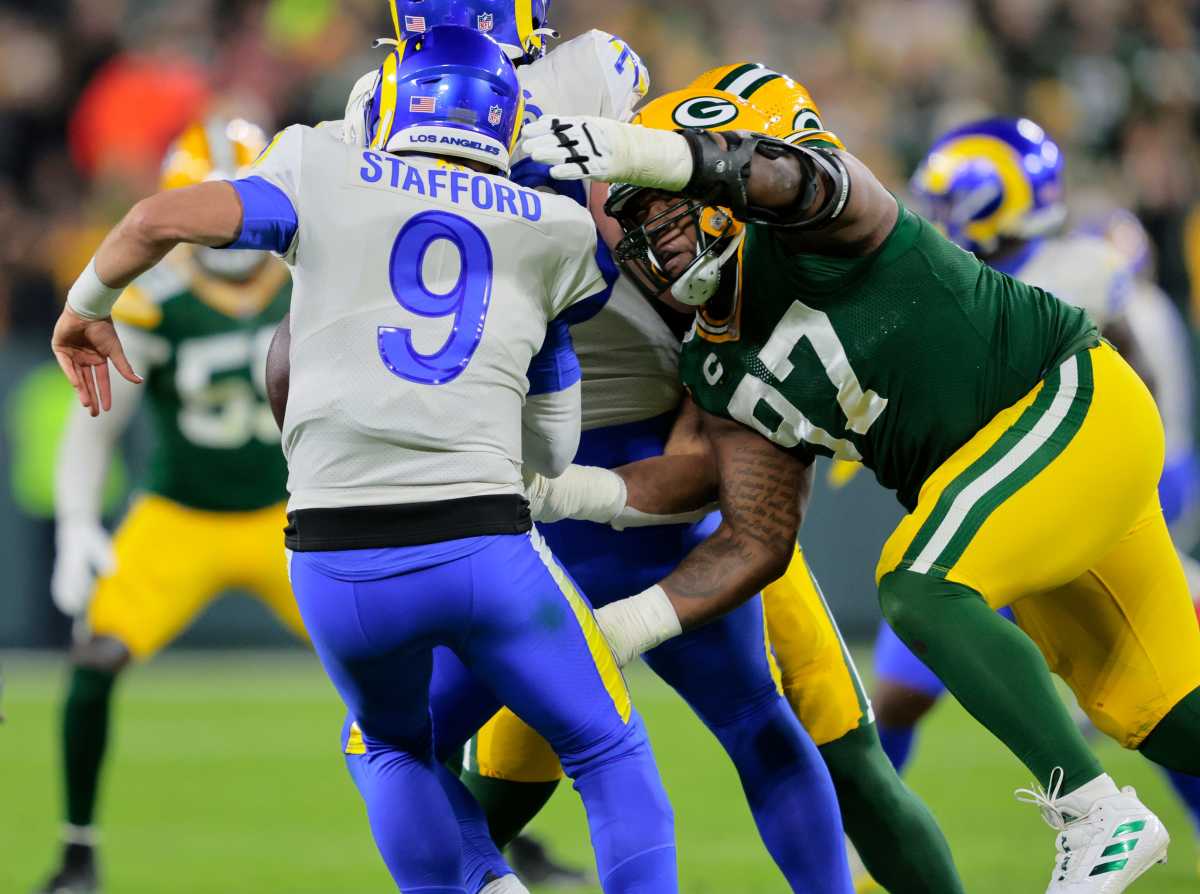
His run defense wasn’t quite as good as it was in 2019, though. Of 135 interior defenders who played at least 114 snaps on run defense (Slaton’s number), he tied for 31st with a run-stop percentage of 9.2 and tied for 40th with an average tackle distance of 2.1 yards downfield. Statistically, Green Bay’s run defense was no better with Clark in the lineup than when he was off the field.
Clark was a workhorse, logging 80 percent playing time in 13 games. Among all interior defenders, he ranked 12th with 781 snaps. His tackle rate was one for every 16.3 snaps. As good as he is, there’s room for improvement.
Grade: B.
Dean Lowry ($3.81 million cap charge; ranking No. 43 among IDL)
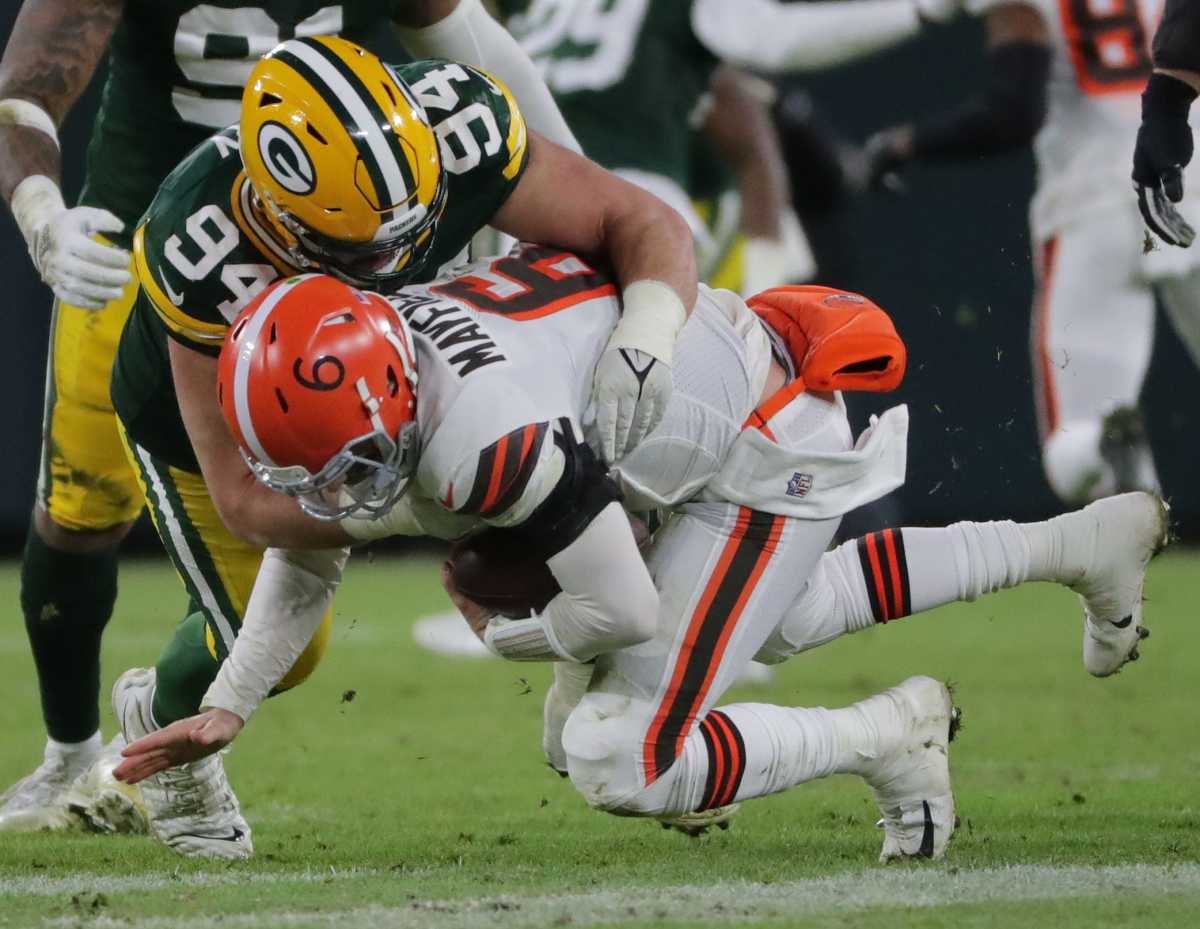
Lowry started every game for a third consecutive season. Along with his 42 tackles, he set a career high with five sacks. After a combined three sacks, six quarterback hits and four tackles for losses in 32 games in 2019 and 2020, Lowry had the five sacks, nine quarterback hits and five tackles for losses in 2021. So, from a splash-play perspective, Lowry was excellent.
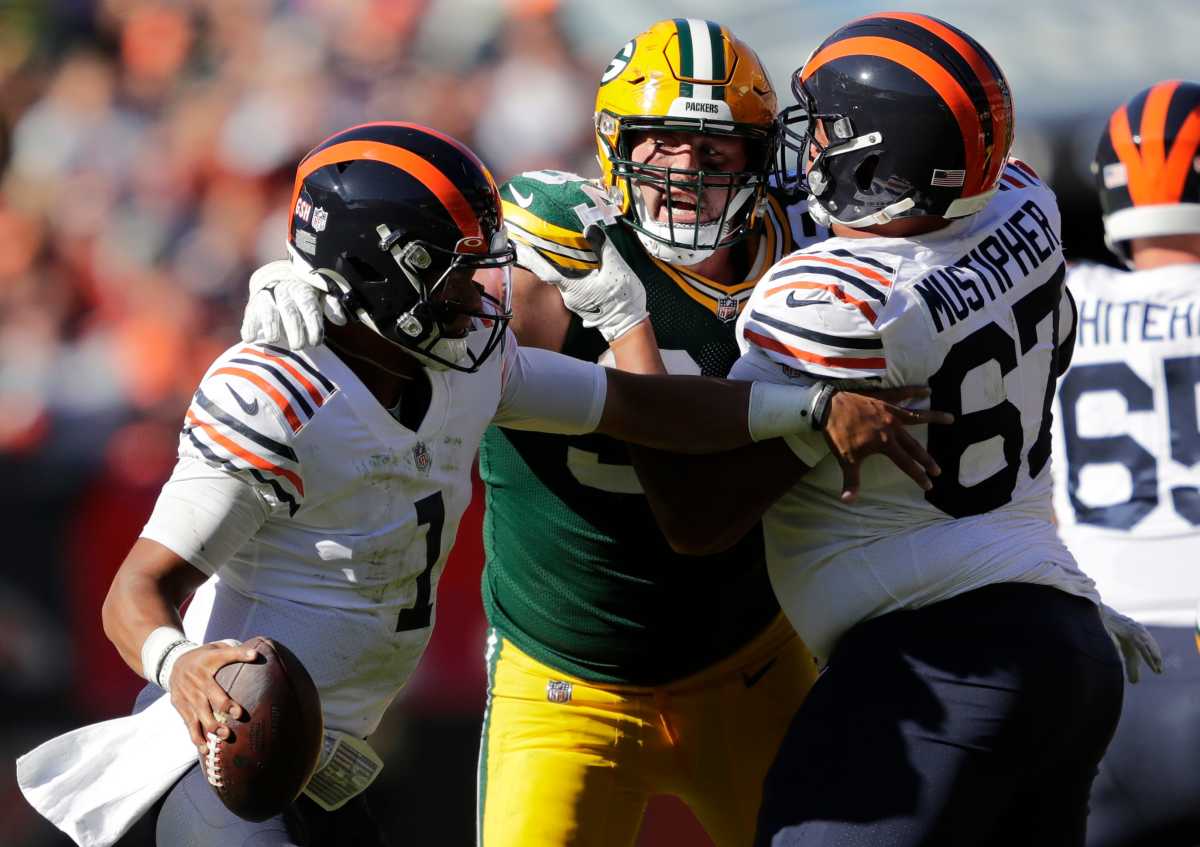
Lowry finished 17th in PFF’s pass-rushing productivity. His 42 pressures were three more than his combined total from the previous two seasons. However, against the run, his average tackle came 2.9 yards downfield and his 3.3 run-stop percentage ranked a terrible 126th out of the aforementioned 135 interior defenders. The team allowed 0.11 yards more per carry with Lowry on the field than when he was off. He did, however, match Clark’s unit lead with seven stuffs (a tackle at or behind the line vs. the run). His tackle rate of one for every 16.0 snaps was just a bit better than Clark.
In eight career playoff games, Lowry has zero sacks, zero quarterback hits and zero tackles for losses.
Grade: C.
Tyler Lancaster ($1.25 million cap charge; ranking No. 92 among IDL)
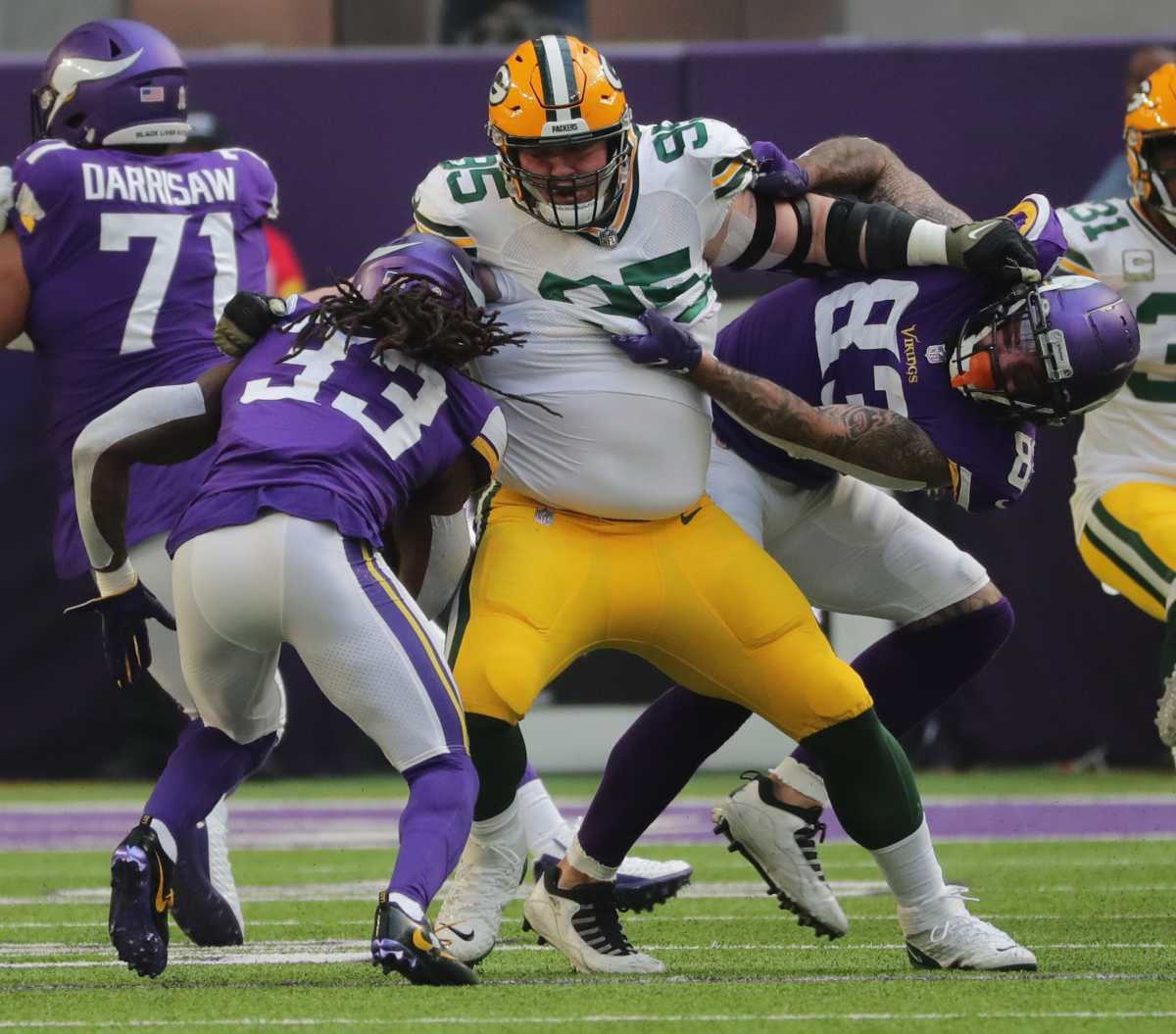
Lancaster did what he usually does: play no-nonsense run defense. His 31 tackles included three for losses. That TFL count matched his total from his first three seasons. Two of those came at Minnesota, when he delivered the best performance of his career. His season tackle rate was one for every 10.3 snaps, tops on the unit.
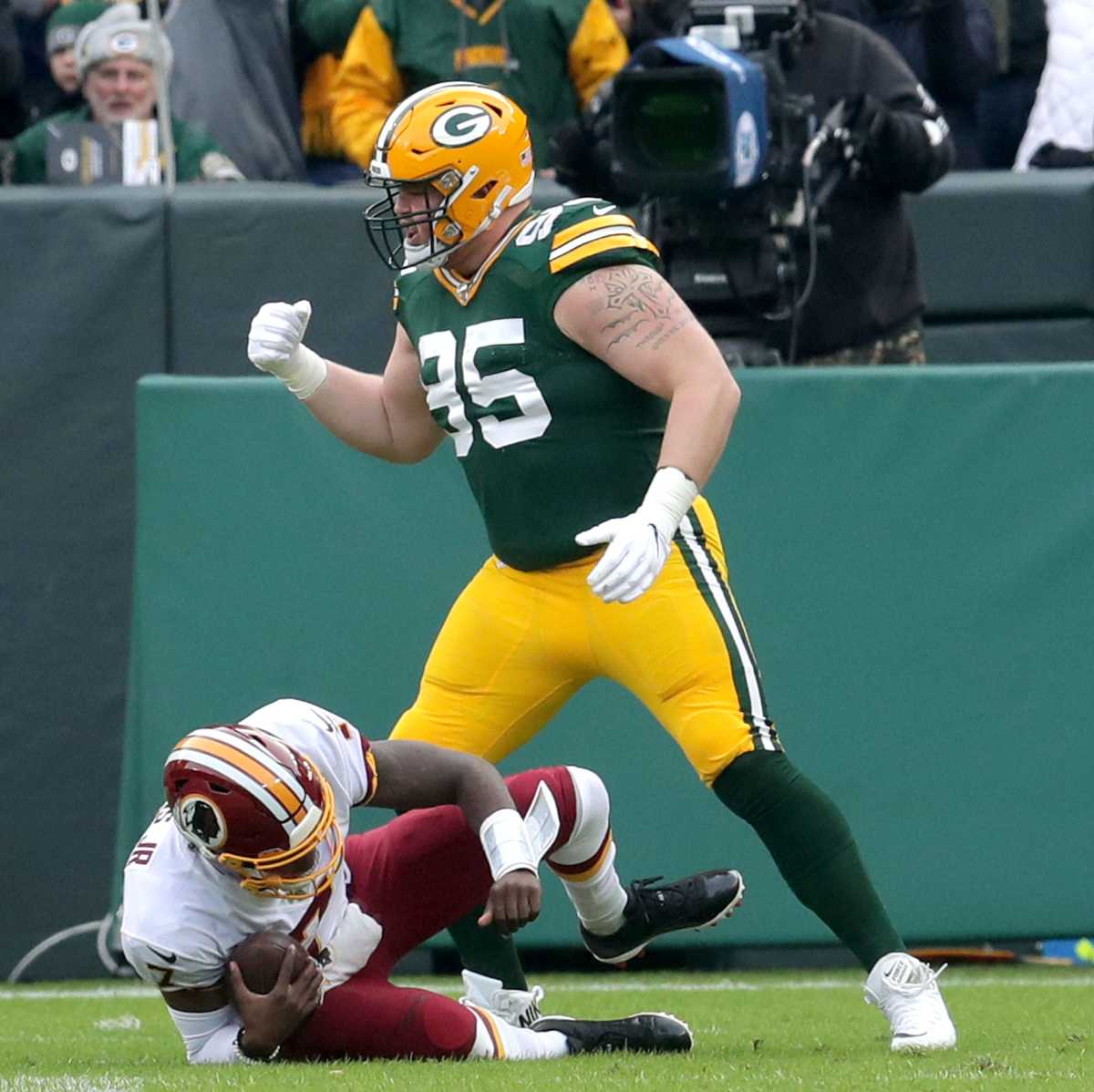
Of the 135 interior defensive linemen with at least 114 run-defending snaps, he tied for 23rd in PFF’s run-stop percentage. His average tackle came 2.3 yards downfield and he had six stuffs, one behind Clark and Lowry for the unit lead. The team’s run defense was a resounding 0.65 yards better when he was on the field. He did nothing as a pass rusher, though, ranking 120th out of 127 in PFF’s pass-rush productivity with just four pressures in 142 passing plays. In four seasons, he has 1.5 sacks and 20 pressures.
Lancaster will be a free agent. It’s not as if the team is bursting at the seams with run-stopping big guys.
Grade: C.
Kingsley Keke ($928,316 cap charge; ranking No. 118 among IDL)
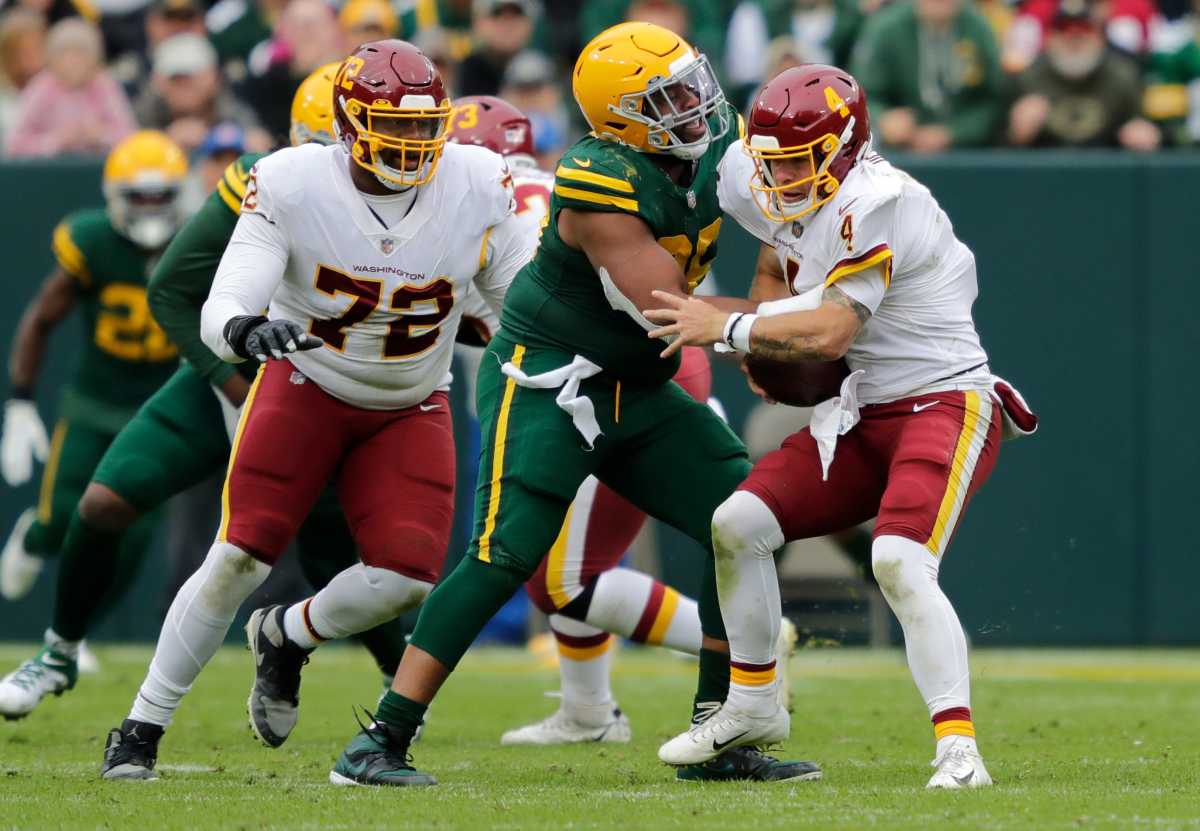
A fifth-round pick in 2019, Keke showed his promise last season with four sacks and eight quarterback hits in 15 games (nine starts). This season went horribly wrong, though. On the field, he was OK, with 2.5 sacks and four quarterback hits in 12 games (eight starts). He added 23 tackles, a tackle rate of one for every 17.1 snaps. However, he missed time with a concussion, was inactive for the final three games and released before the playoffs. Teams aren’t in a hurry to get rid of good players – especially big guys who can rush the passer – so the issues were more personality-related.
He ranked 33rd out of 127 interior defenders in PFF’s pass-rushing productivity with a career-high 24 pressures. Of 135 interior defenders, he ranked 70th in PFF’s run stop percentage. While average tackle came 3.3 yards downfield, the team’s run defense was 0.17 yards better when he was on the field.
Keke quickly landed with the Texans, so he’ll spend Year 4 closer to home. His performance on the field was worthy of a C-plus.
Grade: F.
TJ Slaton ($730,130 cap charge; ranking No. 149 among IDL)
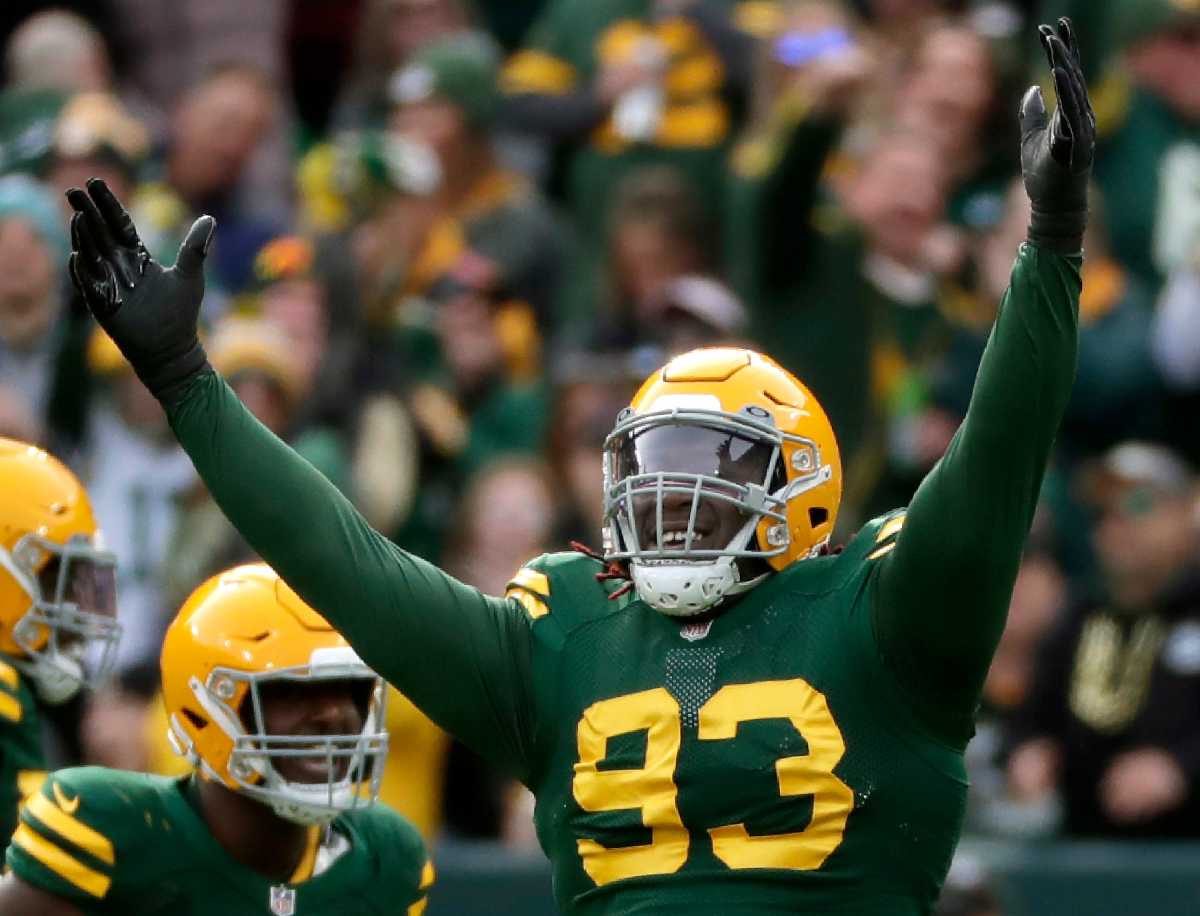
A fifth-round pick this year who was blessed with outstanding athleticism for his size, Slaton played 255 snaps, with almost half of those coming during the final four games. He finished with 23 tackles, one sack and two quarterback hits. His tackle rate was one for every 11.1 snaps.
Slaton finished 97th out of 127 in PFF’s pass-rushing productivity. Of his six pressures, three came against Seattle but only one came during the final seven games. For his size, he should have been a bigger asset vs. the run. He was 60th out of 135 in run-stop percentage. While he had zero stuffs and his average tackle came 3.3 yards downfield, the run defense was 0.71 yards better when he was on the field – the biggest difference among any defender getting regular playing time.
If the run defense is going to take a sizable step forward in 2022, it will be because of Slaton reaching his potential.
Grade: C-plus.
Jack Heflin ($662,333 cap charge; ranking No. 162 among IDL)
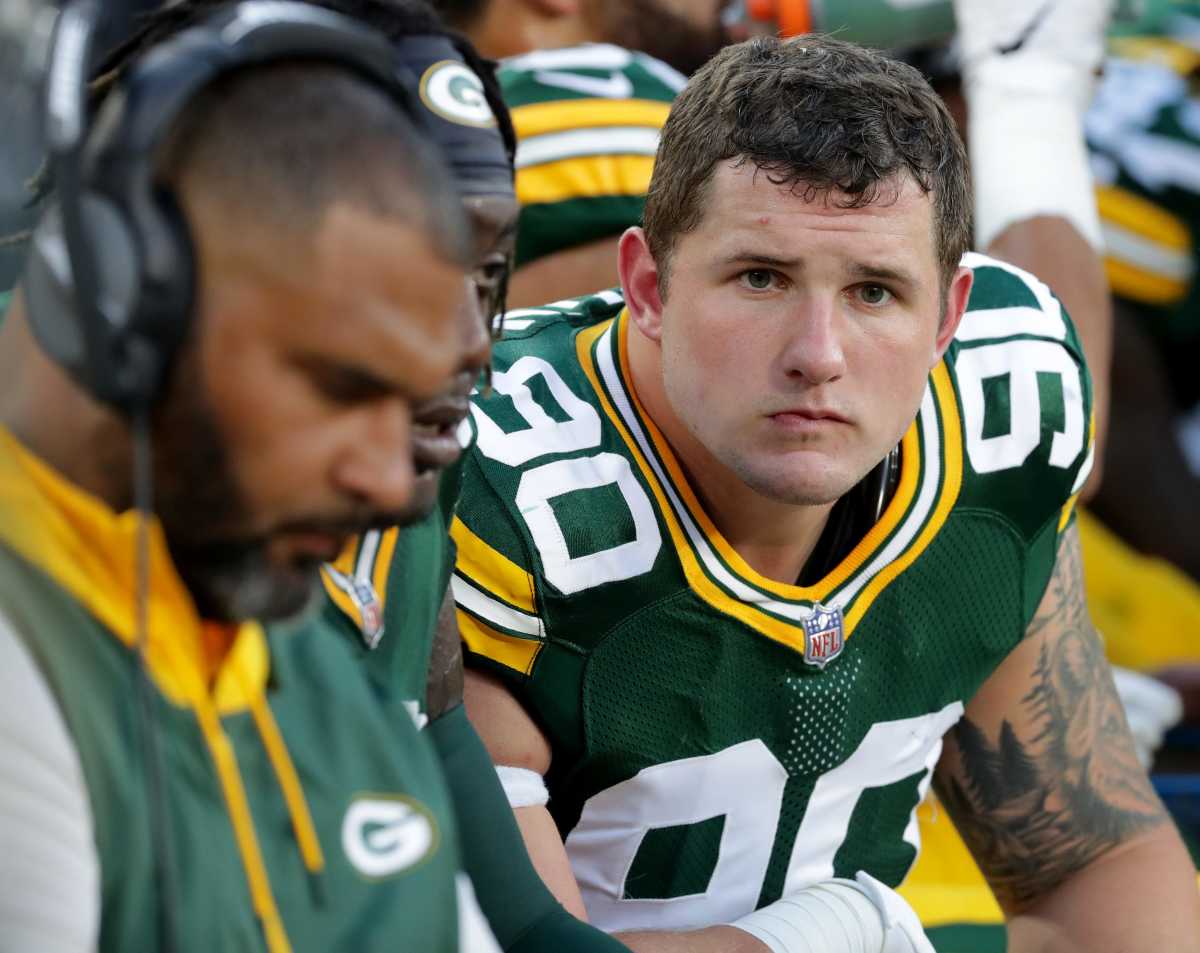
A college walk-on, Heflin was a great story in making the roster coming out of training camp. However, he barely played. Heflin’s 17 defensive snaps were split over three games. By season’s end, he had fallen behind practice-squad player Abdullah Anderson on the depth chart. He finished the season with just one assisted tackle.
Grade: F.
Grading the Outside Linebackers
Za’Darius Smith ($14.62 million cap charge; ranking No. 7 among edge defenders)
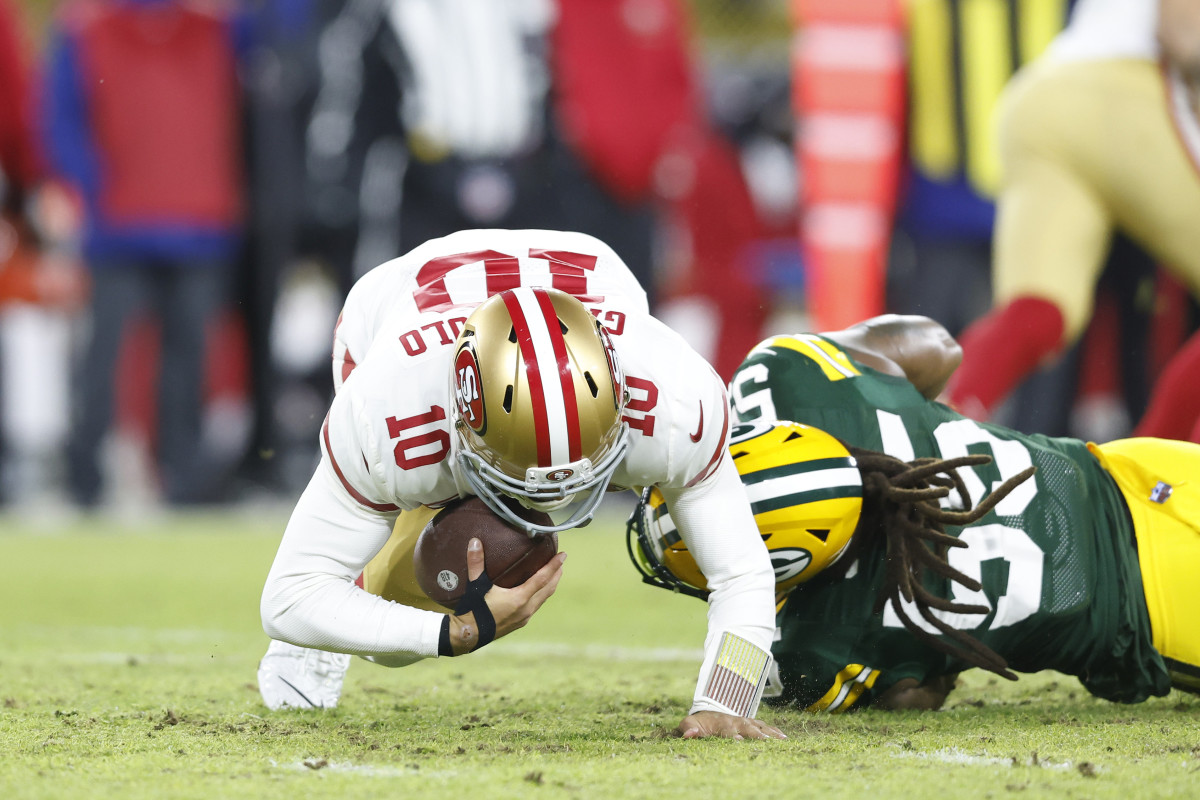
As a Pro Bowler in 2019 and 2020, Smith piled up 26 sacks, 60 quarterback hits and five forced fumbles. He was a driving force behind defenses that reached back-to-back NFC Championship Games. This season was a disaster, though. He showed up to training camp with a back injury and practiced only once. He gave it a go in Week 1 and played 18 snaps before being shut down and ultimately having surgery. He was back for the playoffs and recorded a sack on his first snap but did nothing else of note for his final 18 snaps.
So, that was it: 37 snaps, one sack.
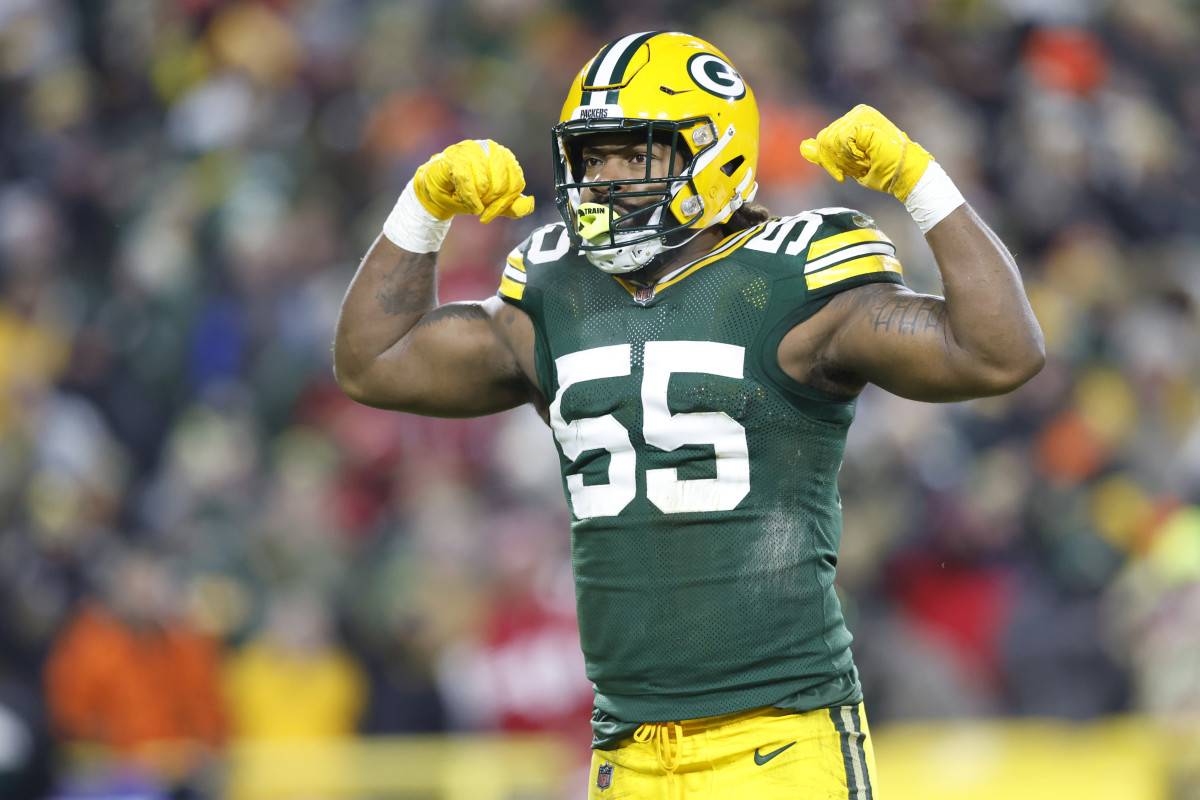
Smith was one of numerous veterans who restructured his contract to help the team get beneath the salary cap, so his base salary in 2021 was the league-minimum $990,000. His cap number for 2022, his final season under contract, will soar to $27.66 million. There’s no way he’s going to play under that contract. Either the Packers will extend him and hope for a Preston Smith-style bounce-back or they’ll dump him and save $15.28 million against the cap. To keep him, GM Brian Gutekunst better be sure of his commitment.
Grade: F.
Preston Smith ($8.73 million cap charge; ranking No. 21 among edge defenders)
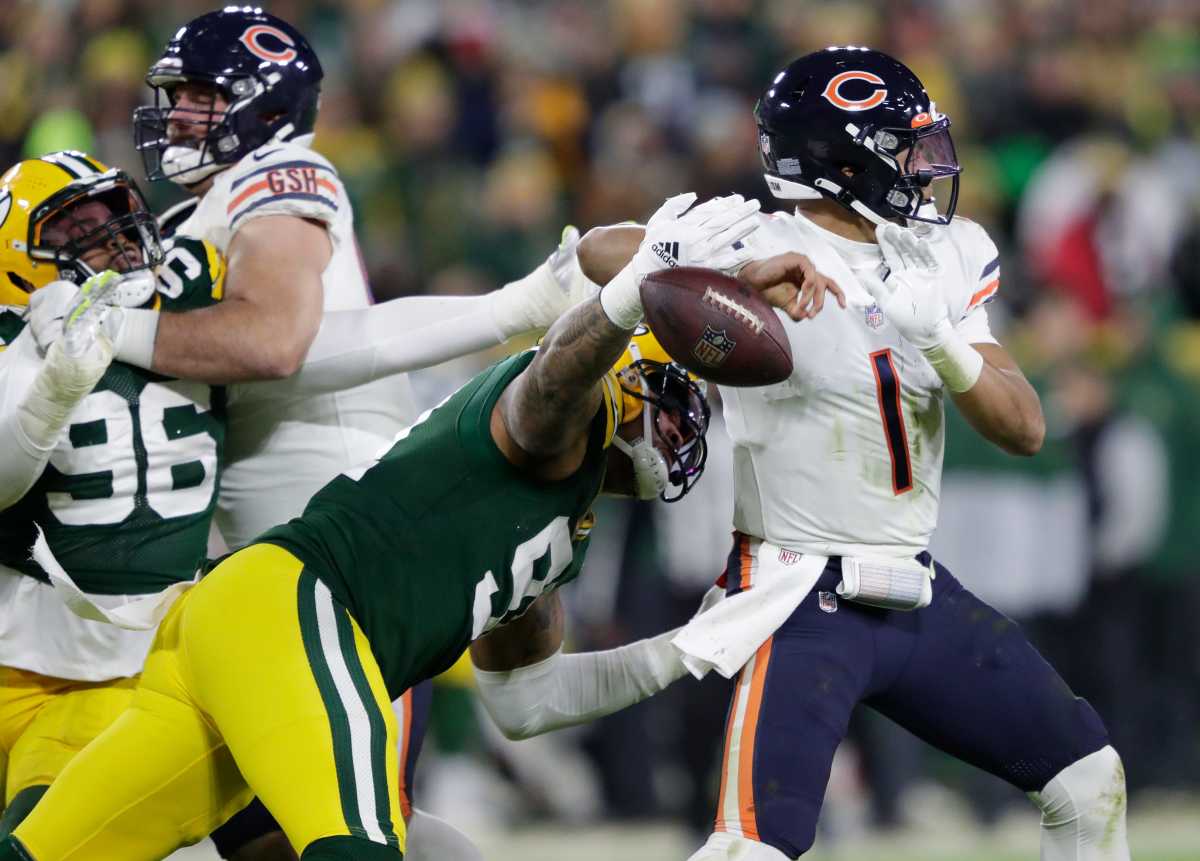
After a dismal 2020 season in which he collected only four sacks, Smith returned on an incentives-laden restructure and had a superb season with nine sacks and two forced fumbles. He was excellent in every way, from rushing the passer to run defense to leadership.
Of 80 edge defenders with at least 214 pass rushes, he tied for 15th in PFF’s pass-rushing productivity, which measures sacks, hits and hurries per pass-rushing snap. He tied for ninth with a career-high 62 pressures and was 14th with a pass-rush win rate of 18.1 percent. Against the run, he had five stuffs (a tackle at or behind the line of scrimmage). The run defense was 0.40 yards per carry better when he was on the field. He had one tackle for every 17.7 snaps.
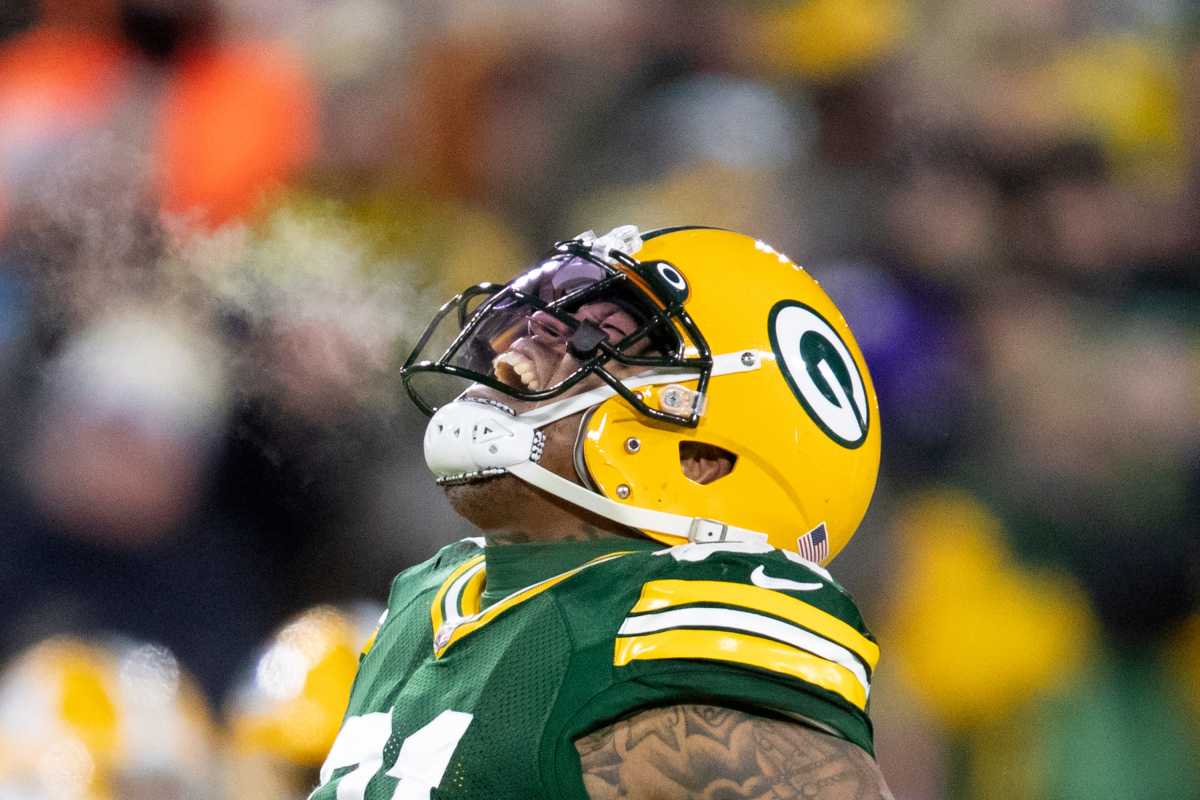
With a strong season, he’s probably in line for a contract extension. Last year’s restructure helped the team get beneath the salary cap. In 2022, his final year under contract, his cap number will soar to $19.72 million. The Packers can move on and save $12.47 million against the cap.
Grade: B.
Rashan Gary ($4.33 million cap charge; ranking No. 36 among edge defenders)
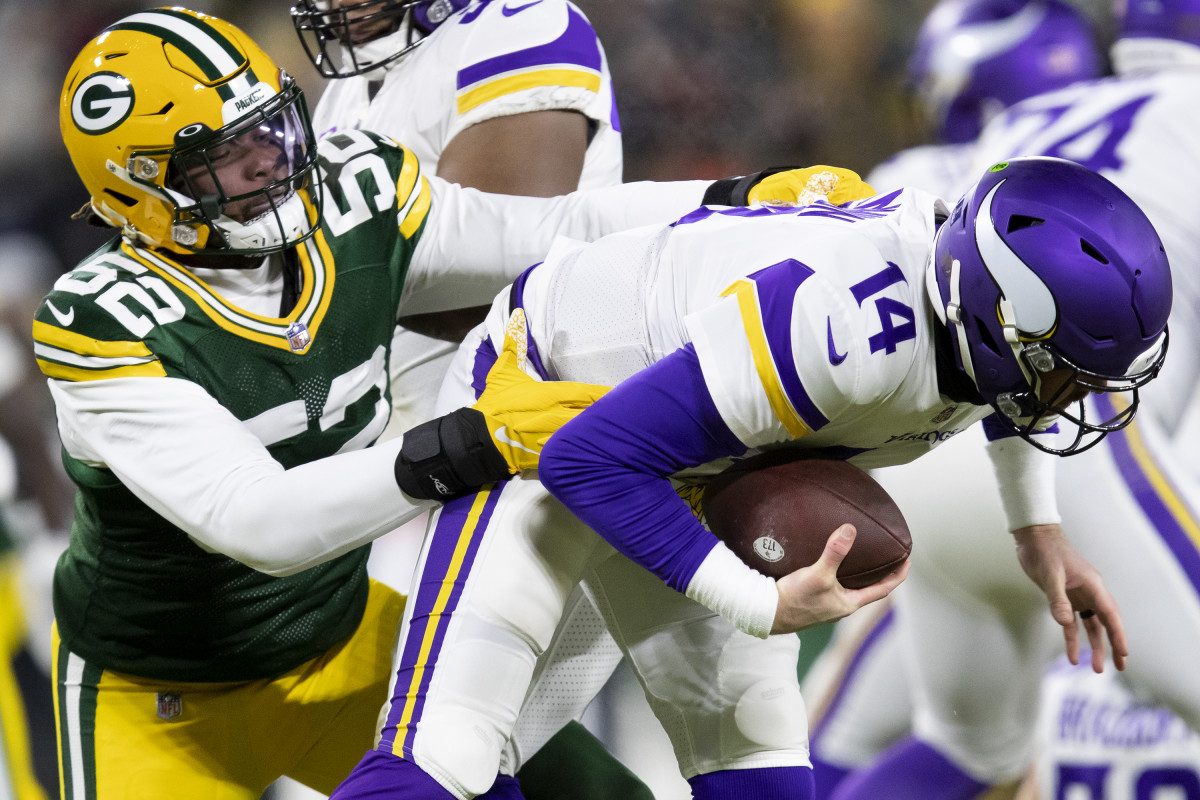
A traits-based first-round pick in 2019 who had only 3.5 sacks during his final season at Michigan, Gary backed up the belief of general manager Brian Gutekunst and outside linebackers coach Mike Smith with a fantastic third season. He led the team with 9.5 sacks and 28 quarterback hits, the latter figure almost doubling up Preston Smith’s second-ranked 15. Of the 80 edge defenders with at least 214 rushes, Gary ranked third in PFF’s pass-rushing productivity. He ranked second in the NFL in both pressures (81) and pass-rush win rate (26.0 percent). He's just so powerful and relentless.
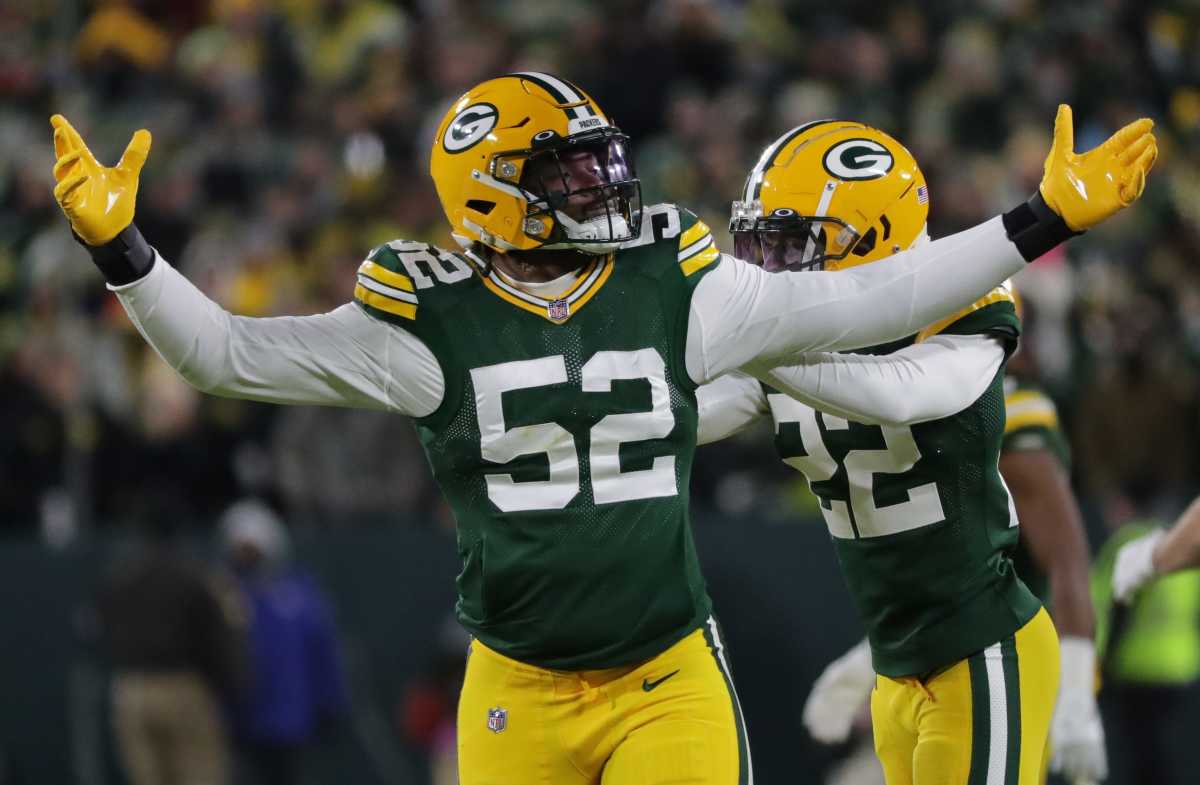
He had one tackle for every 14.8 snaps. Against the run, he had eight stuffs – most on the unit and second on the team. However, he needs to be consistently better against the run. The team’s run defense was 0.15 yards per carry when he was not on the field, which is hard to believe given his ability to set an edge through brute force. On a critical third-and-7 on the season-ending series against San Francisco, Gary charged upfield and Deebo Samuel ran right past him for a gain of 9 to set up the final field goal.
Grade: A-minus.
Jonathan Garvin ($799,821 cap charge; ranking No. 137 among edge defenders)

A seventh-round pick in 2020, Za’Darius Smith’s prolonged absence put Garvin on the field for 395 snaps – 310 more than his rookie season. He collected 19 tackles, including 1.5 sacks, in 16 games. As a pass rusher, he tied for 46th in PFF’s pass-rushing productivity. His pass-rush win rate was 12.1 percent, which tied for 58th. He had one tackle for every 20.8 snaps.
However, he was inactive for the playoffs. That was partially due to Za’Darius Smith’s return but also because he wasn’t good enough as a run defender. The run defense was 0.22 yards per carry better when he was not on the field. His average tackle vs. the run came 3.5 yards downfield – far and away the worst mark on the unit.
Grade: D-plus.
Whitney Mercilus ($716,667 cap charge; ranking No. 146 among edge defenders)
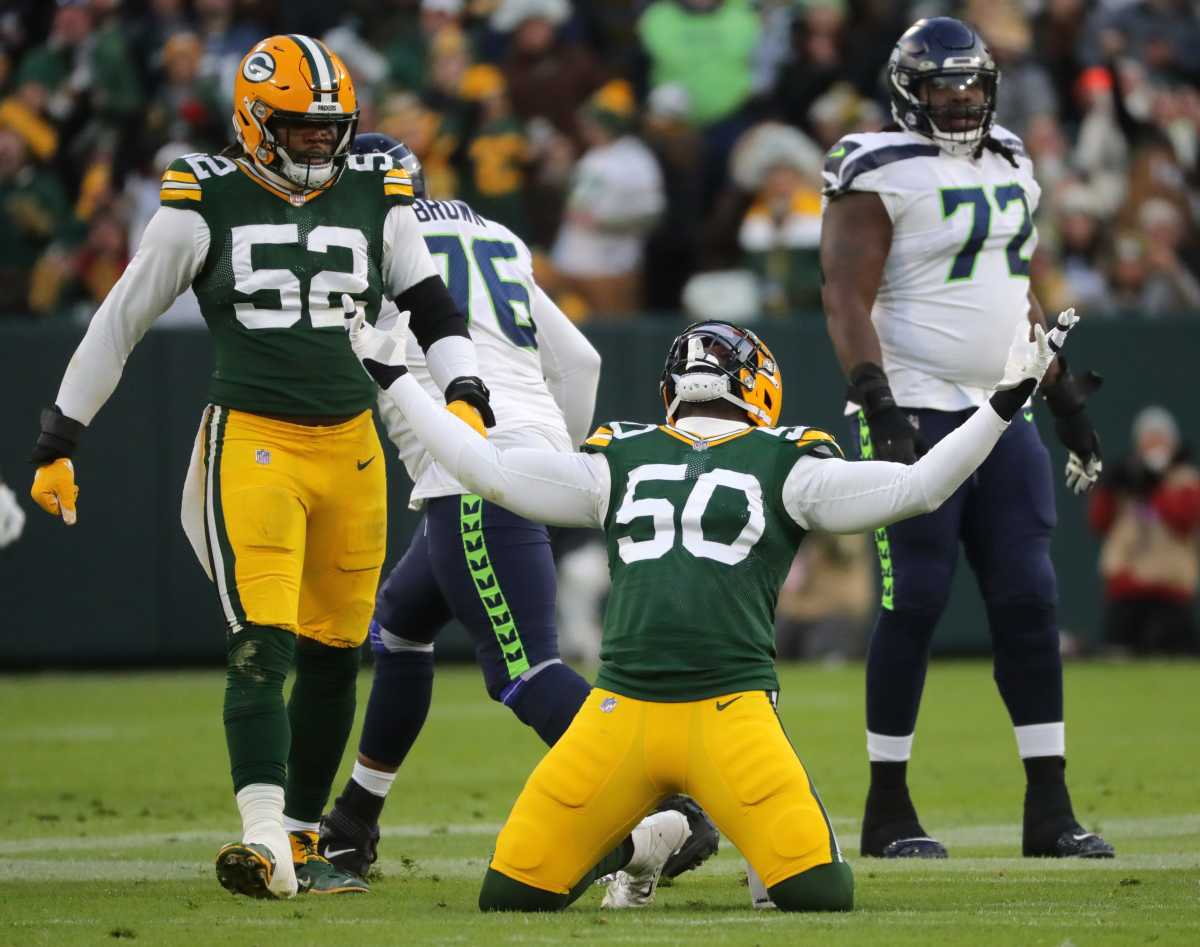
The Texans dumped the veteran after Week 6 to focus on some of their younger players. The Packers were thrilled to get him, and the change of scenery did Mercilus some good. In six games in Houston, he had two sacks and five pressures in 110 opportunities. In his first four games in Green Bay, he had one sack and 10 pressures in 80 pass-rushing snaps. He suffered a torn biceps in Week 10 against Seattle. He was back for the playoffs but didn’t do much in limited action. It was a very small sample size – he mostly played on passing downs – but his run defense was not nearly good enough. With five tackles, his tackle rate was 21.4 snaps per tackle.
Mercilus will turn 32 just before the start of training camp. If one or both of The Smith Bros. doesn’t return, he’d be a wise addition for veteran depth.
Grade: C-minus.
Chauncey Rivers ($469,444 cap charge; ranking No. 173 among edge defenders)
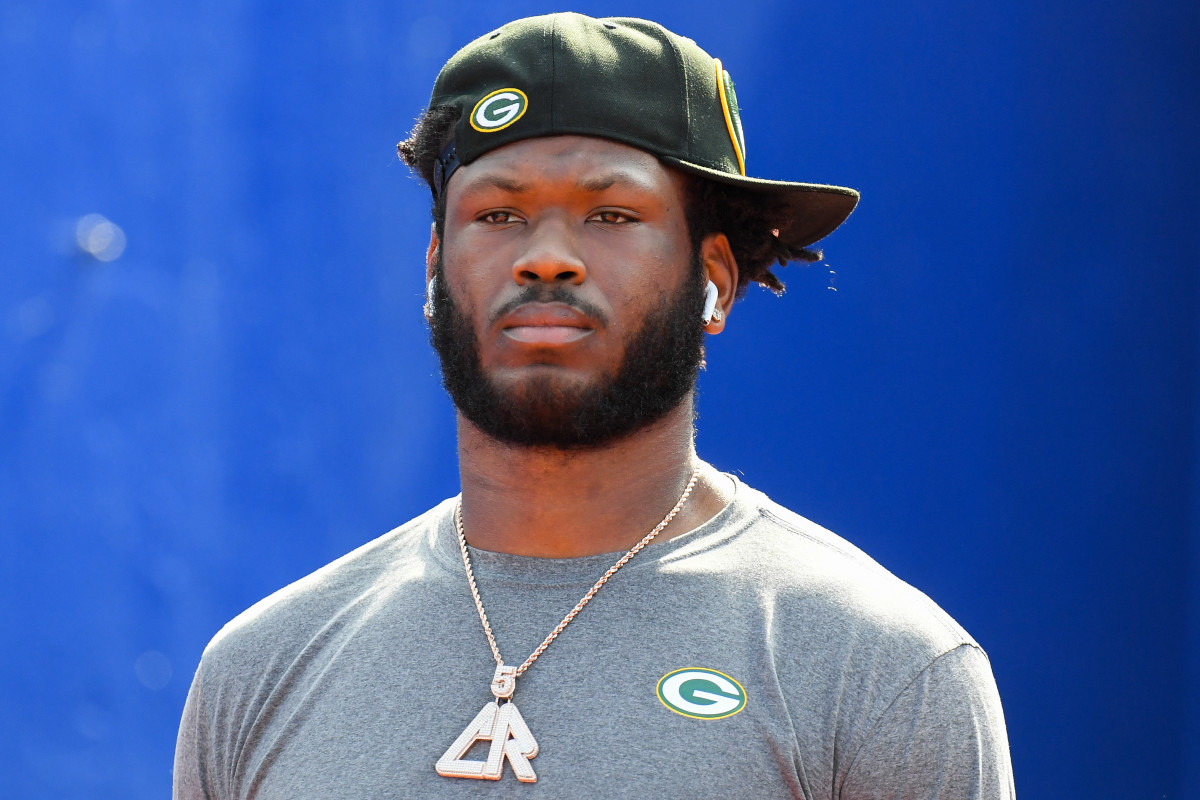
A waiver-wire addition from the Ravens, Rivers started the season as a key backup and special-teams performer before suffering a torn ACL at practice. In four games, he played 54 snaps on defense and finished with two tackles (27.0 snaps per tackle). With just one pressure in 32 chances, he finished last among the team’s outside linebackers in PFF’s pass-rushing productivity and next-to-last with a pass-rush win rate of 9.4 percent. He played another 44 snaps on special teams but didn’t get in on the action. Position coach Mike Smith liked his physicality and demeanor.
Grade: F.
Tipa Galeai ($293,333 cap charge; ranking No. 182 among edge defenders)
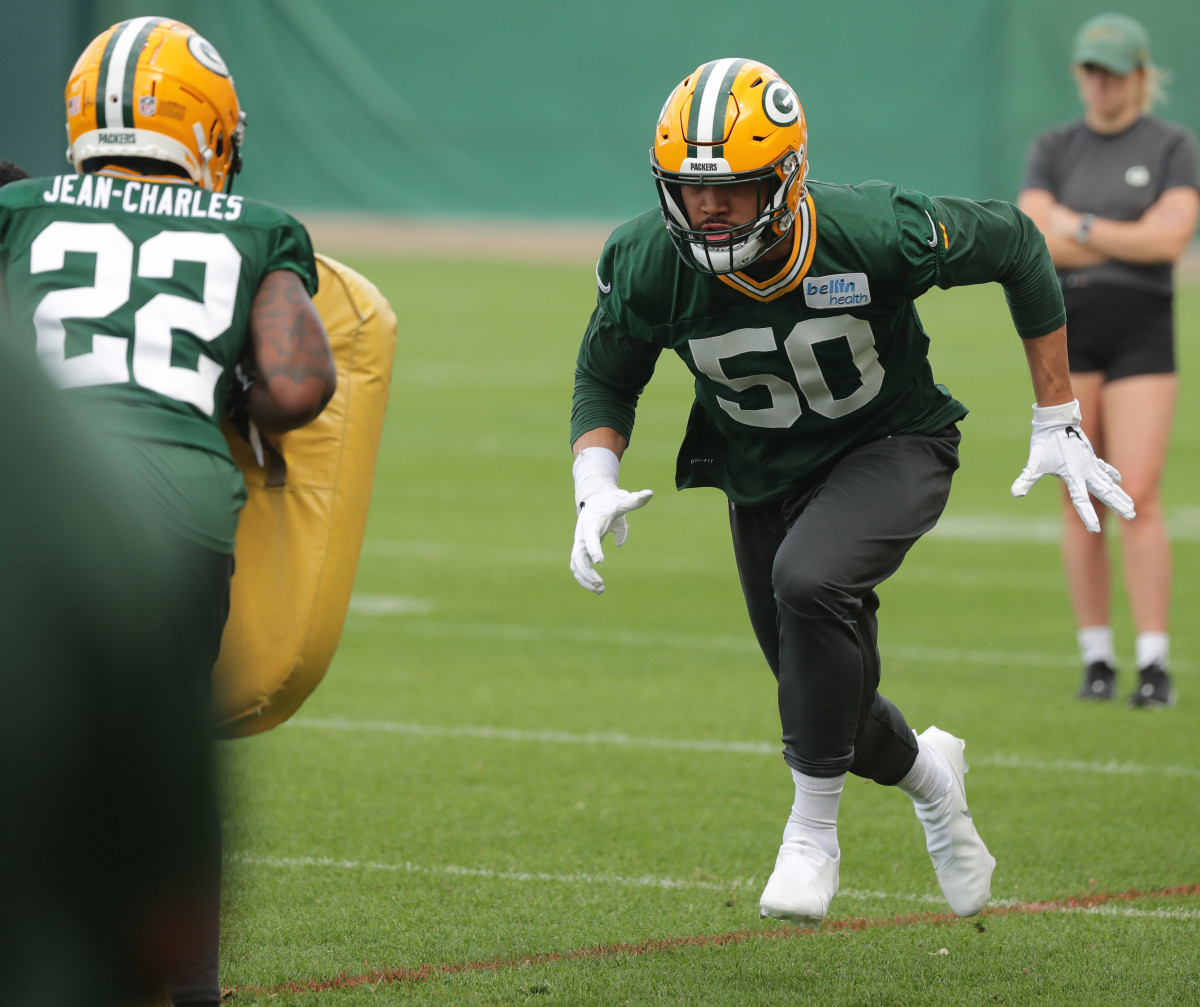
Galeai went from the practice squad to key backup thanks to all the injuries. Playing off the bench for the final seven games, he averaged 21.7 snaps and contributed 12 tackles and one sack. He had one tackle for every 12.7 snaps. He was active ahead of Garvin for the playoff game.
All the Packers’ outside linebackers are big, physical guys. Not Galeai. He is undersized and quick, which gives him a chance to contribute as a change-of-pace rusher. That didn’t show up this season, though. Galeai had five pressures in 89 pass rushes. His pass-rush win rate was a unit-worst 9.0 percent. Moreover, the run defense was 0.40 yards per carry better when he was not on the field, though he did chip in three stuffs – only two fewer than Preston Smith. With his size and athleticism, he needed to deliver more than one tackle on special teams.
Grade: D.
La’Darius Hamilton ($128,534 cap charge; ranking No. 202 among edge defenders)
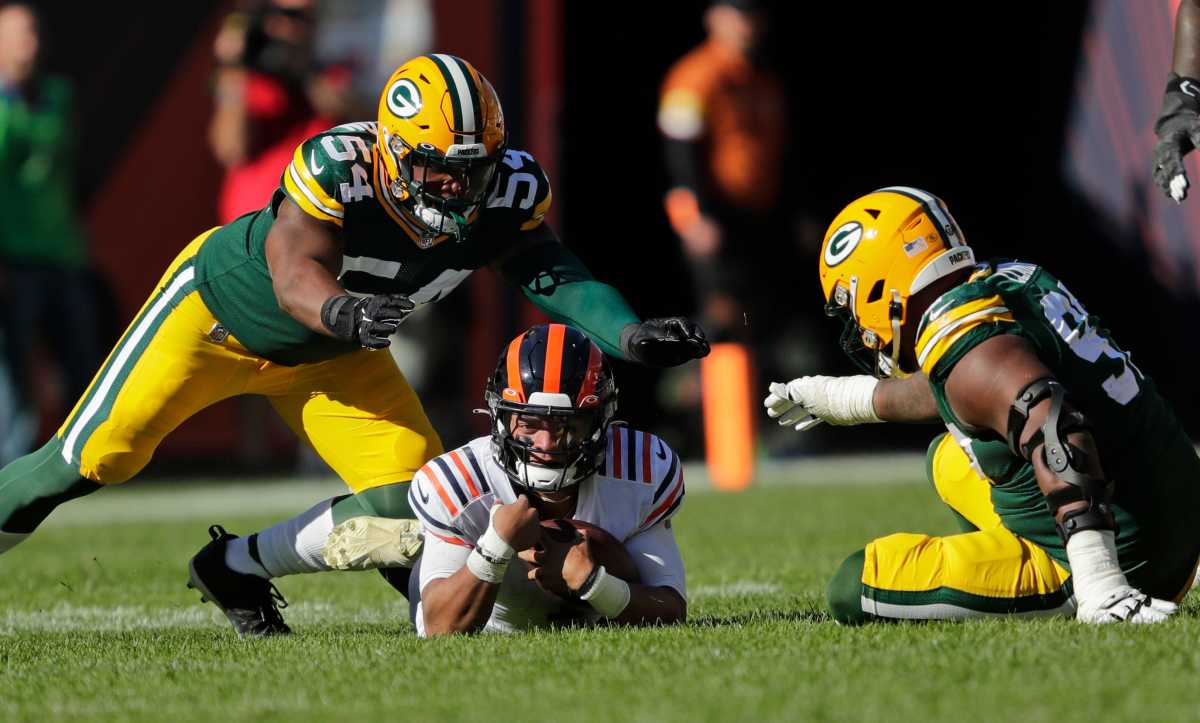
The Packers raided the Buccaneers’ practice squad to get Hamilton after Za’Darius Smith was shut down in mid-September. An undrafted free agent in 2020, he played 64 snaps on defense in six games and contributed three tackles (all against the Rams), two quarterback hits and three pressures in 36 rushes. His pass-rush win rate was 17.1 percent; the league median was 14.2 percent. He had one tackle for every 21.3 snaps.
The Packers released him on Nov. 13, re-signed him to the practice squad and wisely retained him with a futures deal. To make it, he’ll need to be a presence on special teams. He logged only six snaps in that phase this season, so clearly the coaches didn’t think he was good enough to even help that woeful unit.
Grade: C-minus.
Grading the Inside Linebackers
De’Vondre Campbell ($1.19 million cap charge; ranking No. 66 among LBs)
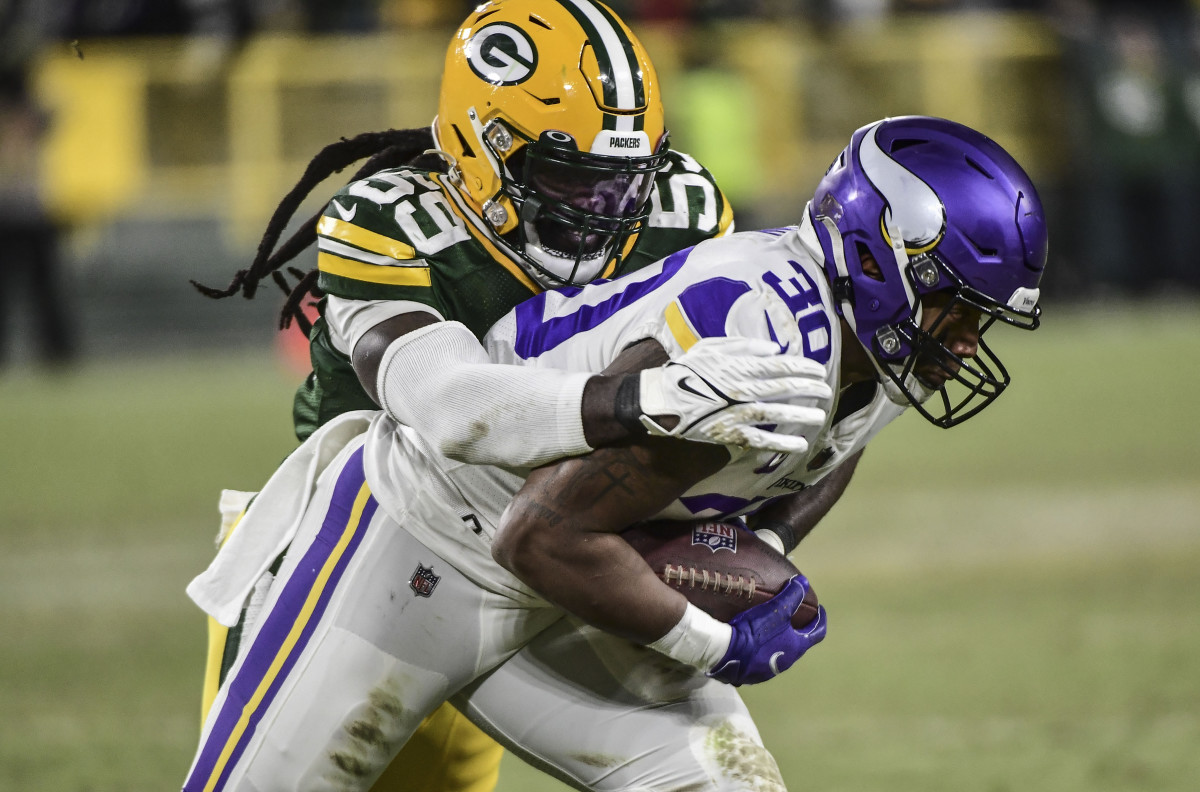
The Packers almost certainly wouldn’t have finished with 13 wins if not for Campbell going from June budget signing to first-team All-Pro. Even while sitting out the season finale against Detroit, Campbell finished seventh in the NFL with 145 tackles. He added six tackles for losses, six quarterback hits, five passes defensed, two forced fumbles and two interceptions. Before sitting out the finale, he led the NFL with 101 solo tackles.
Of the 34 players with at least 107 tackles, Campbell and Washington’s Cole Holcomb were the only players with at least one sack, one interception, one forced fumble and one fumble recovery. Campbell was the only linebacker in the league with 100-plus tackles and at least two sacks, two forced fumbles and two interceptions. He tackled running backs. He covered tight ends. He was the glue to the defense.
According to SIS, 30 linebackers had 100-plus tackles. Of that group, Campbell ranked second with 4.5 yards allowed per target in the passing game and first with a missed tackle rate of 3.3 percent.
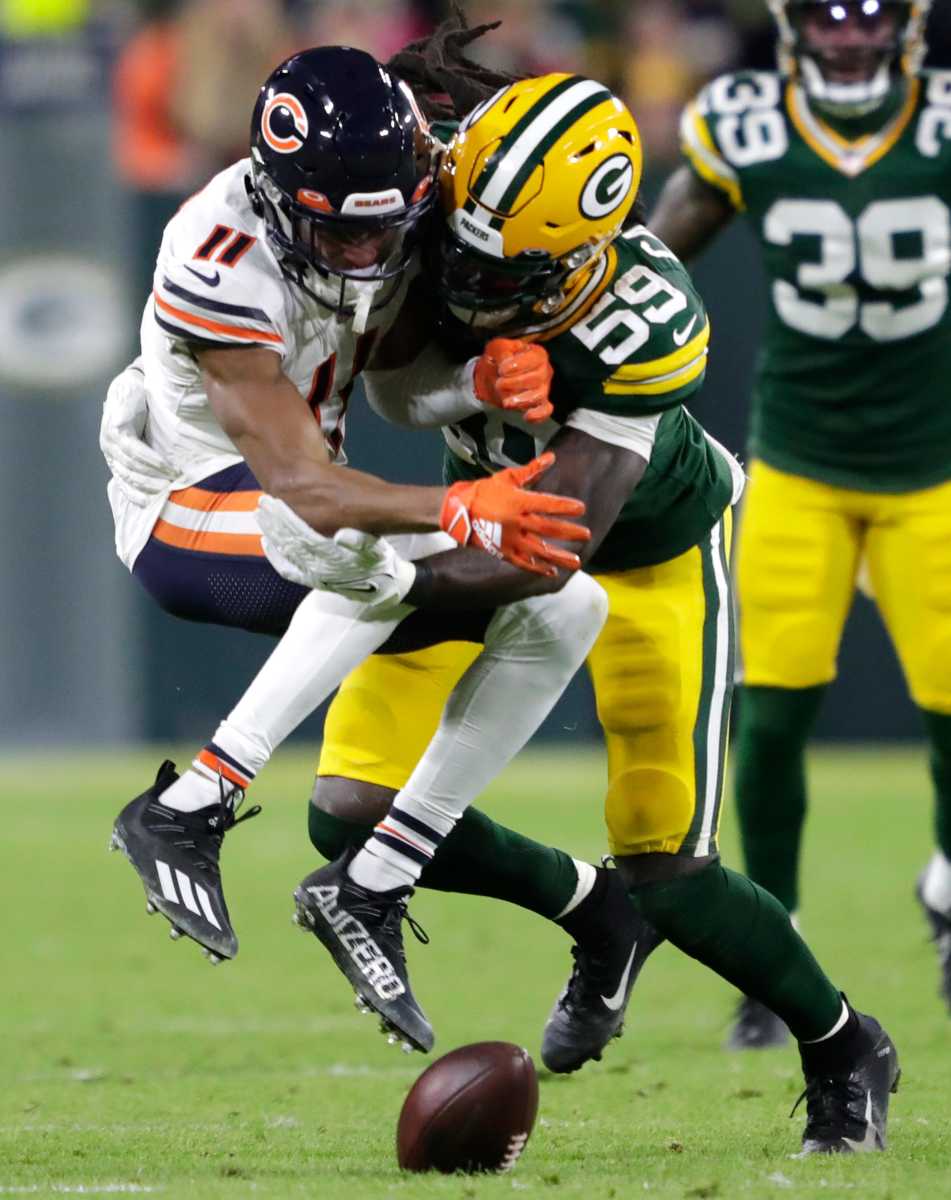
Campbell will be a free agent. It will be interesting to see what he’ll get – and if the Packers can afford him – after settling for his second consecutive one-year deal. Campbell was fantastic, to be sure, but how will he be viewed elsewhere? For instance:
Campbell led the team with nine stuffs, a tackle at or behind the line vs. the run; Kansas City rookie linebacker Nick Bolton had 20. Only 28 of his tackles on run defense held the play to 2 yards or less; Chicago’s Roquan Smith had 48. Meanwhile, he had 41 tackles on running plays that gained 5-plus yards, third-most among linebackers. In fact, his average tackle on running plays came 5.7 yards downfield, worst among linebackers. Wasn’t that the complaint about Blake Martinez, that too many of his tackles came too far downfield?
Still, some of this is nitpicking. Campbell was more than just a great bargain. He was great, period.
Grade: A-plus.
Oren Burks ($1.15 million cap charge; ranking No. 68 among LBs)
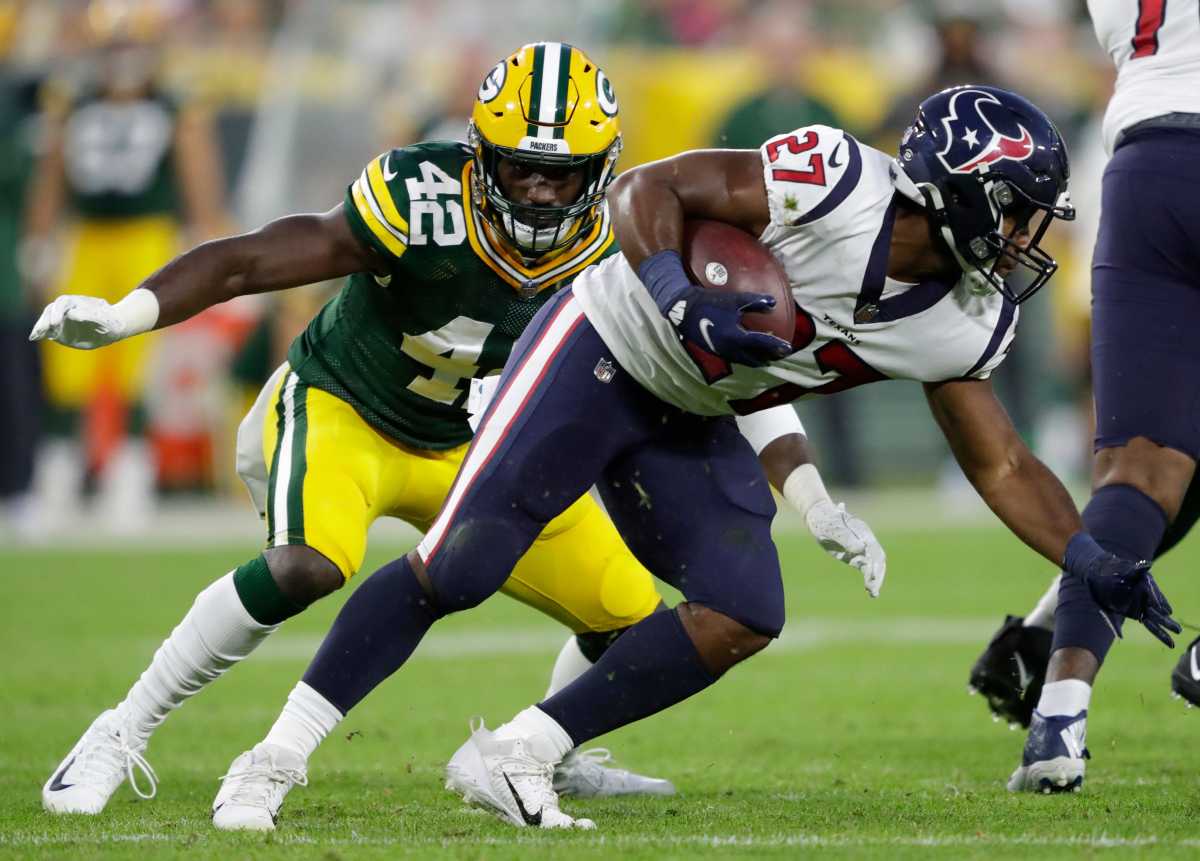
Burks was a third-round pick in 2008. With size, athleticism and a defensive backs background after starting his college career at Vanderbilt as a safety, he was billed as a new-age, every-down linebacker. Goodness knows the Packers needed one.
In four seasons, Burks didn’t break up a single pass. Zero. Of his seven career starts, three came this season, when he recorded 26 tackles and a half-sack. He was second on the team with eight tackles on special teams while logging a team-high 337 snaps. Burks missed four tackles – the same number as Campbell despite having 119 fewer tackles. The team dabbled with him at outside linebacker because, well, why not? Perhaps this grade is more career achievement than anything.
Grade: F.
Ty Summers ($874,476 cap charge; ranking No. 119 among LBs)
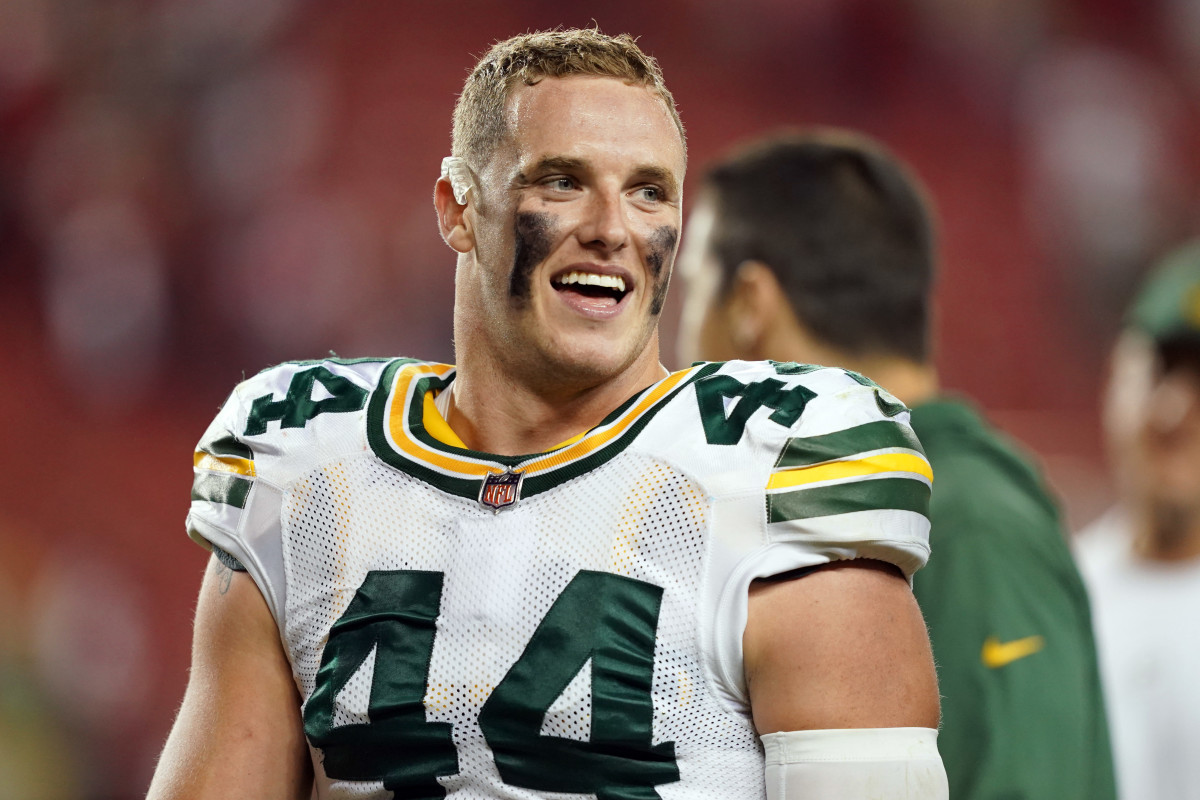
The best part about signing Campbell is it meant Summers didn’t have to play on defense. In 2020, he played 176 snaps on defense and started one game. It only seemed like he gave up a completion on every one off his defensive snaps. In 2021, he played 29 snaps on defense. In 14 games, Summers had four tackles on defense and four tackles on special teams, where he played a fourth-ranked 270 snaps. The Packers need standouts on special teams. Those really need to be linebackers because of their combination of size, speed and tackling ability. A seventh-round pick in 2019, Summers has not filled that role.
Grade: F.
Krys Barnes ($780,000 cap charge; ranking No. 147 among LBs)
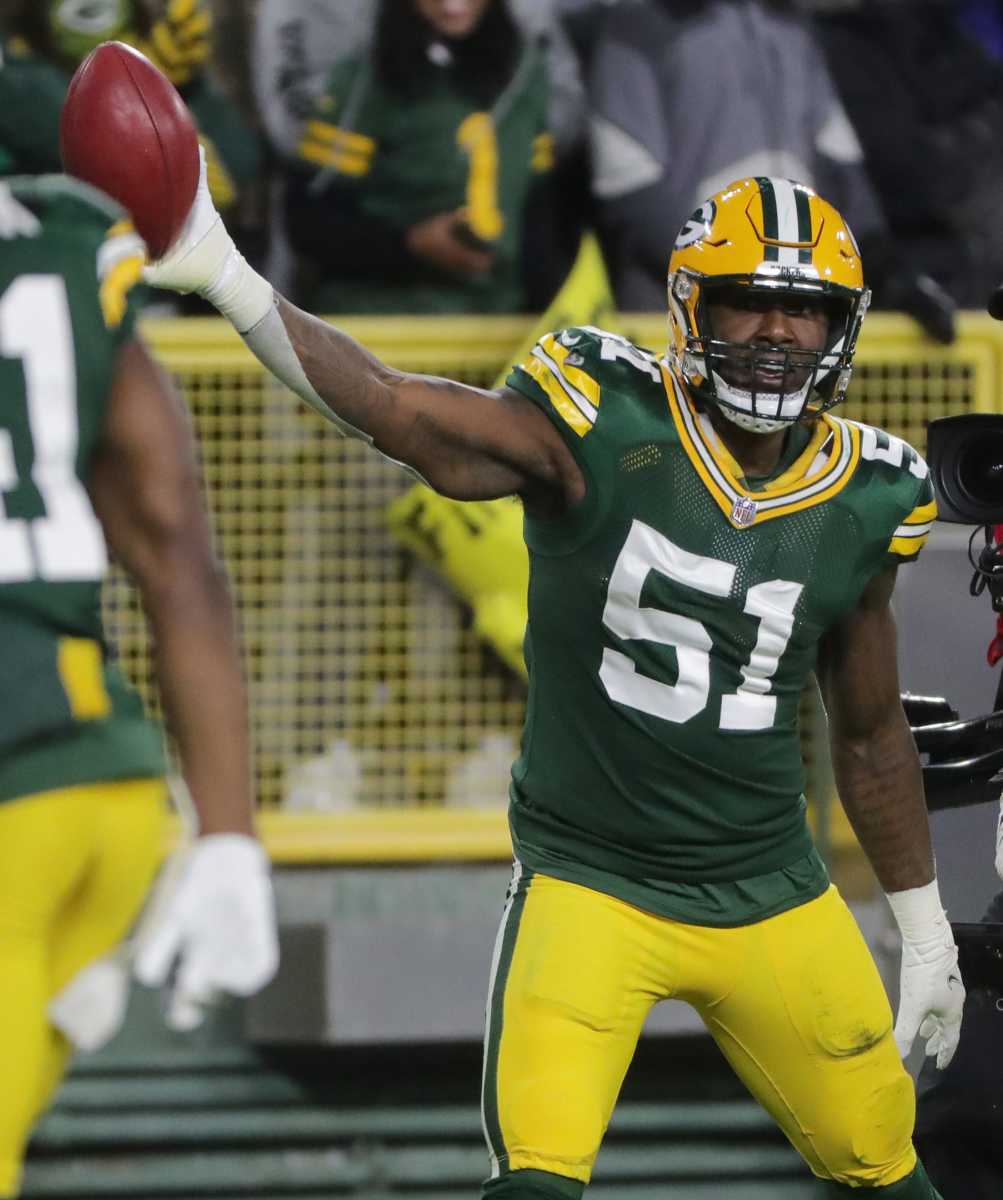
In 16 games (13 starts), Barnes played just short of 50 percent of the defensive snaps. He finished third on the team with 79 tackles. He added six stuffs, four tackles for losses and four passes defensed. With Campbell playing 988 snaps and Barnes 527, here’s an interesting comparison.
Snaps per tackle: Campbell (6.81), Barnes (6.67). Run snaps per stuff: Campbell (35.9), Barnes (35.3). Coverage snaps per breakup: Campbell (132.8), Barnes (74.5). Distance of average tackle on run play: Campbell (5.7), Barnes (3.9). Stops (a PFF metric that essentially measures impact tackles) per overall snap: Campbell (18.6), Barnes (16.4).
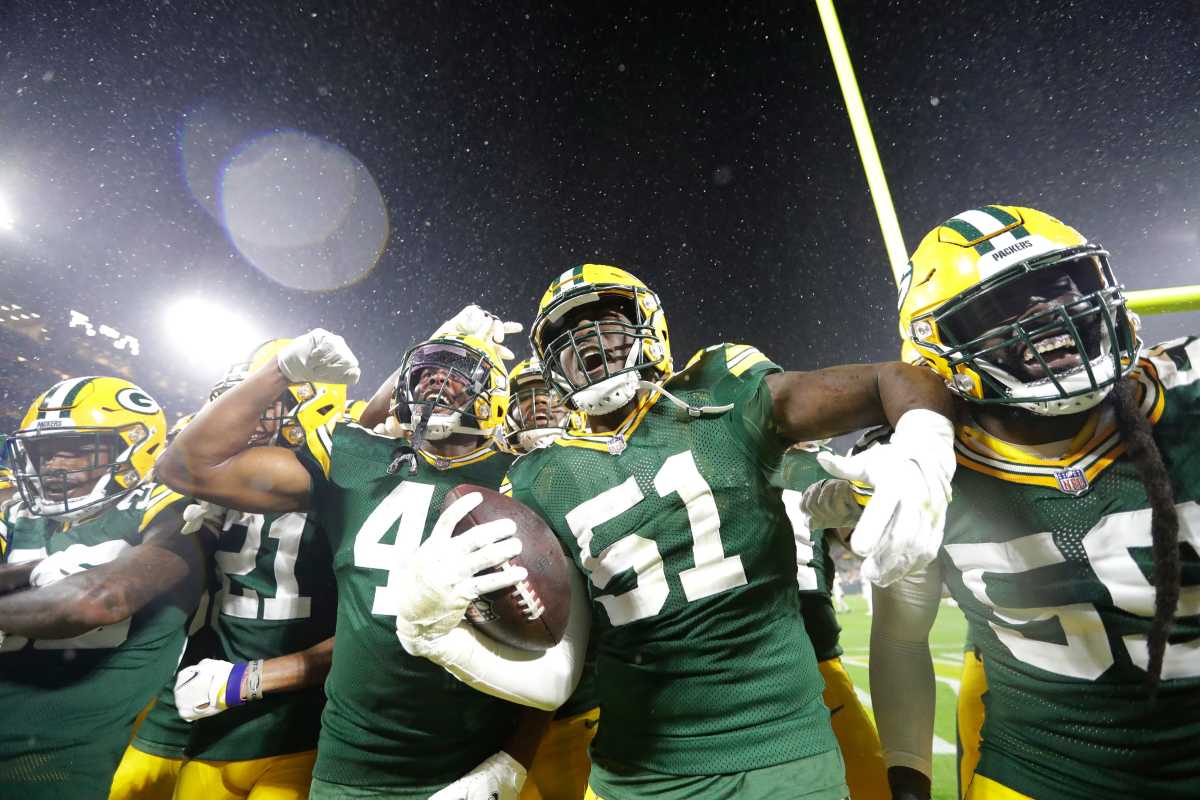
Those numbers are pretty similar. That’s not to say Barnes is almost as good as Campbell. Campbell had huge edges in yards allowed per target (4.5 to 7.1) and missed tackles (3.3 percent to 11.1 percent), two hugely important areas. It’s to say Barnes is pretty darned good.
Grade: B.
Isaiah McDuffie ($692,676 cap charge; ranking No. 166 among LBs)
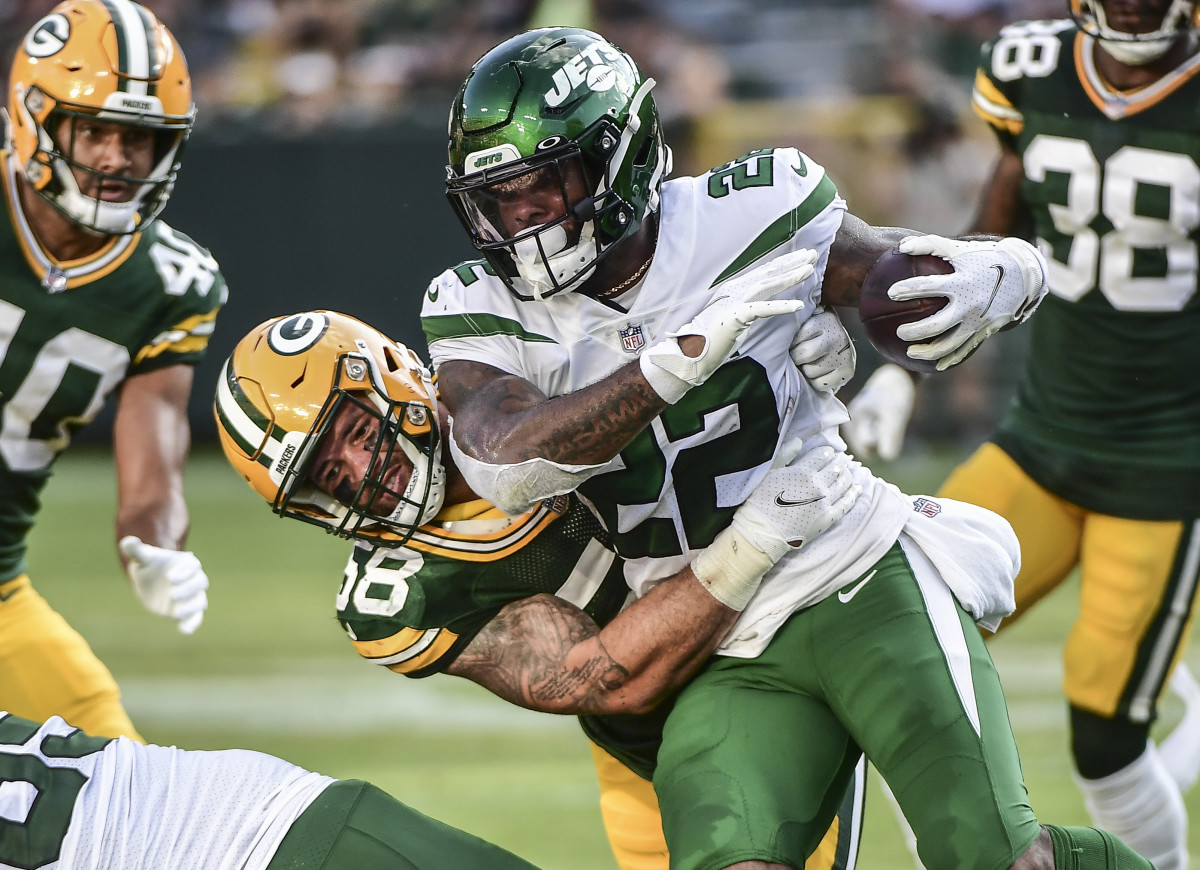
A sixth-round pick this year, McDuffie was a total nonfactor. He didn’t play a single snap on defense and was seventh on the team with 192 snaps on special teams. He had more penalties (team-high three) than tackles (two assists) on special teams. Yikes.
Grade: F.
Grading the Cornerbacks
Jaire Alexander ($3.83 million cap charge; ranking No. 37 among CBs)
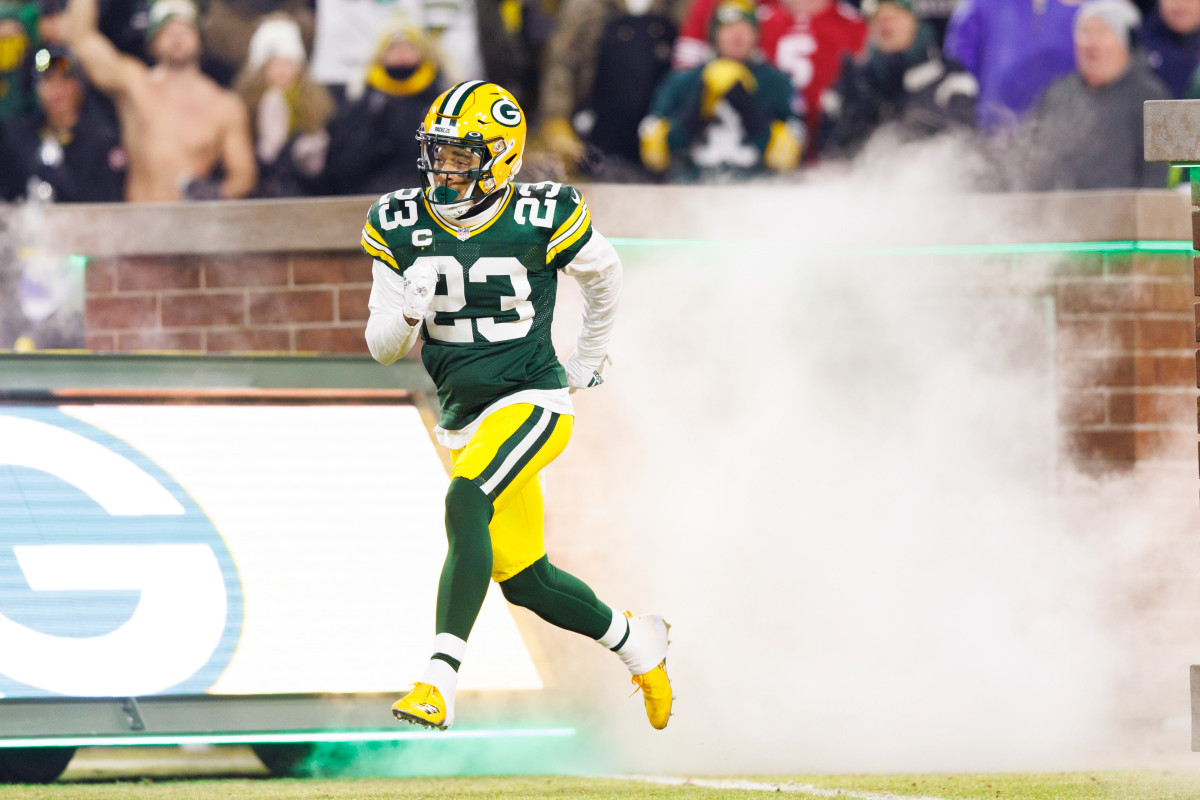
Coming off an All-Pro season in 2020 that he capped with two interceptions of Tom Brady in the NFC Championship Game, expectations were high for the talented, charismatic and physical Alexander to somehow lift his game to another level. Voted a team captain, Alexander might have done it, too, if not for the shoulder injury he sustained while trying to tackle burly Steelers running back Najee Harris during the second half of their Week 4 game. He missed the rest of the regular season and returned to play eight snaps in the playoff game.
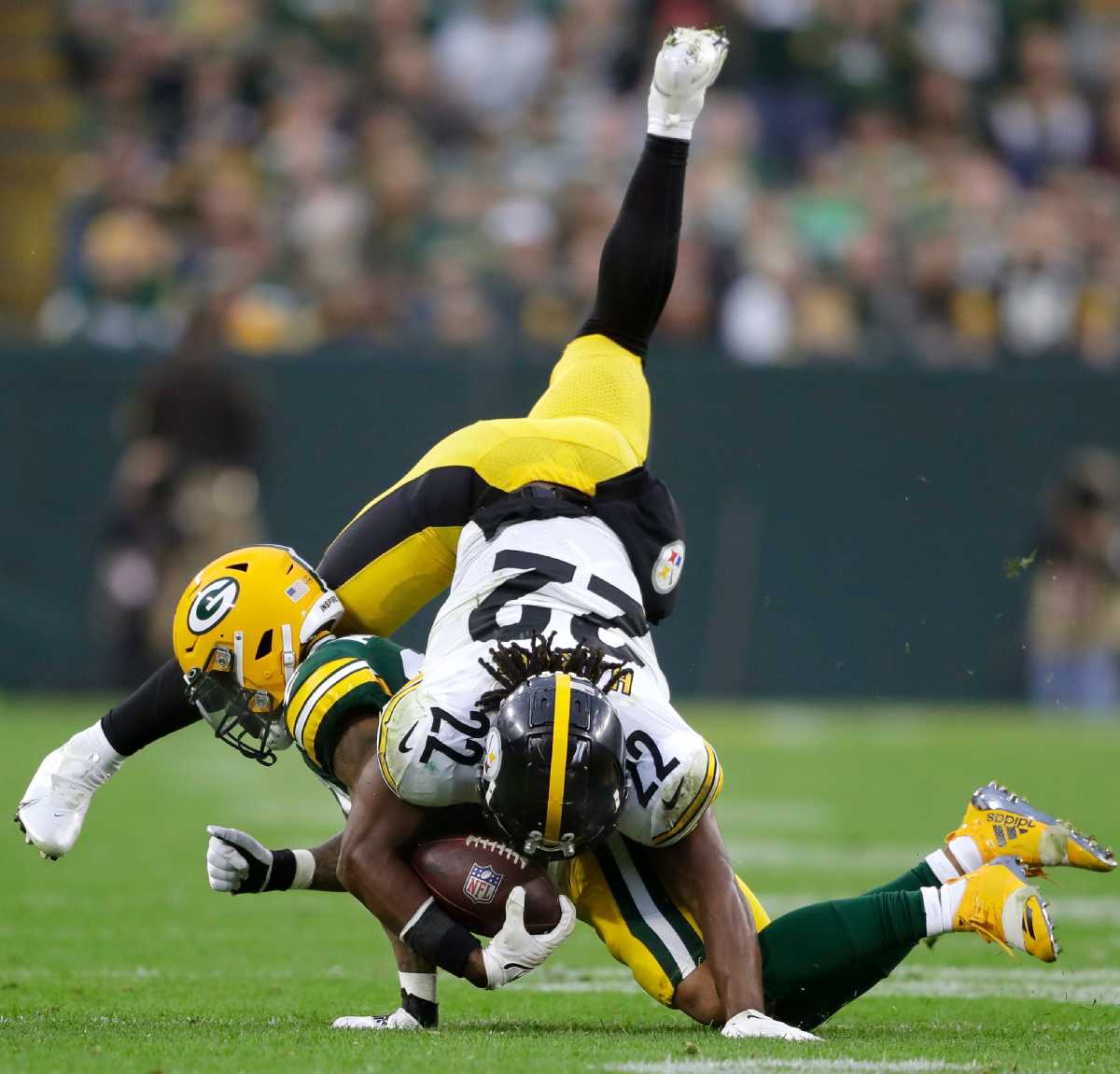
In four games, he allowed a 46.7 percent completion rate, according to SIS. That marked his third consecutive season of less than 50 percent and a four-year total of just 49.2 percent. He intercepted one pass, an incredible play at San Francisco in which he left his man and picked off a deep ball to tight end George Kittle. He did give up two touchdowns, which is as many as he yielded in 15 games in 2020.
The grade isn’t a reflection of Alexander’s performance but the fact he wasn’t on the field.
Grade: C-minus.
Eric Stokes ($2.17 million cap charge; ranking No. 59 among CBs)
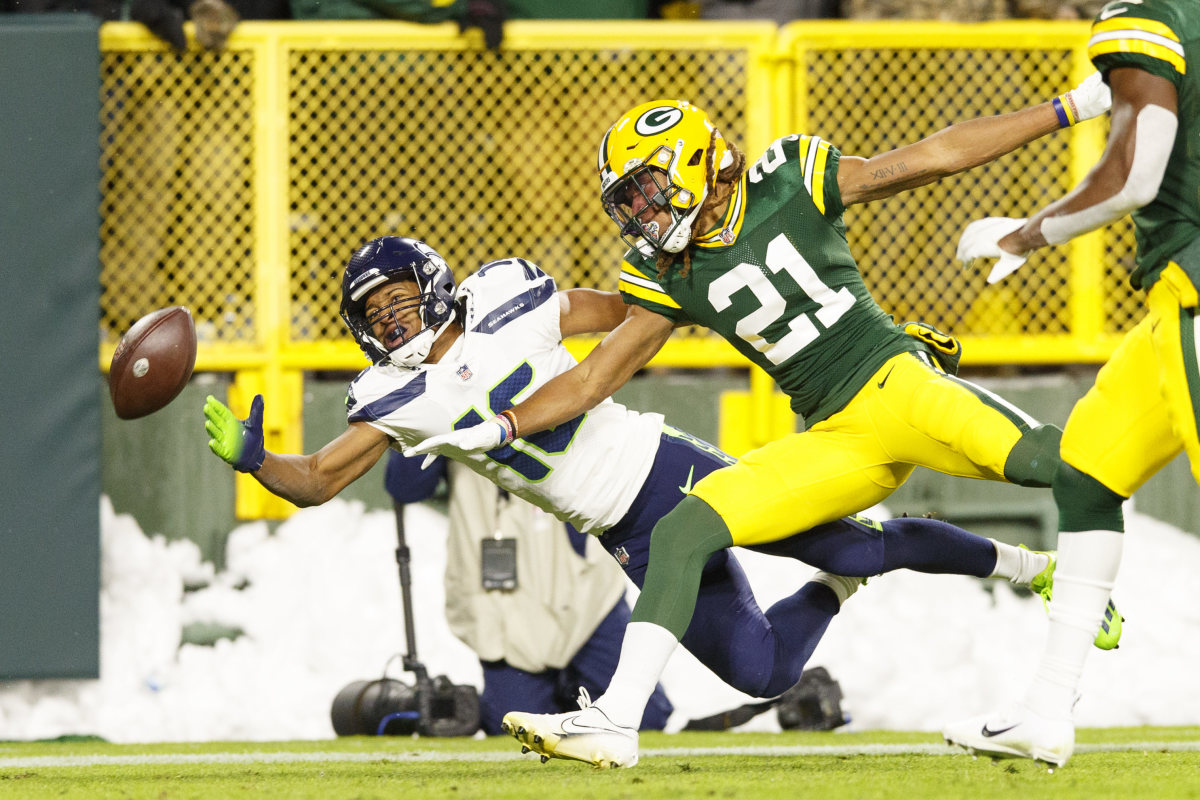
A converted running back, Stokes was the team’s first-round pick despite lacking an abundance of experience at Georgia. Was he more than just pure speed? A project? Was he even the best Georgia cornerback in the draft? Stokes answered those questions affirmatively with a big-time rookie season. With Alexander and King out of action, a lot was asked and required of Stokes. He generally delivered with one interception and a team-leading 14 passes defensed.
Facing a bunch of top receivers, Stokes – perhaps because he spent most of training camp battling Davante Adams – never blinked. SIS charged him with a 46.2 percent completion rate and 5.3 yards per target, figures that ranked sixth and eighth, respectively, among starting corners. Of 91 corners with 50 percent playing time, Stokes finished fourth in completion percentage (51.0), 20th in snaps per completion (12.5) and 23rd in passer rating (78.8), according to Pro Football Focus. A penalty magnet at Georgia, he was guilty of only three. His four dropped interceptions were second-most in the league.
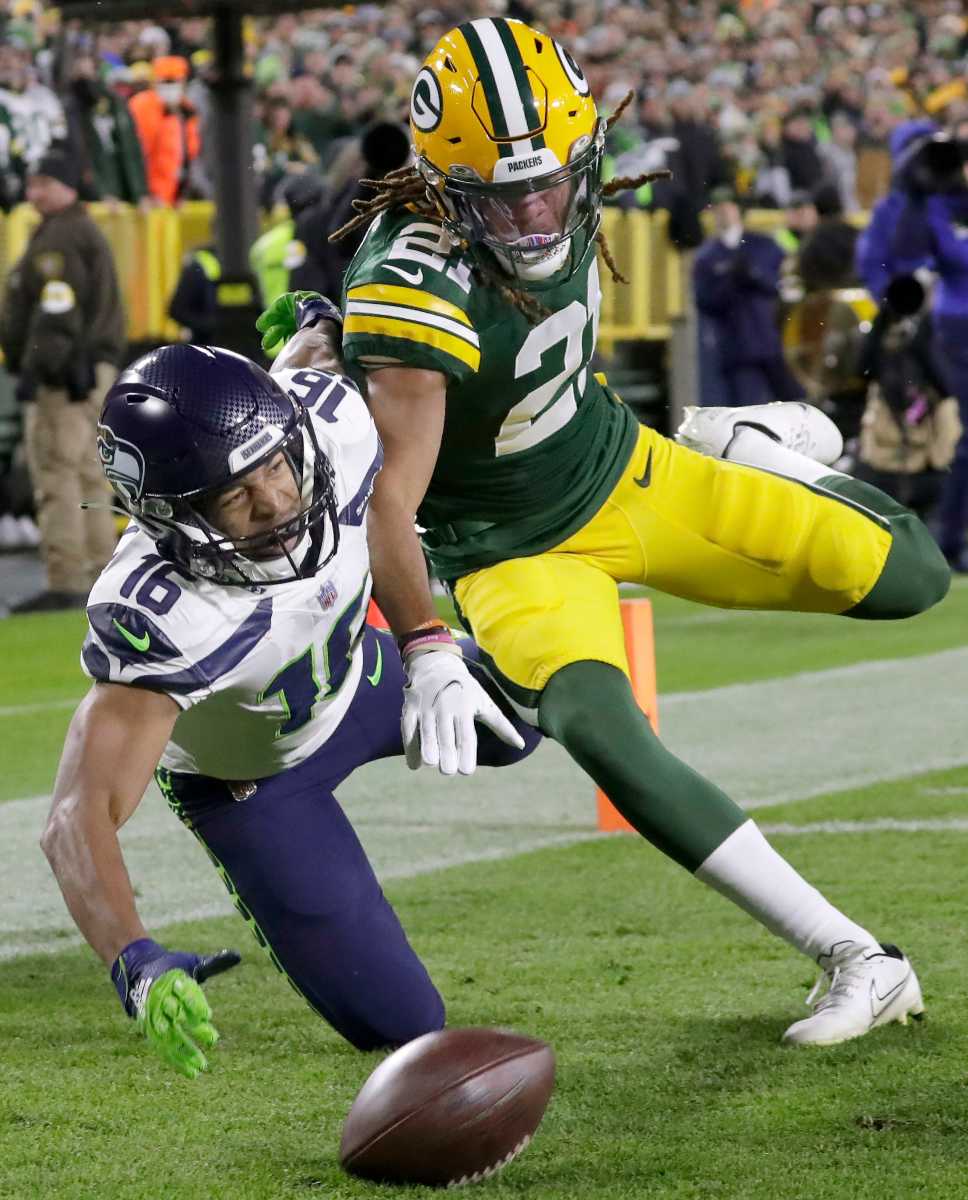
While he got roughed up at Minnesota in Week 11, he was superb down the stretch. According to PFF, he allowed 19-of-41 passing for 157 yards and one touchdown during the final six games of the regular season and the playoff game.
Grade: B.
Kevin King ($1.93 million cap charge; ranking No. 67 among CBs)
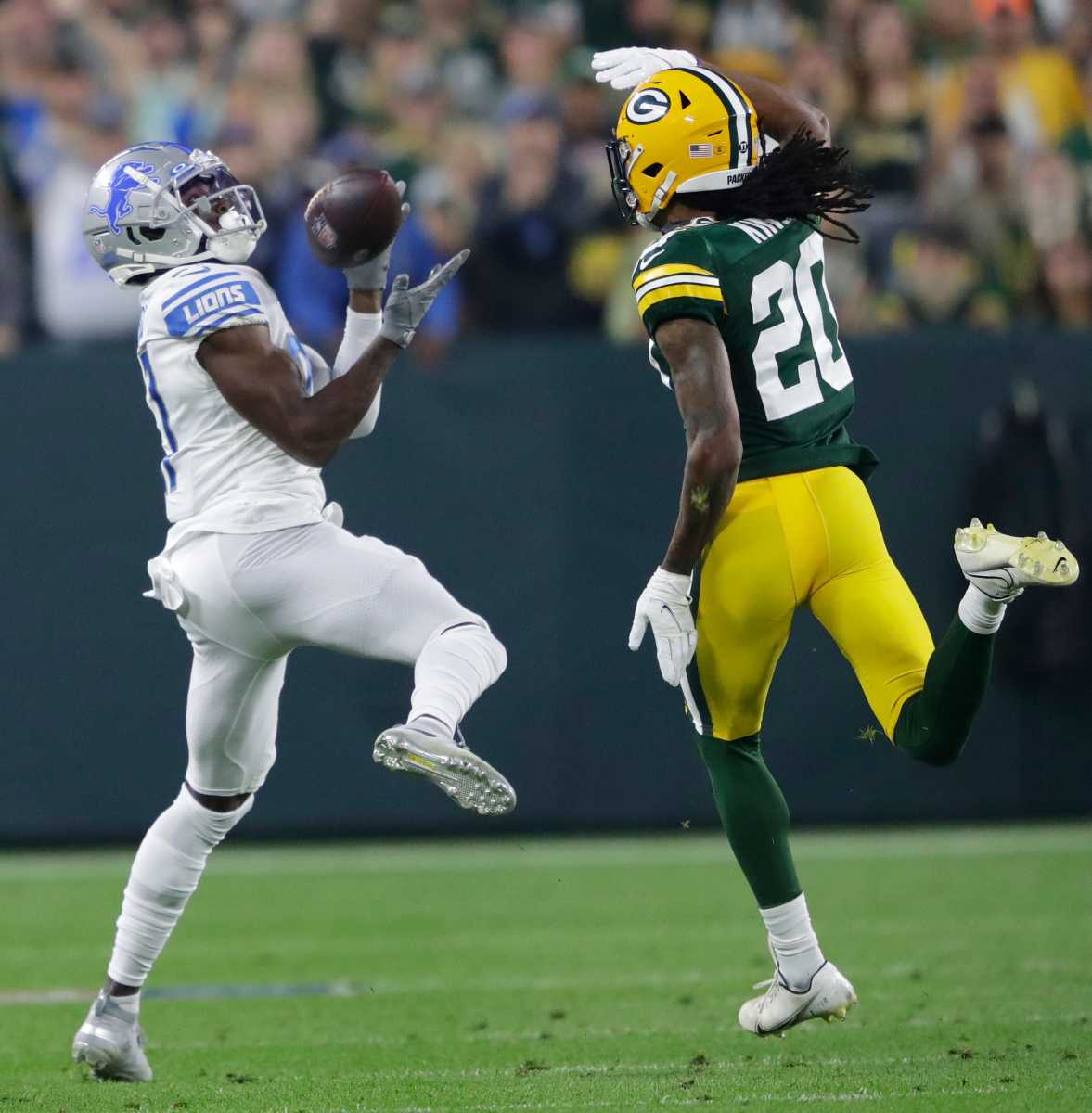
GM Brian Gutekunst re-signed King to a one-year, $5 million contract in free agency last offseason. Had he known he would have gotten such a big-time rookie season from Stokes, he might not have bothered.
King played in 10 games with six starts. That, of course, means he missed seven games. In five seasons, he missed 30 of a possible 81 games due to the world’s longest list of injuries. After a breakout 2019 season in which he ranked among the league leaders with five interceptions and 15 passes defensed in 15 games, King had one interception and eight passes defensed in 21 games the last two seasons. SIS charged King with a 68.2 percent completion rate in 2021. PFF charged him with a 112.1 passer rating, worst on the unit. Eventually, defensive coordinator Joe Barry pegged Stokes, Rasul Douglas and Chandon Sullivan as his top trio, so King barely played down the stretch.
This has to be the end of King’s five-year tenure with the team, other than $750,000 cap charges through the 2025 season.
Grade: D.
Chandon Sullivan ($1.16 million cap charge; ranking No. 96 among CBs)
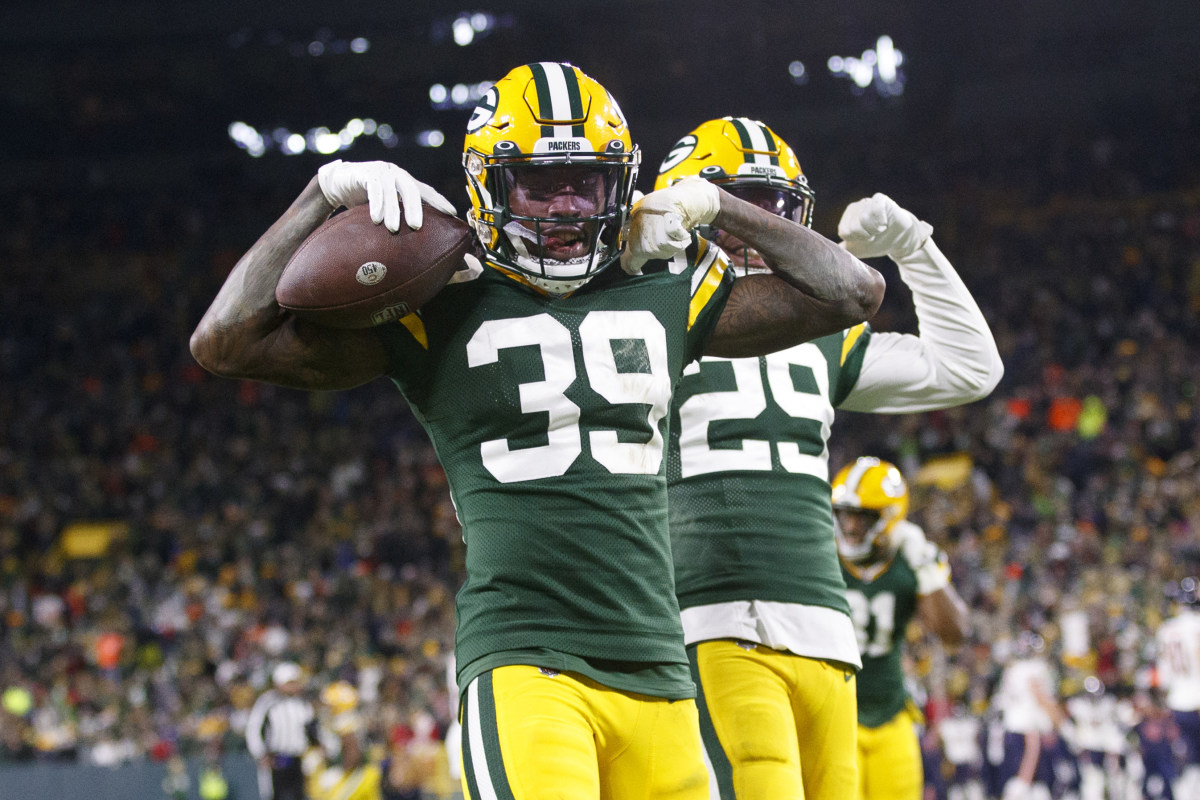
Sullivan played in all 17 games with 10 starts. The team’s primary slot defender last season, the team dabbled a bit with King this season before realizing Sullivan was the best bet in that role. He set his career high with three interceptions and added four passes defensed and two tackles for losses.
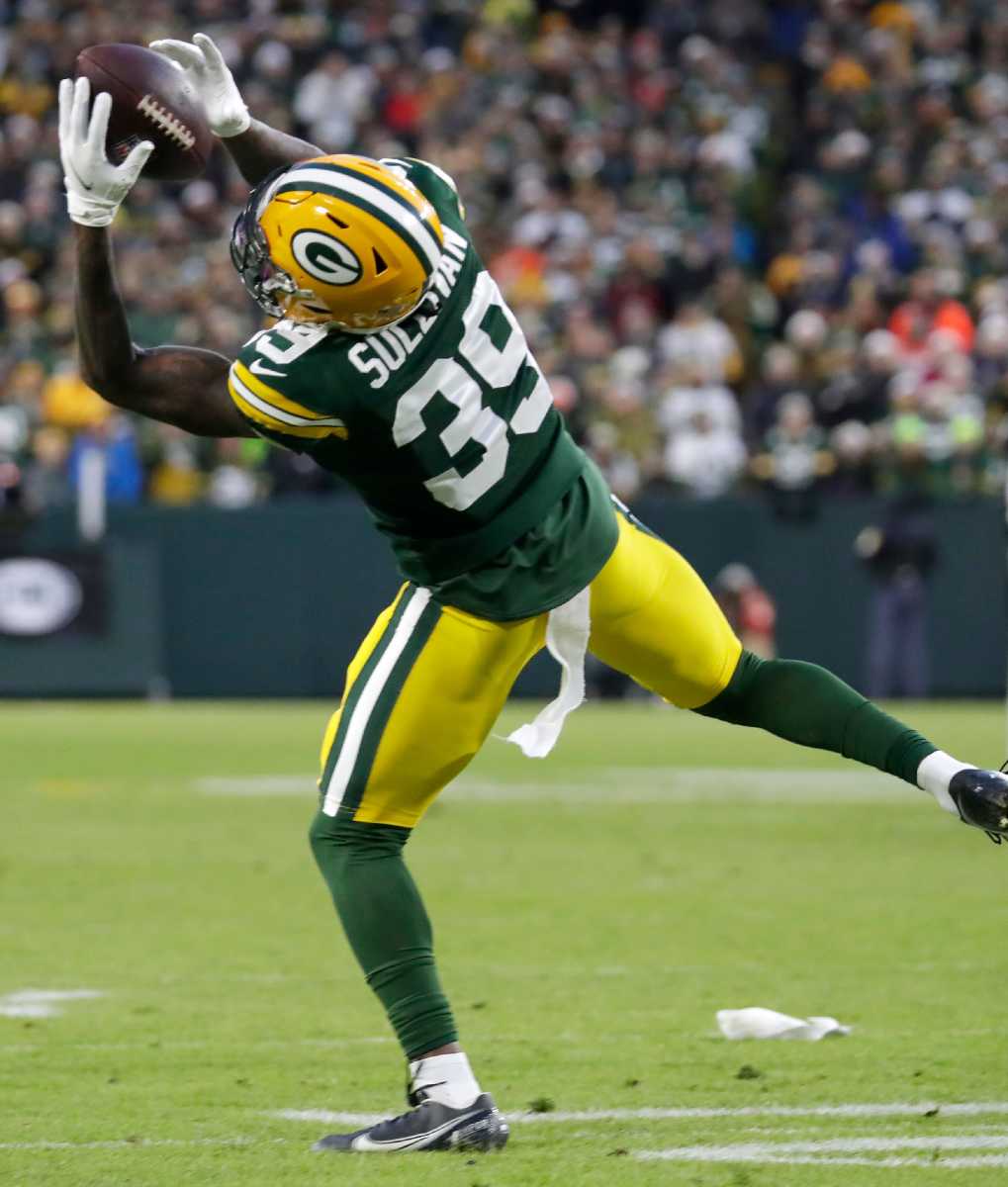
Sullivan is sort of like guard/center Lucas Patrick. It seems the front office will always be trying to replace him, but the coaches can’t keep him out of the lineup. According to PFF, 31 defensive backs played at least 170 snaps in the slot. In that group, he finished fourth in snaps per reception, third in snaps per target and 10th in yards per snap. SIS charged him with a 61.4 percent completion rate. He misses too many tackles, which leads to too many yards after the catch. It’s worth noting Sullivan, who is headed toward free agency, has played every game in his three seasons with the Packers.
Grade: B-minus.
Isaac Yiadom ($970,000; ranking No. 110 among CBs)
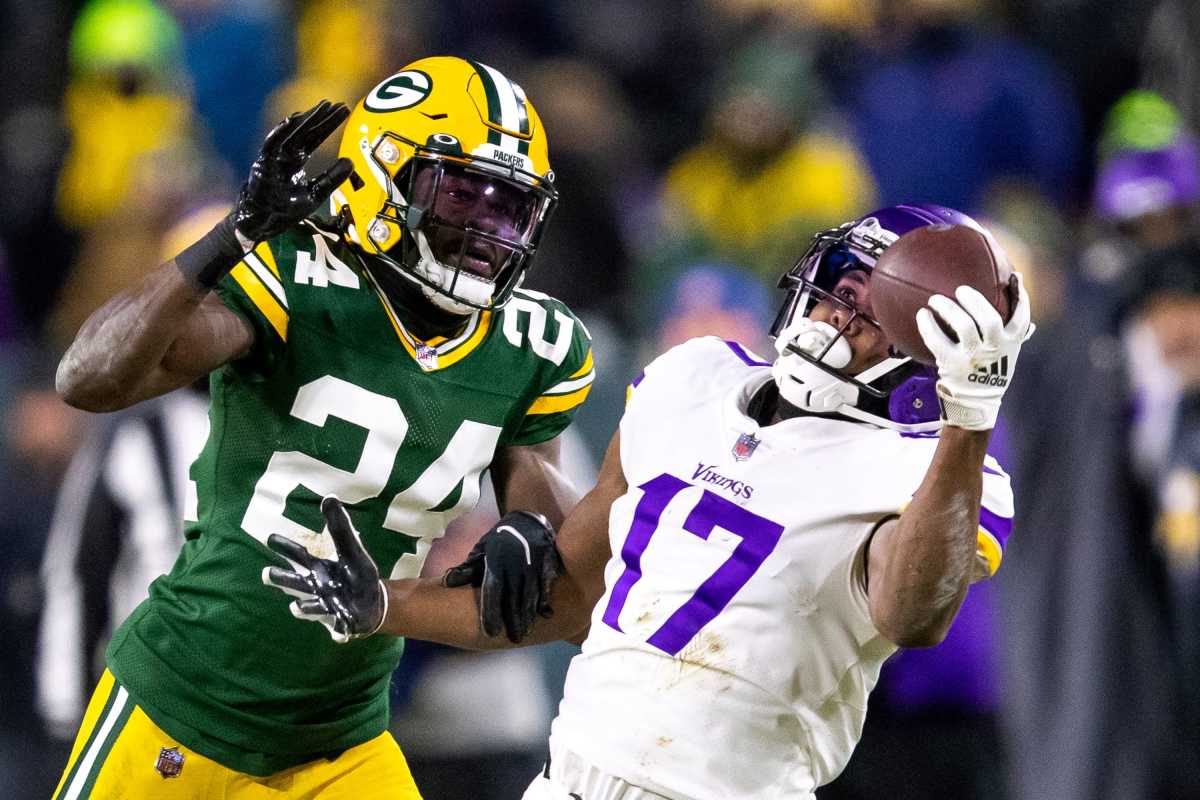
The Packers acquired Yiadom, a third-round pick in 2018, for Josh Jackson, a second-round pick in 2018, during training camp. With Alexander and King out with injuries, he started the Week 6 game at Chicago. His starting tenure with the Packers lasted exactly one series. He gave up a 20-yard completion to Allen Robinson and was penalized 26 yards for pass interference to give the Bears a first down at the 1. On the next series, Rasul Douglas replaced Yiadom and the Packers never looked back.
PFF charged him with 5-of-6 passing for 99 yards in the seven games in which he played defense. He contributed three tackles on special teams. With the return of Alexander, the Packers released him before the playoff game; he would have been a free agent, anyway.
Grade: F.
Shemar Jean-Charles ($720,038 cap charge; ranking No. 167 among CBs)
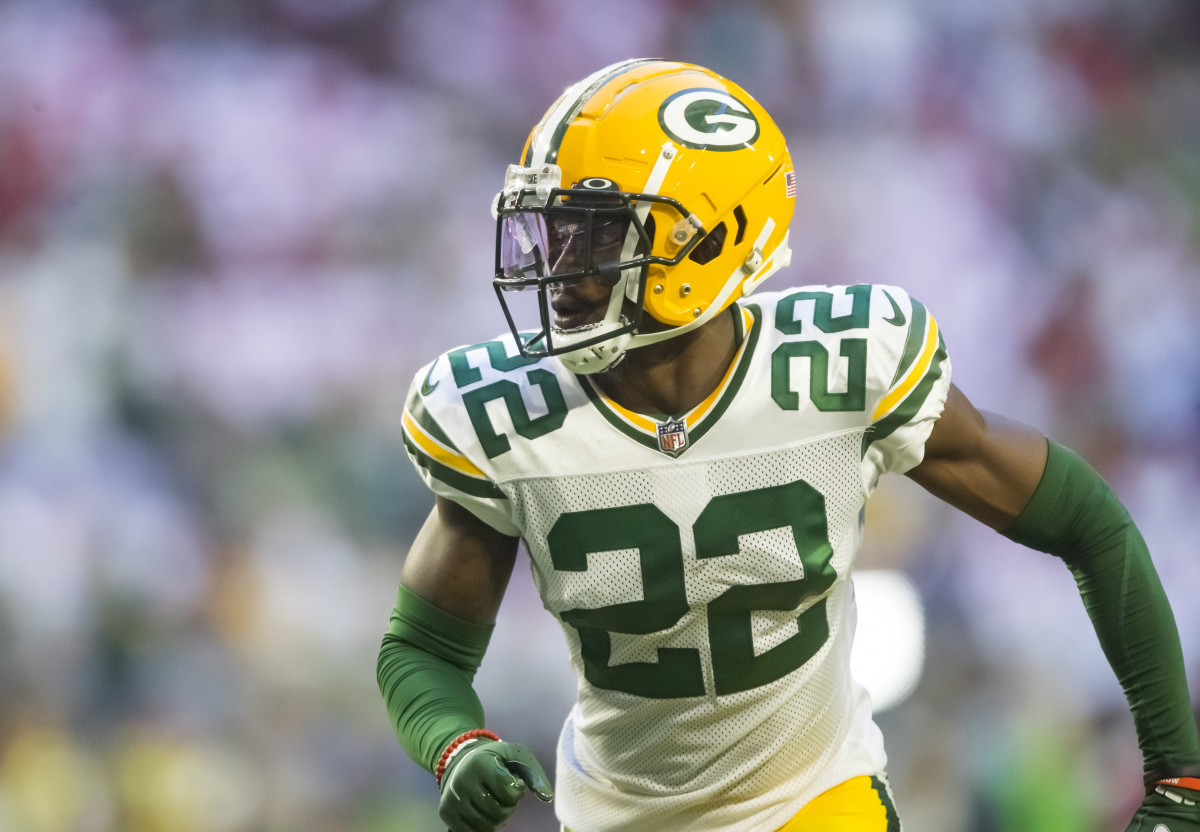
A fifth-round pick, Jean-Charles was a small-school standout who was nowhere near ready for life in the NFL. He played 37 snaps on defense and allowed 7-of-7 passing for 82 yards, according to PFF. Really, his only memorable play on defense came at Cincinnati, when Joe Mixon juked Jean-Charles onto his butt for a touchdown. His 231 snaps on special teams ranked sixth on the team. He finished fourth on the team with six tackles. The coaches can’t possibly believe Jean-Charles is ready to replace Sullivan in the slot.
Grade: D-minus.
Rasul Douglas ($661,111 cap charge; ranking No. 181 among CBs)
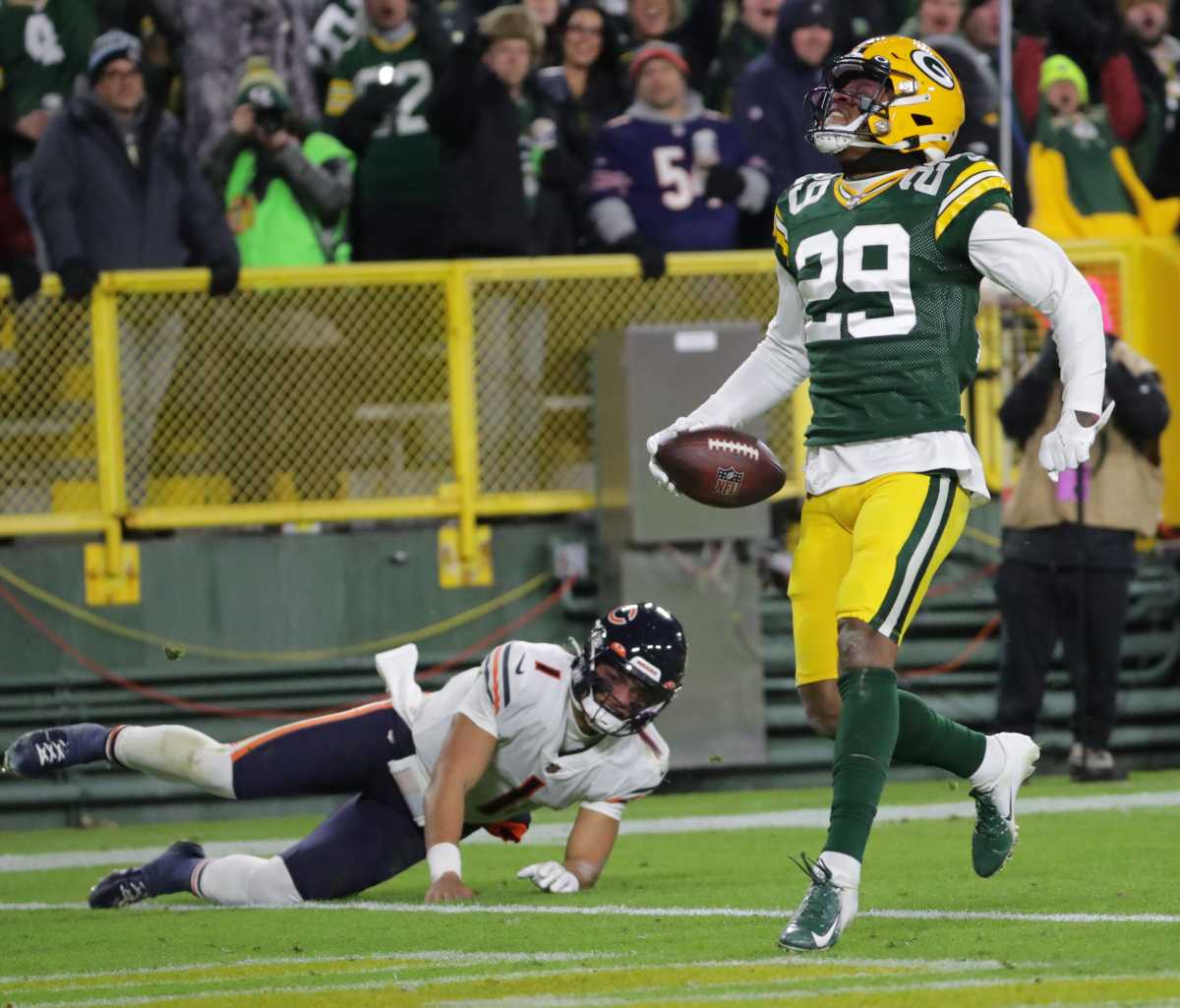
Remember A Christmas Story, when Ralphie turns in his essay on why he wants a Red Rider BB gun? He stands at the teacher’s desk and dreams of her giving him an “A-plus, plus, plus, plus ...” Well, that would have been Douglas’ grade.
The point of this series is to grade players on a salary cap curve. At 10 times the salary, Douglas would have been worth an A-plus. He was one of the great in-season moves any general manager has ever made. Imagine, getting a Pro Bowl player at a premium position from another team’s practice squad. Now, imagine that player was deemed not good enough to make the rosters in Las Vegas and Houston – two teams not exactly known for great defenses – during training camp. Douglas wasn’t just good. He was great. At any price.
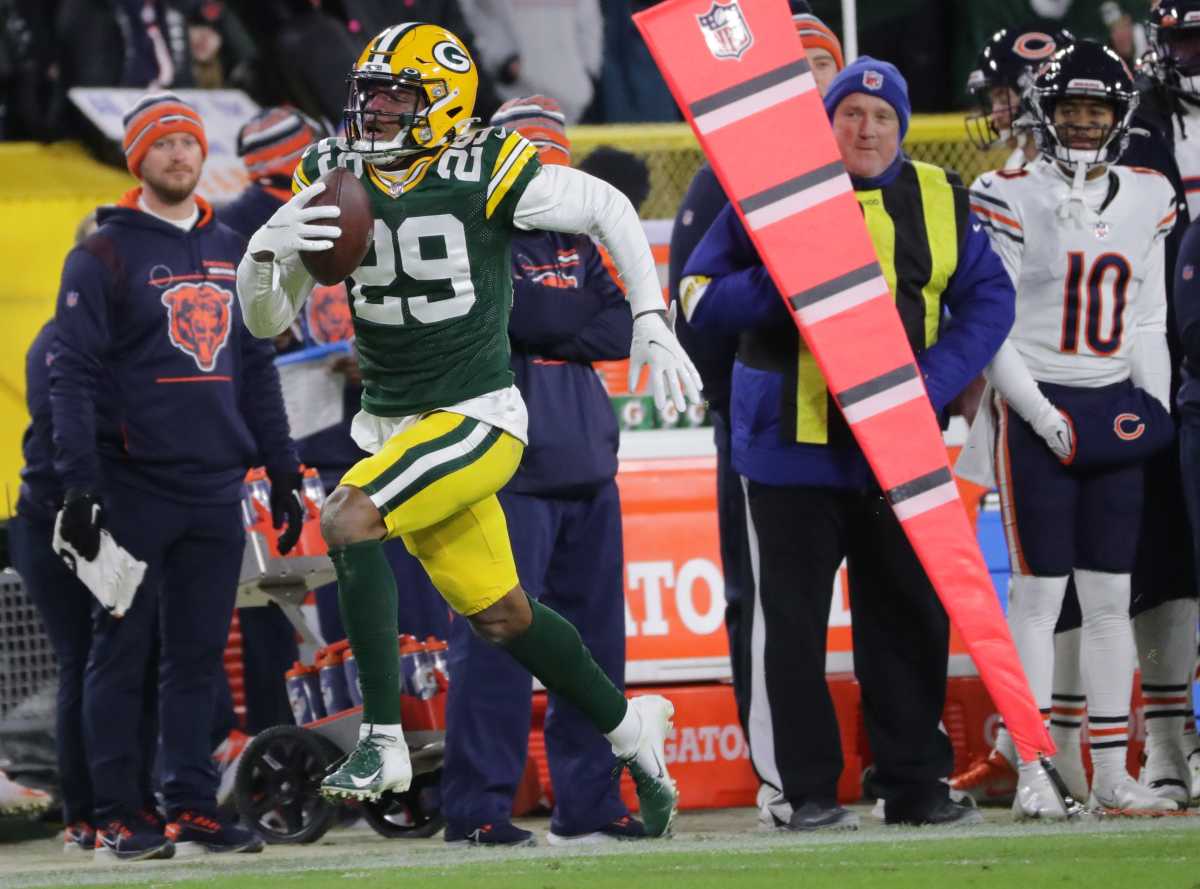
Douglas saved the Packers’ victories over Arizona and Cleveland. Without those interceptions, Green Bay would have finished 11-6 instead of 13-4. He added pick-sixes at home against Los Angeles and Chicago; maybe the Packers would have lost to the Rams and finished 10-7. He was barely tested against San Francisco but broke up a pass that arguably should have been ruled a forced fumble.
Douglas tied for fourth in the NFL with five interceptions even though he played in only 12 games with nine starts. SIS charged him with a 45.3 percent completion rate and 5.3 yards per attempt. Among starting corners, those marks ranked fifth in the league. PFF had him ranked third in opponent passer rating (49.6). And if that’s not enough, he contributed four tackles on special teams.
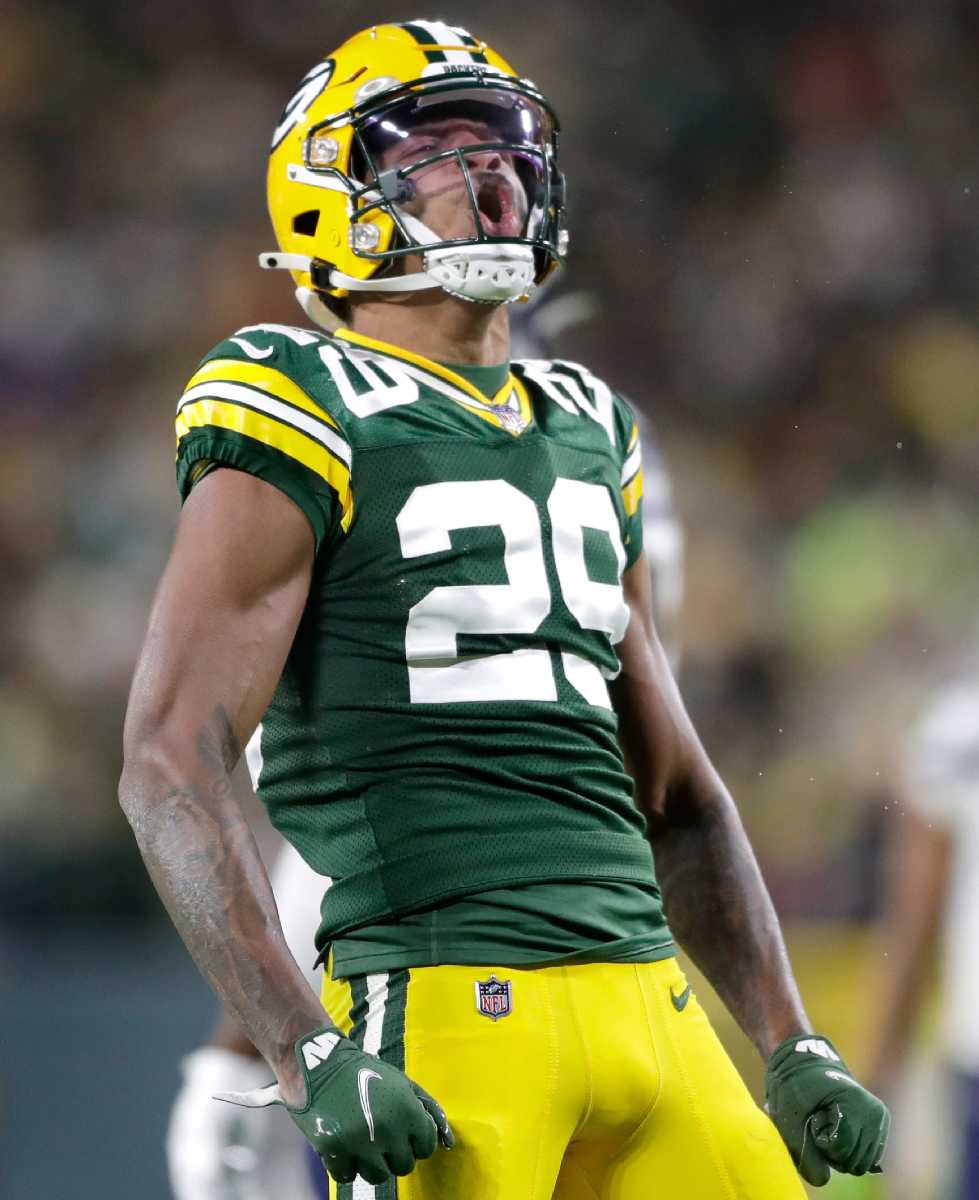
With that, Douglas faces a fascinating free agency. Is he the journeyman corner who entered the league as a third-round pick in 2017? Or is he a premier ballhawk who had as many interceptions this season as his first four years combined?
Grade: A-plus.
Grading the Safeties
Adrian Amos ($5.97 million cap charge; ranking No. 13 among safeties)
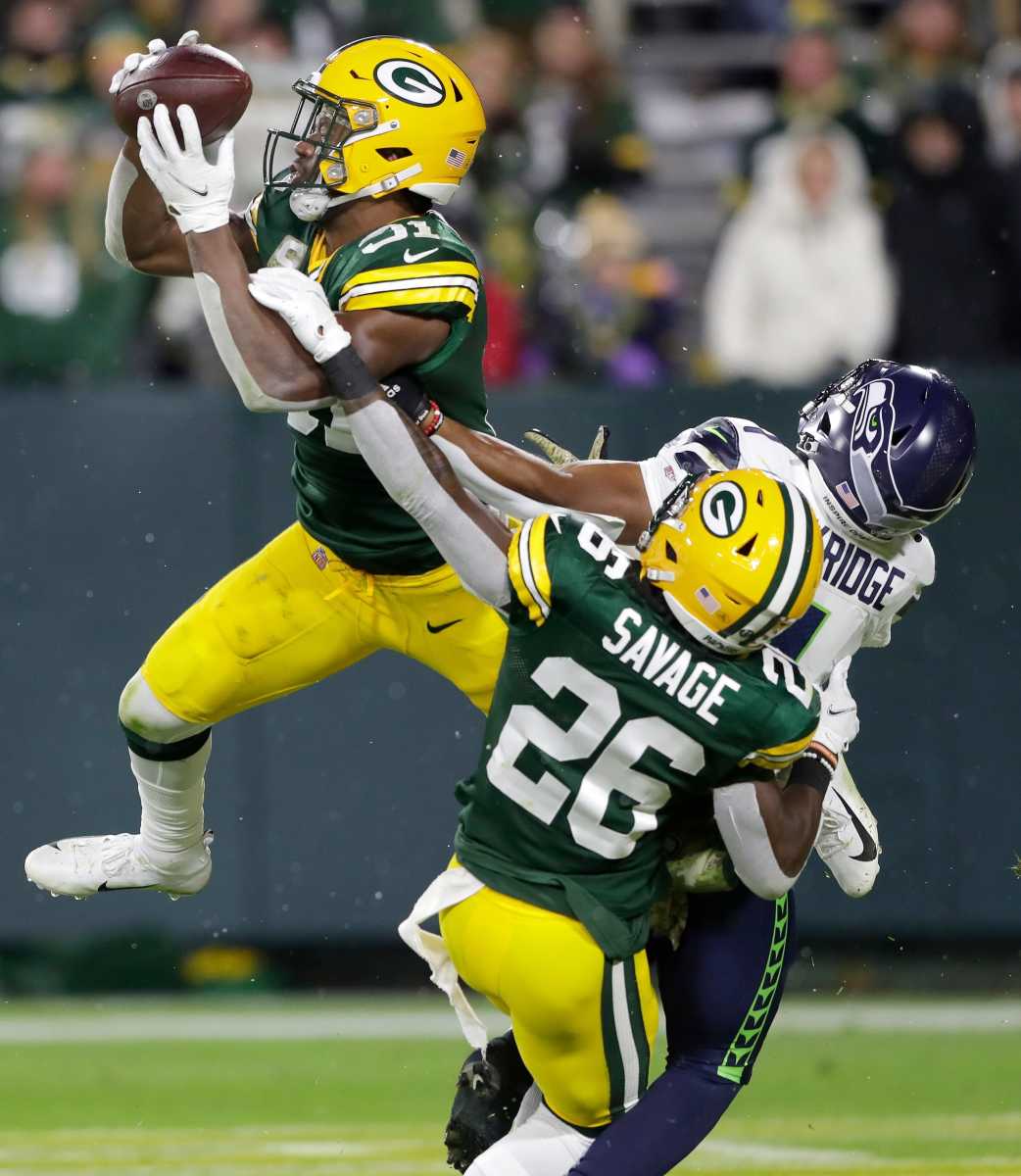
Amos started all 17 games and led the defense with 1,048 snaps. Mr. Consistency was second on the team with 94 tackles, tied for third with two interceptions and fourth with eight passes defensed. He’s in the right place at the right time every time, it seems.
SIS charged him with 29-of-48 passing (60.4 percent) for 281 yards with five touchdowns. While he dropped two picks, he had a big one at the goal line to keep the 49ers from scoring during the playoff game. Of 64 safeties with at least 50 percent playing time, Amos ranked sixth with a missed-tackle rate of 6.1 percent (six misses), according to PFF.
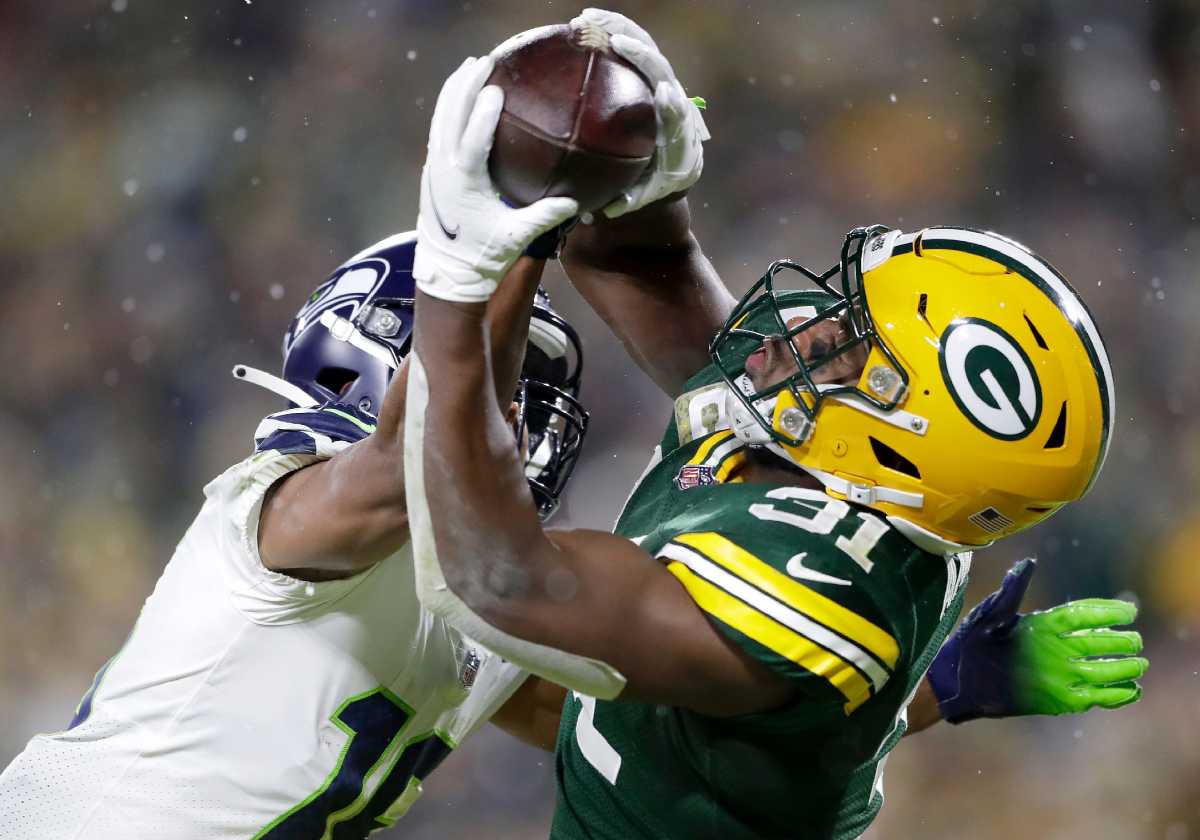
Amos will be entering his final season under contract. With last year’s restructure, his cap charge will be up to a lofty $11.98 million. The Packers can move on and save $4.65 million but it’s not as if there’s a young replacement waiting in the wings. He’ll turn 29 in April. An extension to save against the cap seems in order.
Grade: B-plus.
Darnell Savage ($3.41 million cap charge; ranking No. 29 among safeties)
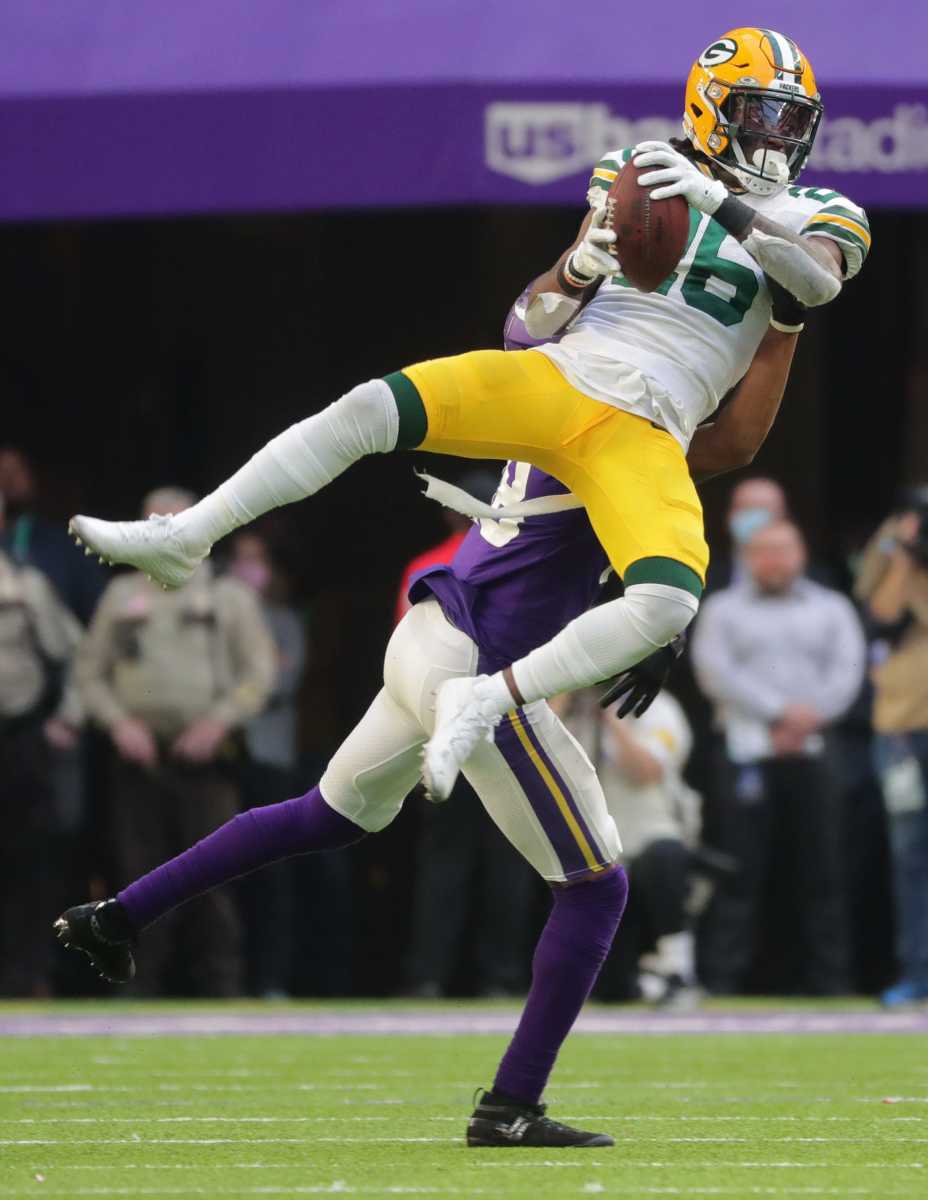
Savage started all 17 games and was second on the defense with 1,038 snaps. He finished fourth on the team with 63 tackles, tied for third with two interceptions and third with nine passes defensed. As was the case with Amos, he neither forced nor recovered a fumble.
SIS charged him with 22-of-37 passing (59.5 percent) for 320 yards. He gave up six touchdowns – including two vs. Baltimore, one vs. Cleveland and one vs. Minnesota in consecutive games down the stretch. Among his three dropped interception were two opportunities at Minnesota. Of 64 safeties with at least 50 percent playing time, Savage ranked 58th with a missed-tackle rate of 16.9 percent (12 misses), according to PFF. He’s missed 42 tackles in three seasons while Amos has missed 20.
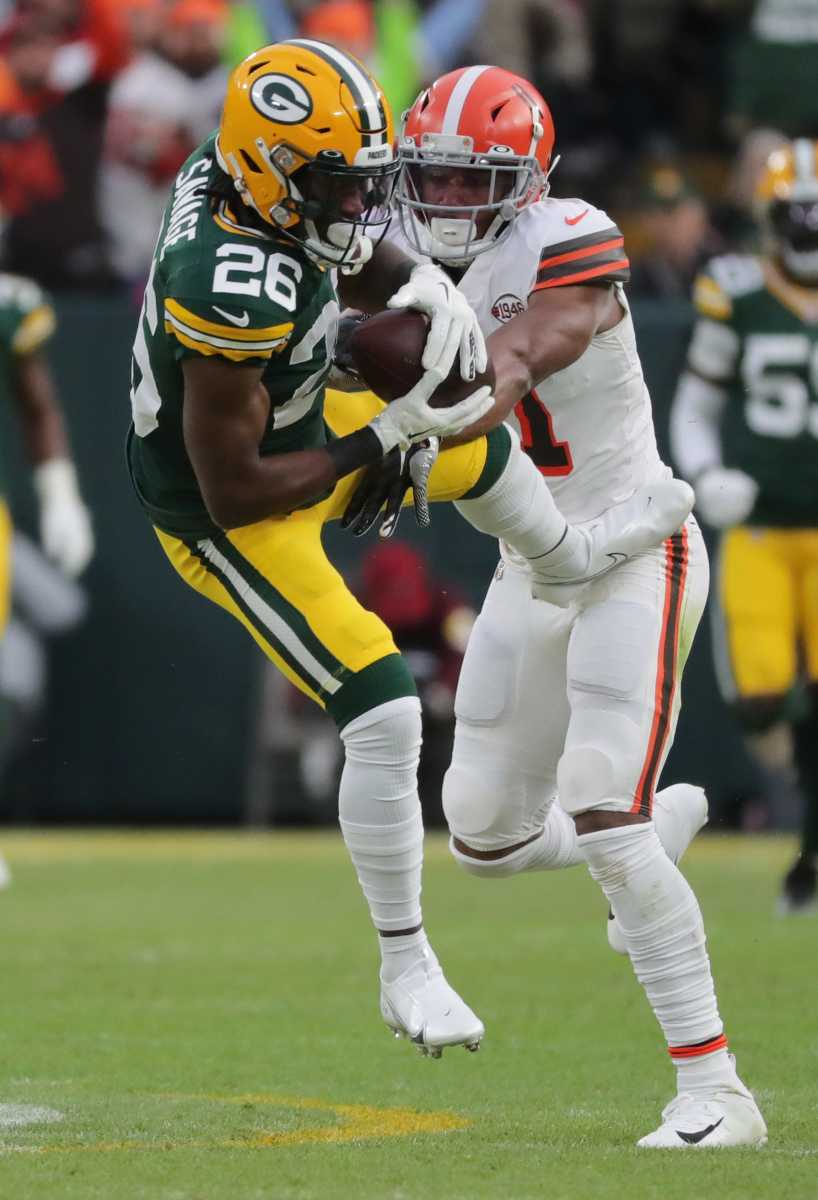
Savage will be entering Year 4 under contract. The team can trigger the fifth-year option if it chooses. Will it? Savage has turned in some strong performances and is an above-average starter but he always leaves you wanting more.
Grade: C.
Vernon Scott ($800,922 cap charge; ranking No. 121 among safeties)
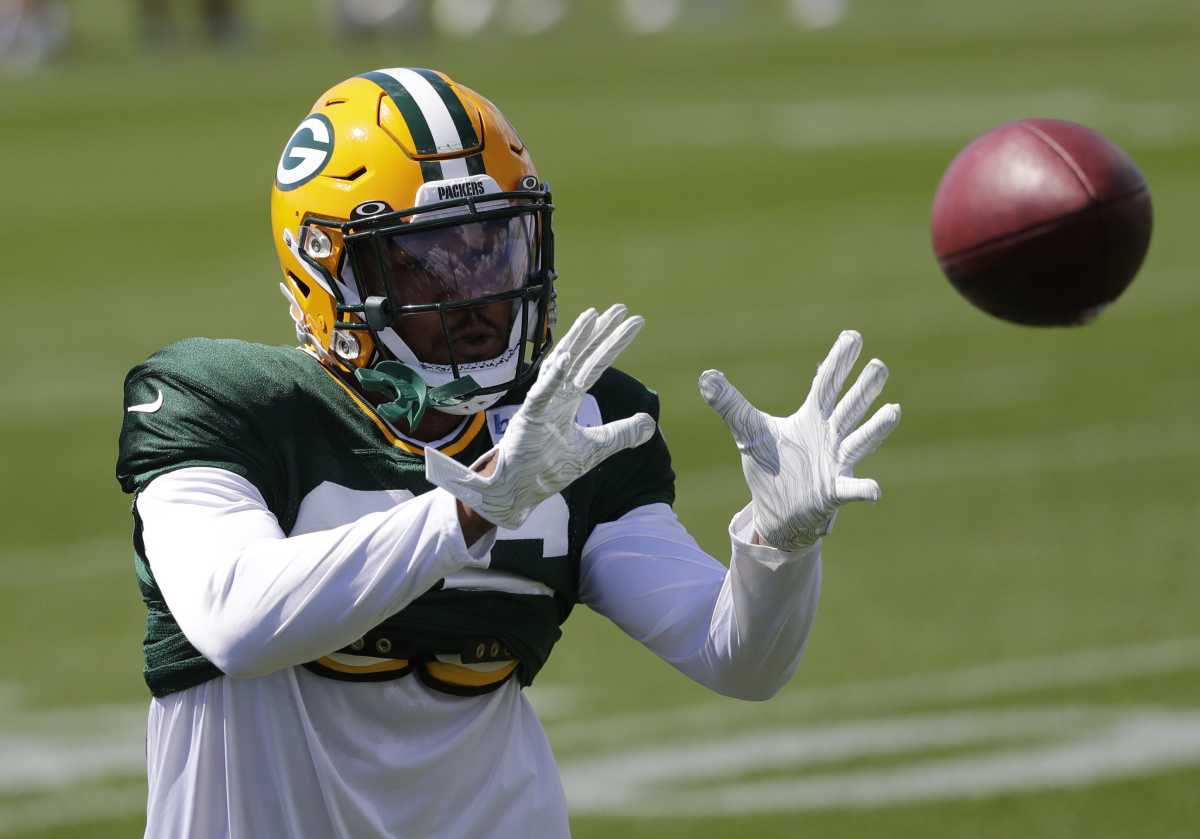
A seventh-round pick in 2020, Scott was expected to compete for playing time this summer. Instead, he was beaten out by Henry Black and barely played. In three games, he played zero snaps on defense and 17 snaps on special teams. He contributed one tackle on special teams. If Scott wasn’t good enough to play on these special teams, what does that say about his future in the NFL?
Grade: F.
Henry Black ($780,000 cap charge; ranking No. 124 among safeties)
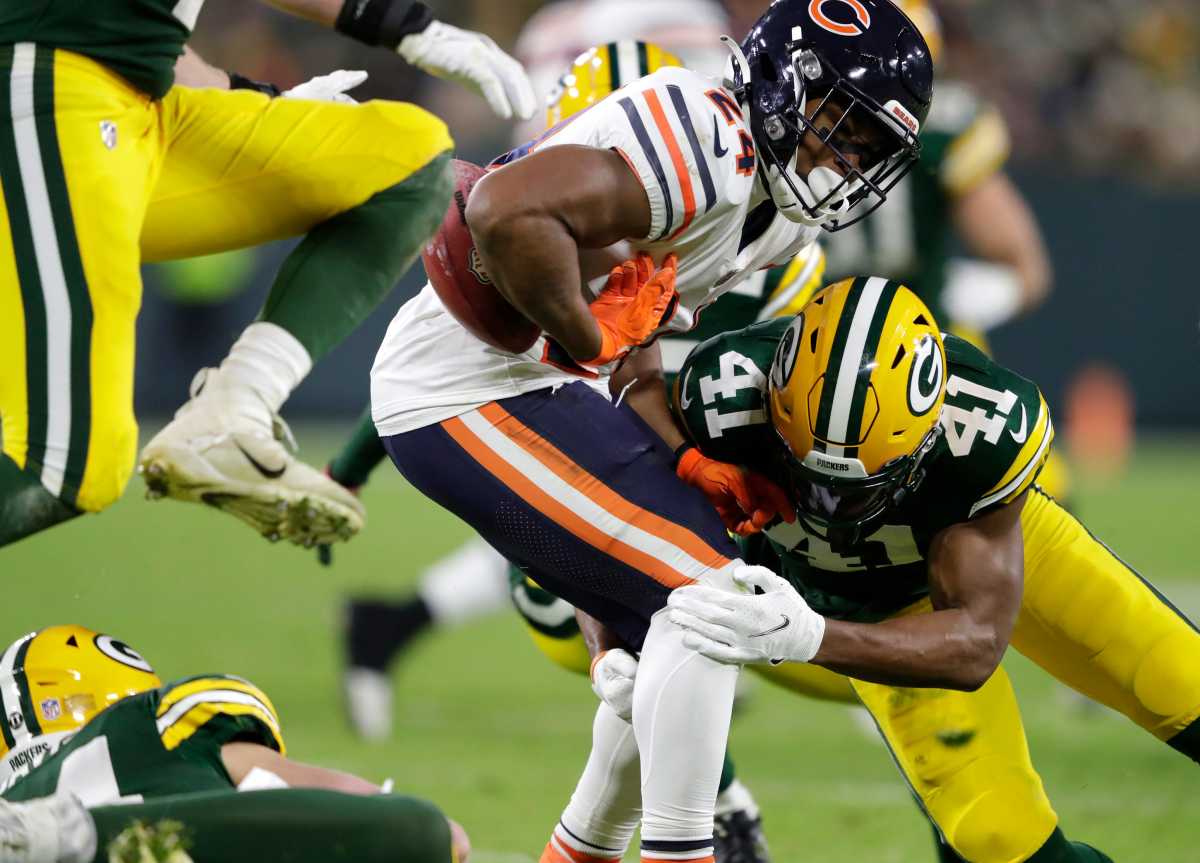
It was Black, an undrafted free agent in 2020, who beat out Scott for playing time as the dime defensive back. In 17 games, Black played 262 snaps on defense and 315 snaps on special teams, that latter figure ranking second on the team. On defense, he had 24 tackles, one interception (at Arizona) and two passes defensed. PFF charged with him with six missed tackles. That’s as many as Amos, who had 93 tackles. SIS charged him with 13-of-19 passing (68.4 percent) for 200 yards. He gave up touchdowns vs. Chicago and Minnesota late in the season.
On special teams, he led the way with 14 tackles and was probably the unit’s best player. However, if he would have stayed in to protect rather than run out on coverage as the personal protector, the season-killing blocked punt might not have happened and the Packers might have been playing next week.
Grade: C-minus.
Sean Davis $146,667 cap charge; ranking No. 178 among safeties)
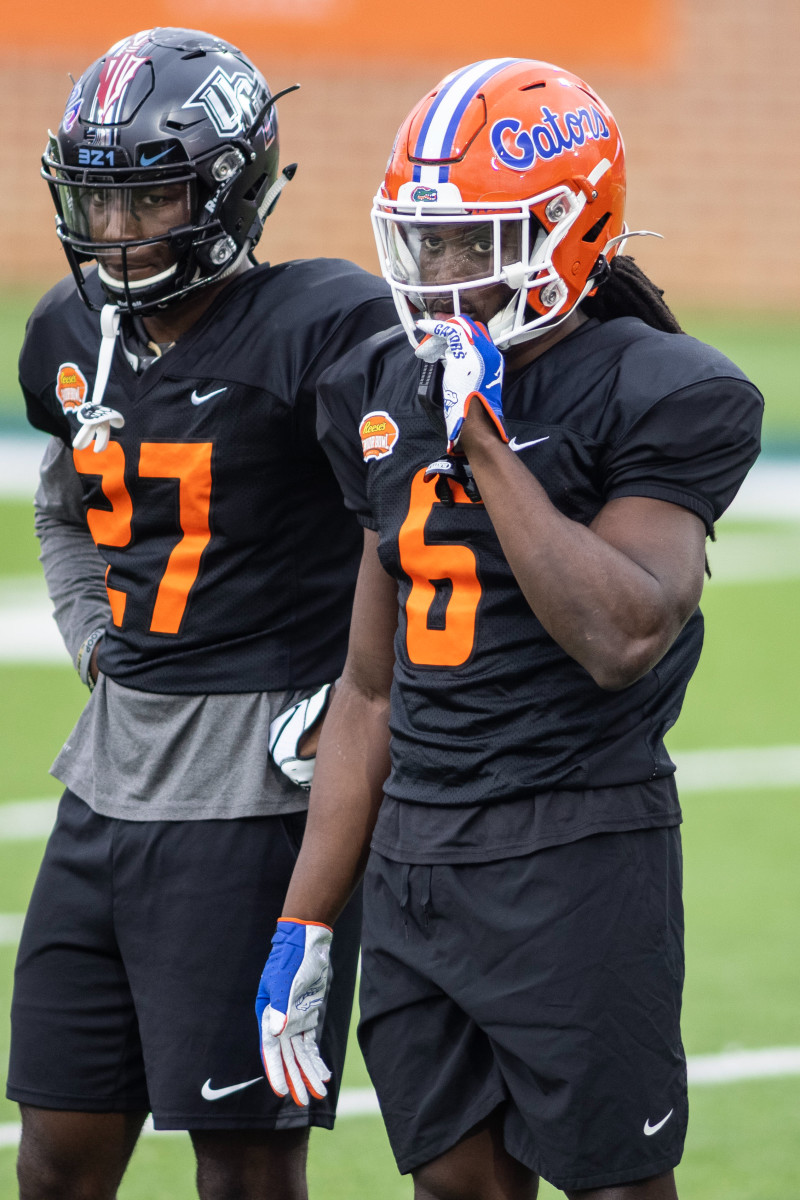
Davis was signed to the practice squad in September and promoted to the 53 on Dec. 18. He was a fifth-round pick in this year’s draft by the Indianapolis Colts out of the University of Florida. In 37 career games that include 16 starts, Davis tallied five interceptions, 15 passes defensed and 124 tackles. As a senior, he played in seven games (missed five due to injuries) and had two interceptions. In his one game, he played nine snaps on special teams against Cleveland and had one assisted tackle.
Grade: F.
Grading the Specialists
K Mason Crosby ($3.16 million cap charge; ranking No. 10 among kickers)
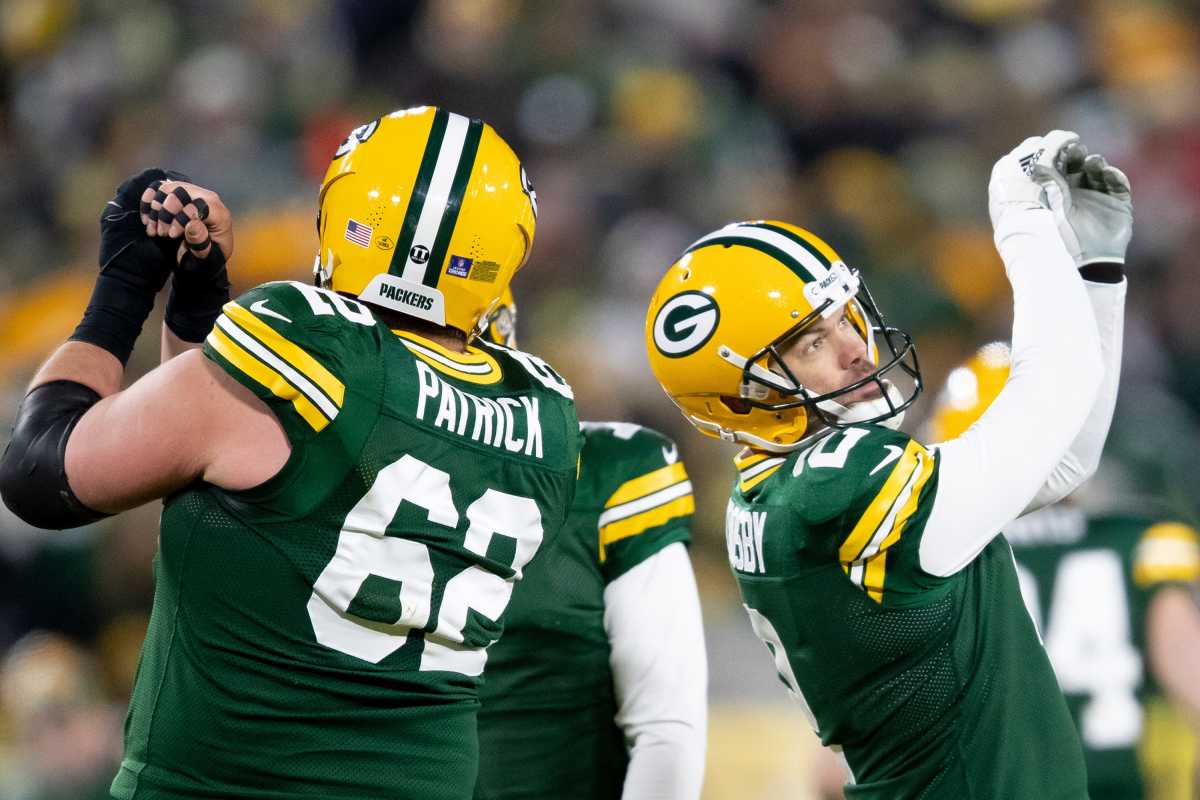
Crosby missed two field goals in 2019. He didn’t miss any in 2020. His red-hot kicking continued into the season at San Francisco in Week 3 with a 54-yarder in the first quarter and a 51-yarder to win the game.
But, with changes in the snapper-holder operation, Crosby went into a funk. He missed kicks because of bad snaps, holds and protection. When the operation improved, Crosby did not. Among kickers with at least 20 field-goal attempts, his 73.5 percent success rate was next-to-last in the league. Only his 2012 season was worse from an accuracy perspective. Due in part to age and late-season games in the cold, his touchback percentage on kickoffs ranked seventh from the bottom.
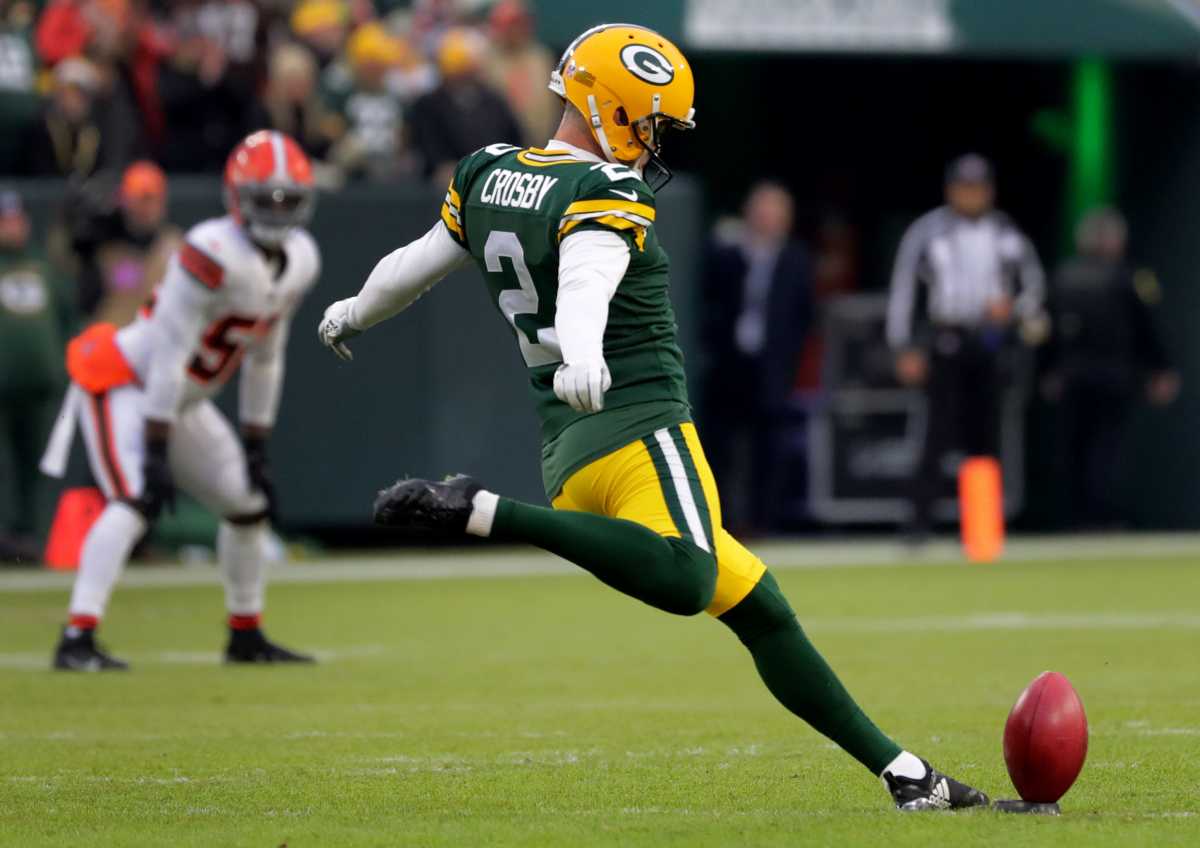
A restructured contract cut Crosby’s cap charge for 2021 but bumped it to $4.375 million for 2022. The Packers could move on and save $2.395 million for next season but incur dead-money charges through 2025. He’ll turn 38 just before the start of the season.
Grade: F.
P Corey Bojorquez ($1.02 million cap charge; ranking No. 19 among punters)
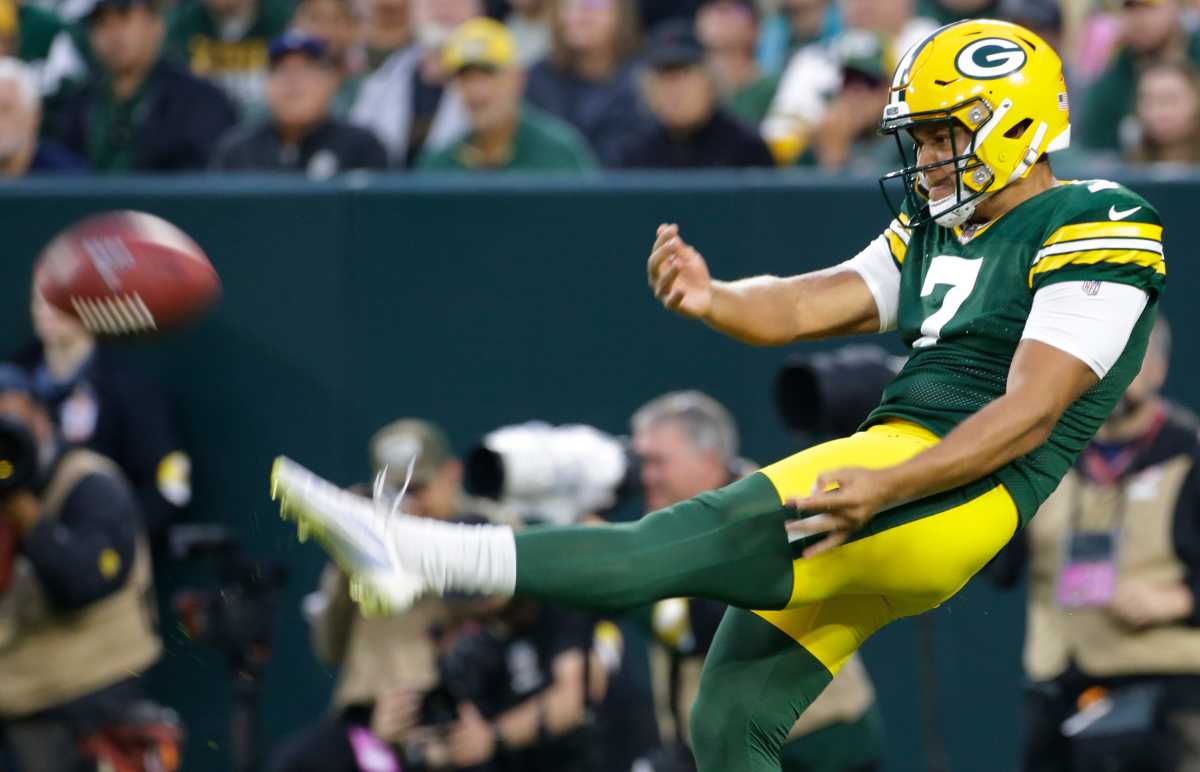
Acquired in a trade with the Rams after final cuts, Bojorquez ranked 11th with a 46.5-yard average and 17th with a 40.0-yard net average. His 82-yard punt at Chicago gave him the NFL’s longest punt for a second consecutive season. He had 18 punts inside the 20 with four touchbacks. Those were all improvements over the man he replaced, 2018 fifth-round pick JK Scott.
Still, his season seems like a disappointment because of how it ended. Starting with Week 6 at Chicago through Week 11 at Minnesota, Bojorquez had six consecutive games with net averages of at least 45.7 yards. In Week 12 against the Rams, he had a net average of only 39.8 yards because he had three punts inside the 20. It was a punting clinic. It all went off the rails in Week 14 against Chicago, with a four-game stretch with nets of 10.0, 42.0, 41.8 and 21.5 yards. Too many kicks either went straight down the middle of the field or were shanked out of bounds.
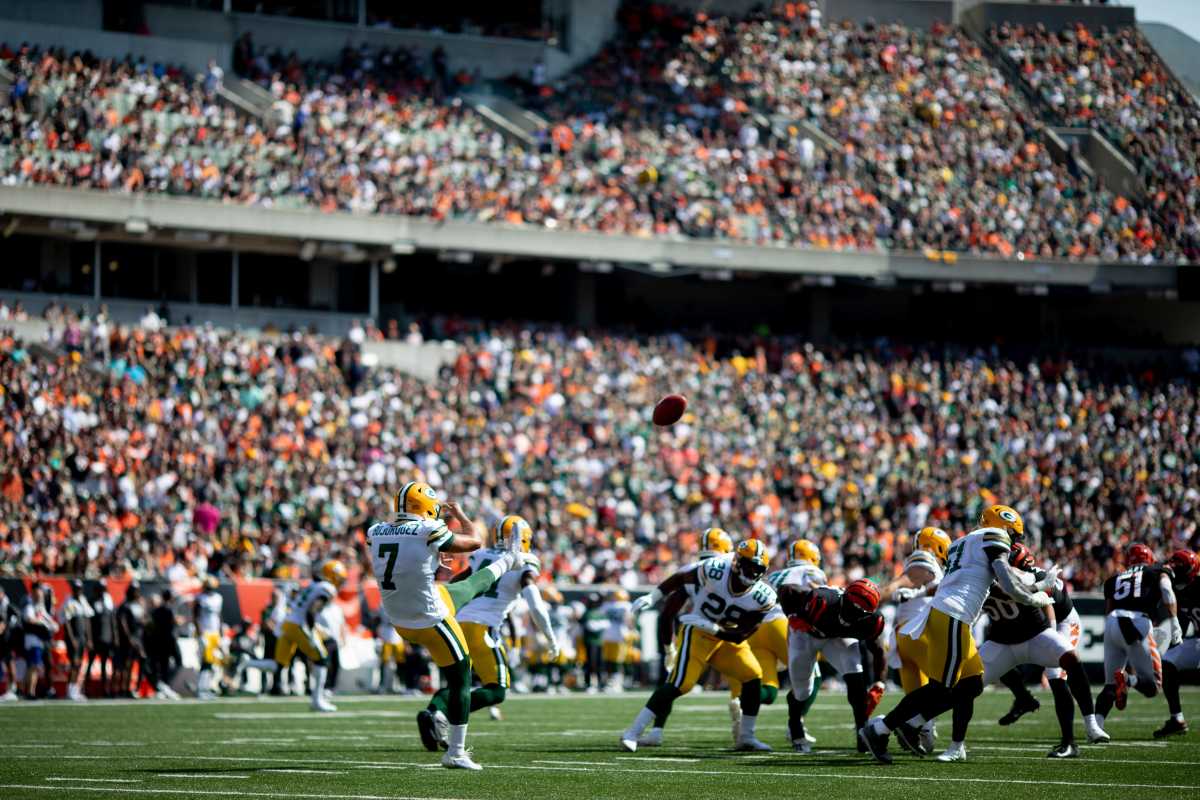
Punting is only part of the job. He’s also got to be a flawless holder for Crosby. There were some real struggles, though he was pretty solid down the stretch aside from a dropped hold in the bitter cold against Minnesota in Week 17.
Bojorquez will be an unrestricted free agent this coming offseason. With a league-best 50.8 average in 2020 and his mostly solid performance in 2021, he probably won’t be cheap.
Grade: C.
LS Steven Wirtel ($366,667 cap charge; ranking No. 33 among long snappers)
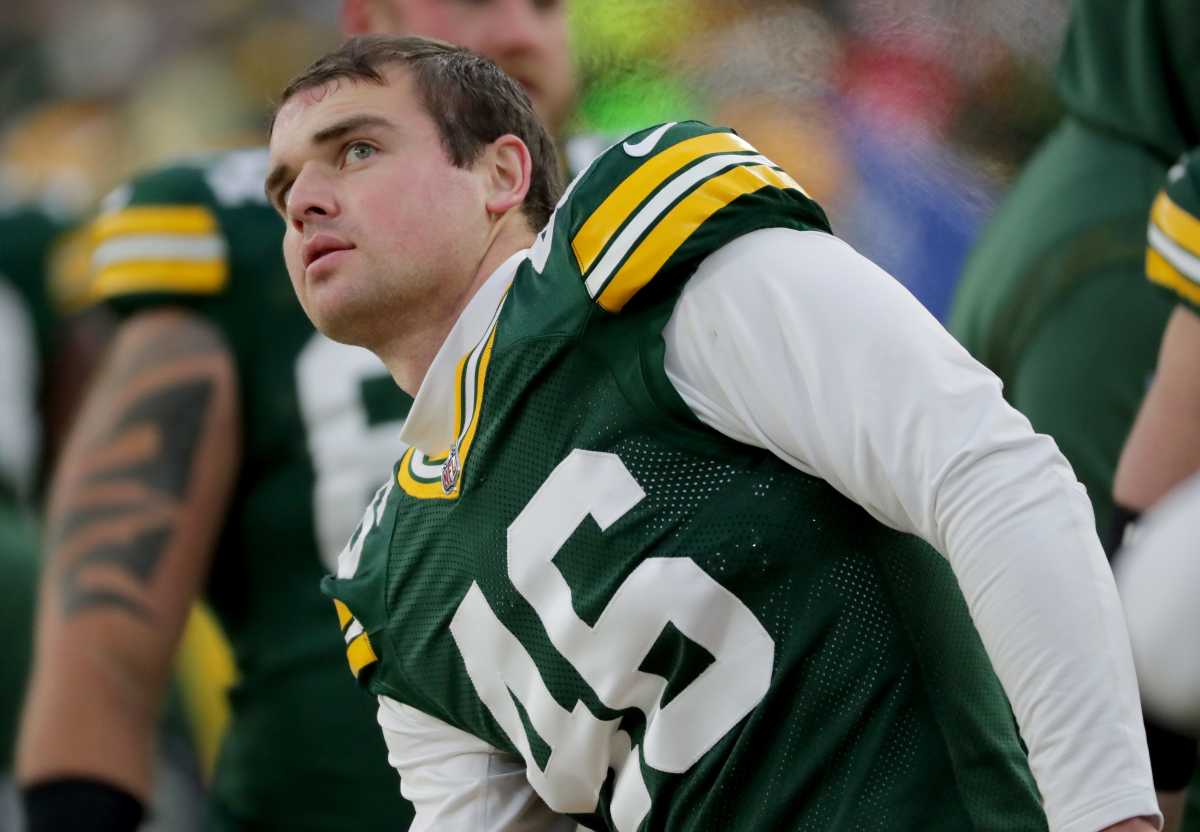
The Packers at midseason finally parted ways with 2018 seventh-round pick Hunter Bradley. Bradley was consistently inconsistent during his three-plus seasons but Wirtel wasn’t appreciably better. His snaps were never truly awful but the best snappers can spin it so perfectly that the holder doesn’t need to adjust the ball. He lacked that kind of precision. Wirtel got steam-rolled on the fateful blocked punt that doomed Green Bay in the playoff game.
Take them for what they’re worth, but Pro Football Focus grades long snappers. Bradley was the fourth-worst in the league and Wirtel was the third-worst.
The Packers don’t really have a problem finding long snappers. They’ve actually done well in that regard. They just have an impossible time in realizing they’ve found them. Five former Packers were full-time snappers this season. The Packers drafted Clark Harris (Bengals) in 2007, and signed J.J. Jansen (Panthers) in 2008, Rick Lovato (Eagles) in 2015, Taybor Pepper (49ers) twice in 2017 and Zach Triner (Buccaneers) in 2017 and training camp in 2018.
Grade: D.
